
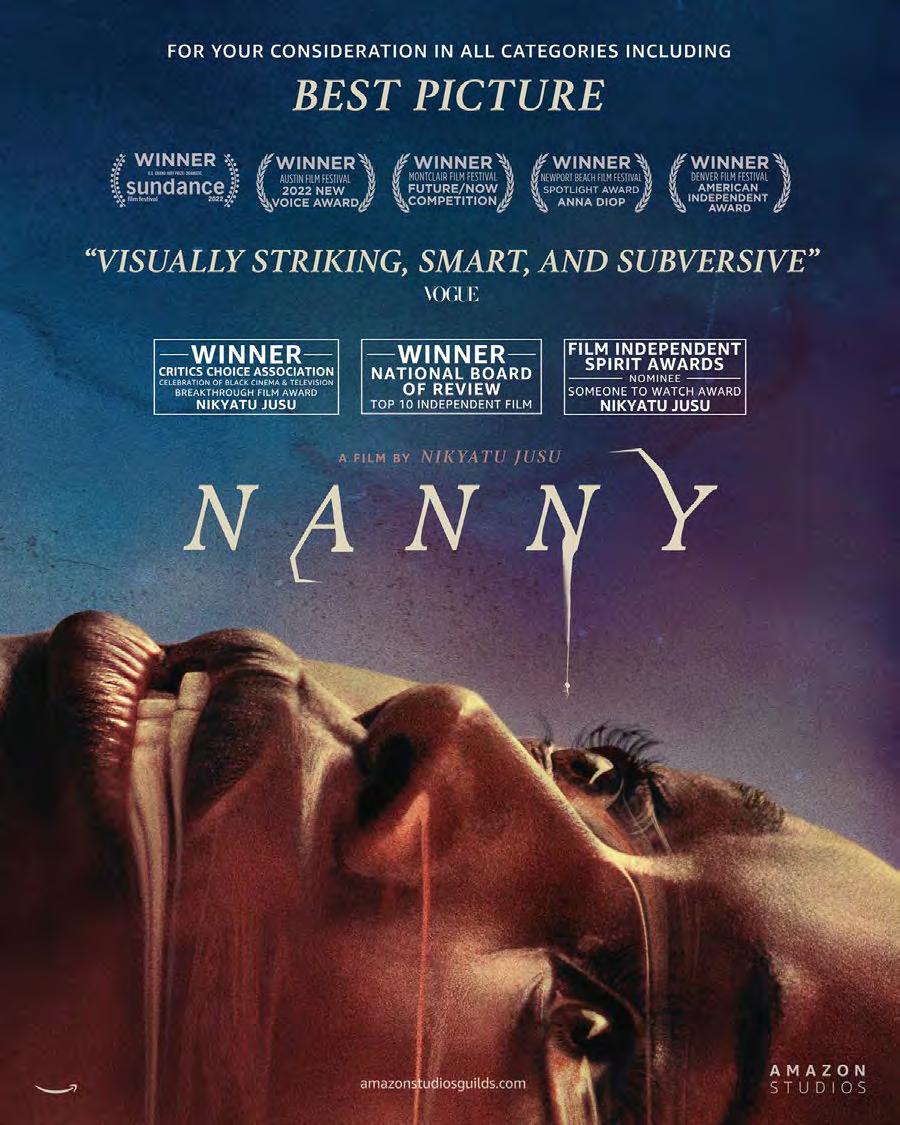
CO-EDITORS-IN-CHIEF
AWARDS
COLUMNIST & INTERNATIONAL EDITOR-AT-LARGE Baz Bamigboye
EXECUTIVE MANAGING EDITOR Patrick Hipes
EDITORIAL DIRECTOR & BOX OFFICE EDITOR Anthony D’Alessandro
SENIOR
SENIOR
MANAGING
DEPUTY
SENIOR
POLITICAL EDITOR Ted Johnson
INTERNATIONAL TELEVISION EDITOR Max Goldbart
INTERNATIONAL FEATURES EDITOR Diana Lodderhose
INTERNATIONAL BOX OFFICE EDITOR & SENIOR CONTRIBUTOR Nancy Tartaglione
INTERNATIONAL TELEVISION CO-EDITOR Jesse Whittock
ASSOCIATE EDITOR & FILM WRITER Valerie Complex
ASSOCIATE EDITORS Greg Evans Bruce Haring
CONTRIBUTING EDITOR, ASIA Liz Shackleton
SENIOR TELEVISION REPORTER Rosy Cordero
SENIOR INTERNATIONAL FILM CORRESPONDENT Melanie Goodfellow
DEADLINE.COM
Breaking News Follow Deadline.com 24/7 for the latest breaking news in entertainment.
Sign up for Alerts & Newsletters
Sign up for breaking news alerts and other Deadline newsletters at: deadline.com/newsletters
VIDEO SERIES
The Actor’s Side Meet some of the biggest and hardest working actors of today, who discuss their passion for their work in film and television. deadline.com/vcategory/theactors-side/
Behind the Lens
Explore the art and craft of directors from first-timers to veterans, and take a unique look into the world of filmmakers and their films. deadline.com/vcategory/ behind-the-lens/
The Film That Lit My Fuse
Get an insight into the creative ambitions, formative influences, and inspirations that fuelled today’s greatest screen artists. deadline.com/vcategory/thefilm-that-lit-my-fuse/
PODCASTS
20 Questions on Deadline
Antonia Blyth gets personal with famous names from both film and television. deadline.com/tag/ 20-questions-podcast/
Scene 2 Seen
Valerie Complex offers a platform for up-and-comers and established voices. deadline.com/tag/ scene-2-seen-podcast/
Crew Call
Anthony D’Alessandro focuses on the contenders in the belowthe-line categories. deadline.com/tag/ crew-call-podcast/
SOCIAL MEDIA
Follow Deadline
Facebook.com/Deadline Instagram.com/Deadline Twitter.com/Deadline YouTube.com/Deadline TikTok.com/@Deadline
CHAIRMAN & CEO Jay Penske
VICE CHAIRMAN Gerry Byrne
CHIEF OPERATING OFFICER George Grobar
CHIEF ACCOUNTING OFFICER Sarlina See
CHIEF DIGITAL OFFICER Craig Perreault
EXECUTIVE VICE PRESIDENT, BUSINESS AFFAIRS & CHIEF LEGAL OFFICER Todd Greene
EXECUTIVE VICE PRESIDENT, OPERATIONS & FINANCE Paul Rainey
EXECUTIVE VICE PRESIDENT, OPERATIONS & FINANCE Tom Finn
EXECUTIVE VICE PRESIDENT, PRODUCT & ENGINEERING Jenny Connelly
MANAGING DIRECTOR, INTERNATIONAL MARKETS Debashish Ghosh
EVP, GM OF STRATEGIC INDUSTRY GROUP Dan Owen
SENIOR VICE PRESIDENT, SUBSCRIPTIONS David Roberson
SENIOR VICE PRESIDENT, DEPUTY GENERAL COUNSEL Judith R. Margolin
SENIOR VICE PRESIDENT, FINANCE Ken DelAlcazar
SENIOR VICE PRESIDENT, HUMAN RESOURCES Lauren Utecht
SENIOR VICE PRESIDENT, BUSINESS DEVELOPMENT Marissa O’Hare
SENIOR VICE PRESIDENT, CREATIVE Nelson Anderson
SENIOR VICE PRESIDENT, LICENSING & BRAND DEVELOPMENT Rachel Terrace
VICE PRESIDENT, ASSOCIATE GENERAL COUNSEL Adrian White
VICE PRESIDENT, HUMAN RESOURCES Anne Doyle
VICE PRESIDENT, REVENUE OPERATIONS Brian Levine
HEAD OF INDUSTRY, CPG AND HEALTH Brian Vrabel
VICE PRESIDENT, PUBLIC AFFAIRS & STRATEGY Brooke Jaffe
HEAD OF INDUSTRY, TECHNOLOGY Cassy Hough
VICE PRESIDENT, SEO Constance Ejuma
VICE PRESIDENT & ASSOCIATE GENERAL COUNSEL Dan Feinberg
HEAD OF LIVE EVENT PARTNERSHIPS Doug Bandes
VICE PRESIDENT, AUDIENCE MARKETING & SPECIAL PROJECTS Ellen Deally
VICE PRESIDENT, GLOBAL TAX Frank McCallick
VICE PRESIDENT, TECHNOLOGY Gabriel Koen
VICE PRESIDENT, E-COMMERCE Jamie Miles
HEAD OF INDUSTRY, TRAVEL Jennifer Garber
VICE PRESIDENT, ACQUISITIONS & OPERATIONS Jerry Ruiz
VICE PRESIDENT, PRODUCTION OPERATIONS Joni Antonacci
VICE PRESIDENT, FINANCE Karen Reed
VICE PRESIDENT, INFORMATION TECHNOLOGY Kay Swift
VICE PRESIDENT, HUMAN RESOURCES Keir McMullen
HEAD OF TALENT Marquetta Moore
HEAD OF AUTOMOTIVE INDUSTRY Matthew Cline
VICE PRESIDENT, STRATEGIC PLANNING & ACQUISITIONS Mike Ye
VICE PRESIDENT, PRODUCT DELIVERY Nici Catton
VICE PRESIDENT, CUSTOMER EXPERIENCE & MARKETING OPERATIONS Noemi Lazo
VICE PRESIDENT, ASSOCIATE GENERAL COUNSEL Sonal Jain
VICE PRESIDENT, ASSOCIATE GENERAL COUNSEL Victor Hendrickson
DEADLINE HOLLYWOOD IS OWNED AND PUBLISHED BY PENSKE MEDIA CORPORATION
Nellie Andreeva (Television) Mike Fleming Jr. (Film)
COLUMNIST & CHIEF FILM CRITIC Pete Hammond
EDITOR, LEGAL & TV CRITIC Dominic Patten
MANAGING EDITOR Denise Petski
EDITOR Erik Pedersen
MANAGING EDITOR Tom Tapp
TELEVISION EDITOR Peter White
INTERNATIONAL EDITOR Andreas Wiseman
BUSINESS EDITOR Dade Hayes EDITOR-AT-LARGE Peter Bart
FILM CRITIC & COLUMNIST Todd McCarthy EXECUTIVE EDITOR Michael Cieply
FILM WRITER Justin Kroll CO-BUSINESS EDITOR Jill Goldsmith LABOR EDITOR David Robb
FILM REPORTER Matt Grobar INTERNATIONAL FILM REPORTER Zac Ntim TELEVISION REPORTER Katie Campione NIGHTS AND WEEKENDS EDITOR Armando Tinoco PHOTO EDITOR Robert Lang PRESIDENT Stacey Farish EXECUTIVE AWARDS EDITOR Joe Utichi VICE PRESIDENT, CREATIVE Craig Edwards SENIOR AWARDS EDITOR Antonia Blyth TELEVISION EDITOR Lynette Rice FILM EDITOR Damon Wise DOCUMENTARY EDITOR Matthew Carey CRAFTS EDITOR Ryan Fleming PRODUCTION EDITOR David Morgan EDITORIAL ASSISTANT Destiny Jackson DIRECTOR, SOCIAL MEDIA Scott Shilstone DIRECTOR, EVENTS Sophie Hertz DIRECTOR, BRAND MARKETING Laureen O’Brien EVENTS MANAGER Allison DaQuila VIDEO MANAGER David Janove VIDEO PRODUCERS Benjamin Bloom Jade Collins Shane Whitaker DESIGNERS Catalina Castro Grant Dehner SOCIAL MEDIA COORDINATOR Natalie Sitek EVENTS COORDINATOR Dena Nguyen DESIGN/PRODUCTION COORDINATOR Paige Petersen CHIEF PHOTOGRAPHER Michael Buckner SENIOR VICE PRESIDENT, ASSOCIATE PUBLISHER Kasey Champion SENIOR VICE PRESIDENT, GLOBAL BUSINESS DEVELOPMENT & STRATEGIC PARTNERSHIPS Céline Rotterman VICE PRESIDENT, ENTERTAINMENT Caren Gibbens VICE PRESIDENT, INTERNATIONAL SALES Patricia Arescy VICE PRESIDENT, SALES & EVENTS Tracy Kain SENIOR DIRECTOR, ENTERTAINMENT Brianna Corrado DIRECTOR, ENTERTAINMENT London Sanders DIRECTOR, DIGITAL SALES PLANNING Letitia Buchan SENIOR DIGITAL ACCOUNT MANAGER Cherise Williams
PLANNERS Luke Licata Kristen Stephens SALES ASSISTANT Daryl Jeffery PRODUCTION DIRECTOR Natalie Longman DISTRIBUTION DIRECTOR Michael Petre PRODUCTION MANAGER Andrea Wynnyk
SALES

First Take 4 PAUL MESCAL: Dad and loving it: the Irish “co-star” of indie hit Aftersun 8 QUICK SHOTS: Walking the talk in She Said and dressing for duress in Women Talking 10 THE BIG REVEAL: Top Gun: Maverick director Joseph Kosinski’s personal stories behind the film. 14 INTERNATIONAL: How Ireland’s The Quiet Girl became a success. 18 DOCUMENTARY: Put your arms around the world at Oscar time. 22 FRESH FACE: All Quiet on the Western Front star Felix Kammerer. Cover Story 24 TRIO OF LIFE: Alfonso Cuarón, Alejandro G. Iñárittu and Guillermo del Toro get the old gang back together. Dialogue 36 BARRY KEOGHAN 38 CHINONYE CHUKWU 40 GRETA GERWIG 42 PARK CHAN-WOOK 46 JESSICA CHASTAIN 48 EDDIE REDMAYNE 50 JENNY SLATE 54 RYAN COOGLER 56 KATE HUDSON 58 BITATÉ URU EU WAU WAU 62 CAREY MULLIGAN 64 SARAH POLLEY 66 PAUL DANO Craft Services 70 CUTTING TO THE CHASE: Three editors on getting historical for The Woman King, All Quiet on the Western Front and Emancipation The Partnership 76 JAMES GRAY & JEREMY STRONG: New York state of mind: the making of Armageddon Time ON THE COVER: Alfonso Cuarón, Alejandro G. Iñárritu and Guillermo del Toro photographed exclusively for Deadline by Josh Telles.
FOR DEADLINE CALL SHEET
MICHAEL
BUCKNER
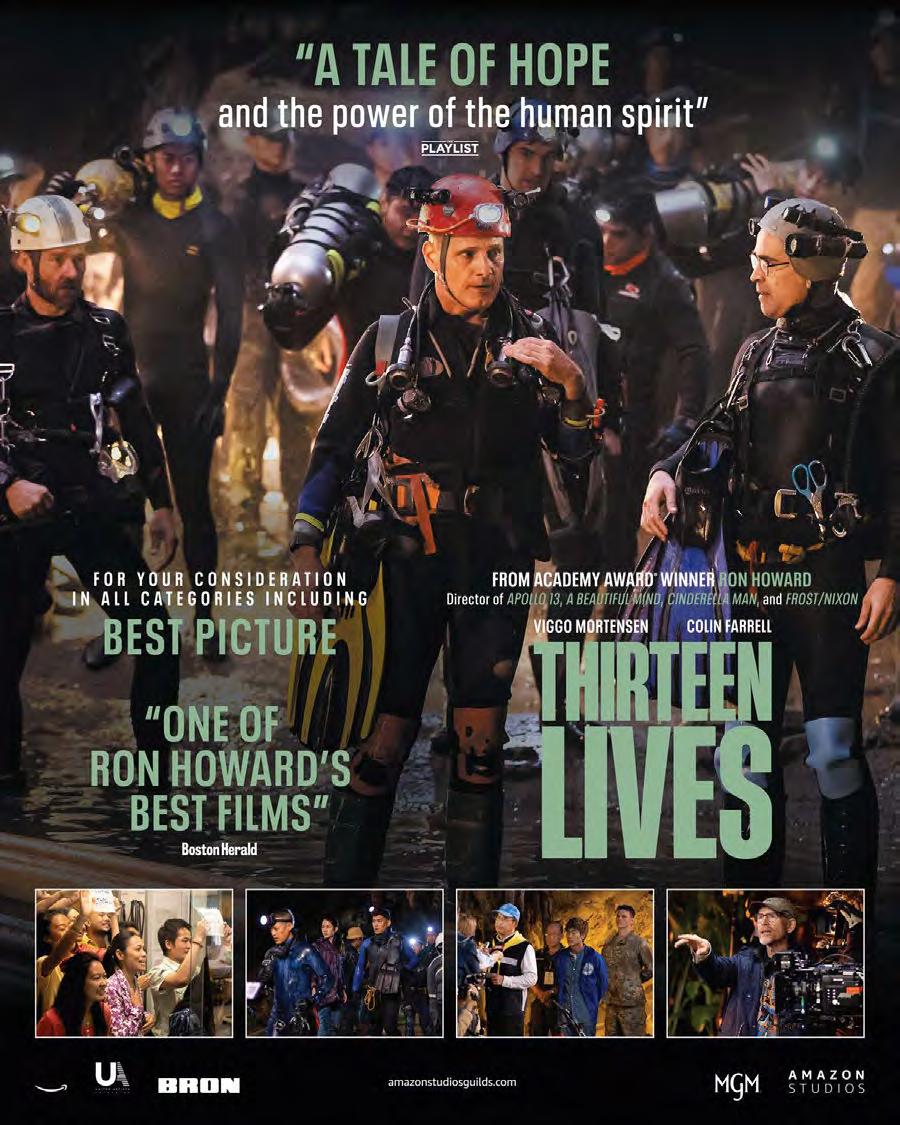
F T I A
R K
S E
THE PARENT TRAP
How Paul Mescal tapped into the joy and pain of young fatherhood in indie hit Aftersun
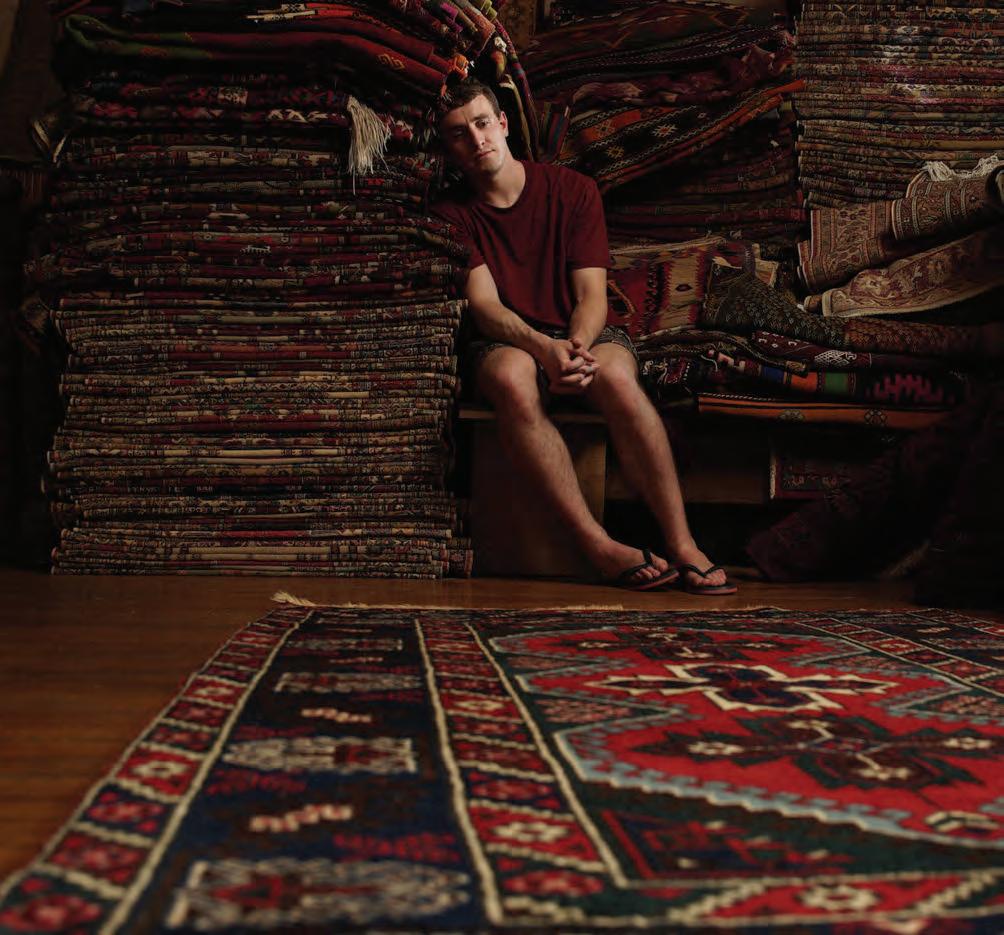 By Baz Bamigboye
By Baz Bamigboye
T
QUICK SHOTS 8 | THE BIG REVEAL: JOSEPH KOSINSKI 10 | FRESH FACE: FELIX KAMMERER 22
4 DEADLINE.COM/AWARDSLINE
COURTESY
OF A24/ENDA BOWE/HULU/NETFLIX
Paul Mescal enters the north London cafe having trudged a short distance through the snow from his gym. Heads turn, but Mescal is oblivious. He shakes himself out of a hooded coat then nonchalantly removes a sweater to reveal a ribbed torso sheathed in a white T-shirt. More stares. The star of Aftersun, Scottish director Charlotte Wells’s tender visual poem about a father and daughter, takes a seat and rubs his tummy. In that moment it’s all too easy to compare him to Marlon Brando, with the tight-ish whitey shirt and all that.
As it happens, the Irish-born actor is playing one of Brando’s signature roles: the brutish but passionate Stanley Kowalski in Tennessee Williams’ landmark play A Streetcar Named Desire, at the Almeida Theatre, a fiveminute walk away from where we’re breakfasting. The revival has been on Mescal’s slate for three years, delayed by Covid and scheduling issues. Early previews merged with an extension of rehearsals due to Lydia Wilson’s withdrawal from the production for health reasons, and she’s since been replaced as Blanche DuBois by Patsy Ferran, a frequent collaborator of director Rebecca Frecknall.
Now in his late twenties, Mescal has been on a roll since the BBC adaptation of Sally Rooney’s 2018 novel Normal People was released on BBC TV and Hulu at the height of the pandemic. Audiences lapped up the painfully honest relationship drama from the comfort of their sofas. The series made Mescal an overnight star, hurling him up the proverbial ladder and winning him the TV BAFTA for leading actor. That capital was used wisely, introducing him into the world of features with a small but significant role in Maggie Gyllenhaal’s acclaimed directorial debut The Lost Daughter as the guileless beach bartender who draws the film’s aloof, prickly protagonist


(Olivia Colman) out of her shell.
It was while preparing to shoot his next film, God’s Creatures, with Emily Watson in Donegal, Ireland, that Mescal got wind of Wells’ Aftersun. His agents, Lara
Normal People
Beach at Curtis Brown and CAA’s Zach Kaplan, were excited about the story of a young, separated father and his pre-teen daughter holidaying at a Turkish resort. The tale, perhaps a distorted memory of a vulnerable father’s unravelling, unfolds through the young girl’s eyes. Mescal pushed to meet Wells, reasoning “any actor who was reading it was gonna want to do it.”
He auditioned for the part of the father, Calum, then did a chemistry read with 12-year-old Frankie Corio, already cast as the daughter, Sophie. This was the real test, he says, because the film “lives or dies”—notwithstanding Wells’ “wonderful script and direction”—on whether you believe in the two actors. Fortunately, he and Corio hit if off straight away. “She’s wild, wild, like Frankie is wild,” he says, his grin widening as he speaks.
For proof, Mescal proudly points to the British Independent Film Awards (AKA the BIFAs), where Aftersun
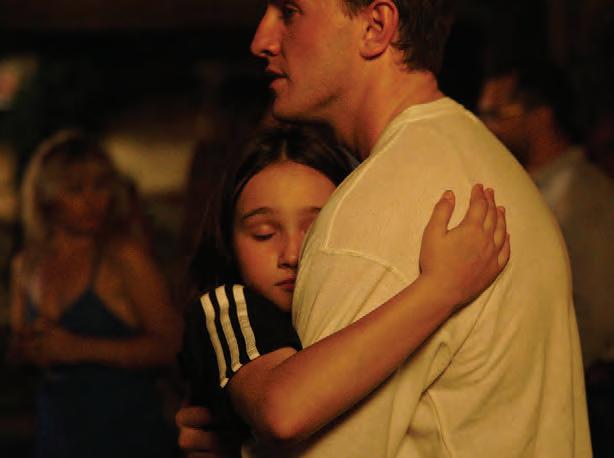
DEADLINE.COM/ AWARDSLINE 5
Frankie Corio as Sophie with Mescal as her father Calum in Aftersun.
The Lost Daughter
won seven awards, including Best British Independent Film and Best Director. At the pre-Christmas awards ceremony in London, Corio’s speech went viral after she playfully roasted Mescal in front of a roomful of industry people, yelling, “I was number one on the call sheet and he was number two—so he was the co-star and I was the star!”

Mescal laughs. “I don’t know if I’m particularly good with kids, generally speaking, but for some reason with Frankie, I found it easy. I can’t explain that other than probably, like, chemistry that exists between people. And we were lucky.”
Asked what poetry might best connect to the film, Mescal cites Thomas Lux’s “My Father Whistled”, which Lux dedicated as “a love poem to my father”. He then recites a line from another poem about a daughter teething for the first time. “It’s so tender,” he says softly. But it’s perhaps Barry Jenkins, one of the film’s producers via his PASTEL production company, who articulated the film’s emotional core more succinctly in The New York Times when he described Calum, a loving but emotionally ill-equipped young man clearly buckling under the pressures of parenthood, as “walking through a world of quiet anguish”.

Mescal nods his head in agreement. “I think it’s spot on,” he says. “I don’t think there’s anything particularly interesting about watching somebody suffering for 96 or 97 minutes. What I think makes it more effective is when you see them trying not to, and I think Calum really doesn’t want to have the set of feelings that he’s been given. And you see him fronting up against that on a daily basis. That, to me, is where… ” He pauses. “It devastates me, you know? It’s like, what is harder to watch than somebody who wants to be better?”
Talk turns to the topic of masculinity, about hiding emotions, and the way men are often slow to look after their mental health. “I think talking to someone
fine. But some people just can’t do it.”
about your feelings is a very, very modern thing,” he says. “Like, when I told my dad that I’d started going to therapy, he went, ‘What? What’s wrong with you?’” He laughs. “Because that’s, culturally, what you do: you go to a therapist if you’re mentally blocked. When I first started spending time in LA, I hadn’t started going to therapy properly. People would look at me like, ‘Why?’ And so, initially, I was defensive. I was like, ‘I’m fine.’ And of course that’s not the point. The point is, the way you look after your body should be the way that you look after…”
Your mind? Mescal nods. “You have to. You have to. I’m very grateful of the time that I’m in now and not 20 years ago, even, where that wasn’t really an option. It wasn’t that it didn’t exist, it just wasn’t really something that people would do. They would just bottle it up. And some people could do it and survive it and be
He says it’s vital that films like Aftersun exist to help trigger debate on subjects that are often put to one side. “There’s a catharsis in watching something that makes you feel,” he says, pointing out that the way Wells’s immersive film deliberately withholds some key information from the audience “forces them to think a little bit more”.
Going forward, Mescal is eager to take the next step, but he admits that it’s a process that scares him. “The thing I’m nervous about is... ” He pauses. “Being totally honest, I have a desire to be liked and for my work to be admired, but that’s not the reason I do it. But I do want to know what people think, and I’m nervous about the next steps. I don’t want to make just movies like Aftersun for the rest of my life. I know that will be the bedrock, but I want to have my cake and eat it. There are other things out there I want to do and try and taste, I’m just scared about being judged for either doing them or not doing them, which is ridiculous, because, so far, I don’t think I’ve made any film, or done any play or any piece of work yet, that I haven’t needed to make. And I don’t see that changing anytime soon.” ★
FT CLOSE-UP 6 DEADLINE.COM/ AWARDSLINE COURTESY OF A24
Aftersun
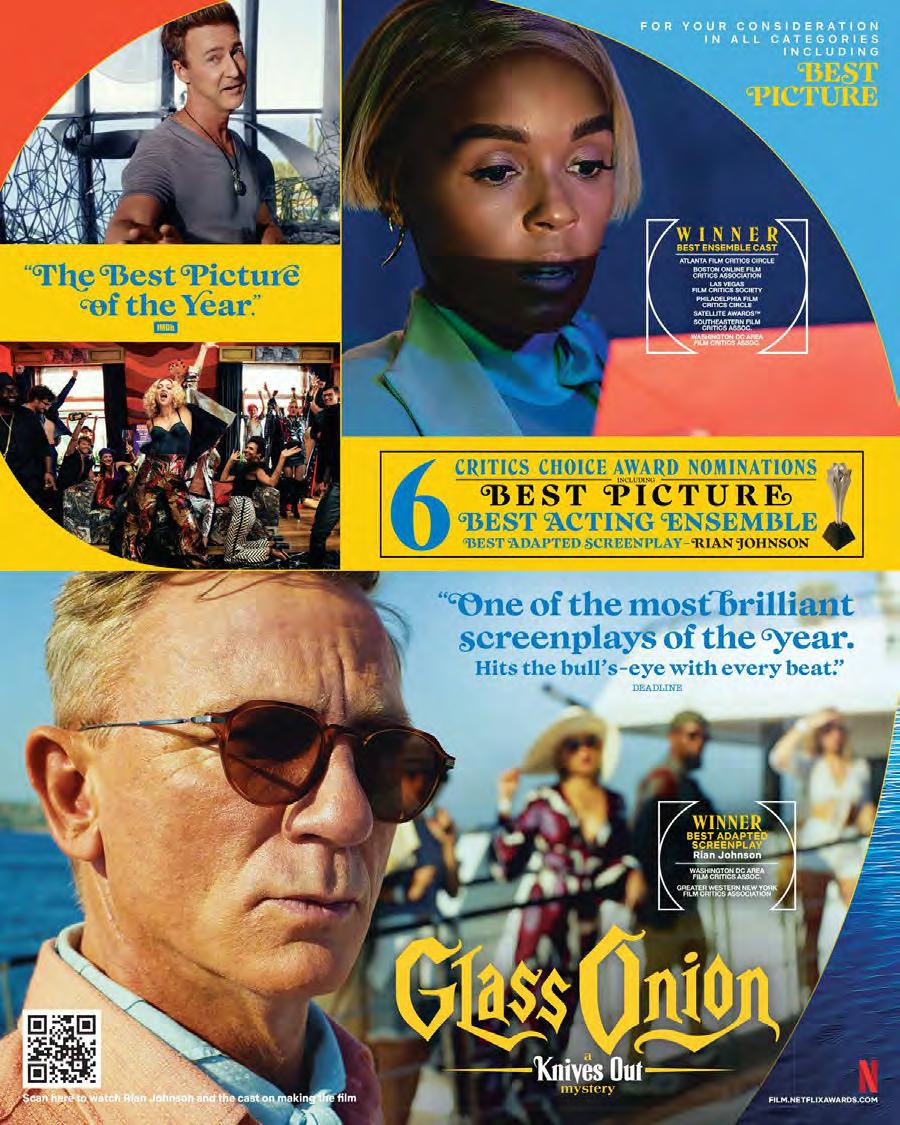
Talk
Cinematographer Natasha Braier using the camera as a “good listener” for She Said
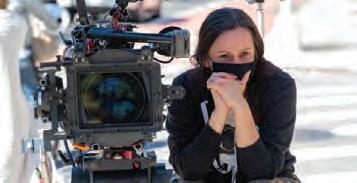
When she began her work on She Said, cinematographer Natasha Braier didn’t have a clear-cut idea of how to shoot a film that took place mostly over the phone. Then, she realized that the camerawork needed to follow the conversation, without becoming a part of it. “The camera had to be a listener, had to be a very good listener,” she explained. “You have to listen in a way that was close to them, but not too intrusive because some of these women that are delivering testimony in the film are actual survivors.”
She Said follows the New York Times reporters who broke the Harvey Weinstein story and ignited a movement that gave voice to the silenced victims of sexual assault.
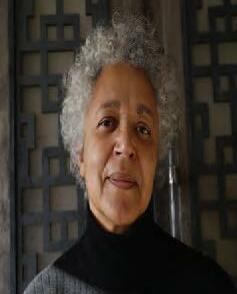
“As a cinematographer, it was important for me to create an environment where they could forget about the camera, where they wouldn’t feel like the camera is invading their personal space.”
Most of the film takes place in the offices of The New York Times, where the reporters are speaking to people over the phone.

While she would normally avoid scripts that didn’t have many visual possibilities, Braier says she felt the need to tell the story and make it visual. “With the phone calls, we try to introduce a lot of movement.
Fleming
Traditionally Modern
How costume designer
Quita Alfred honored Mennonite communities with accurate outfits

When costume designer Quita Alfred was approached by director Sarah Polley for Women Talking, Alfred was already living close to a Mennonite community
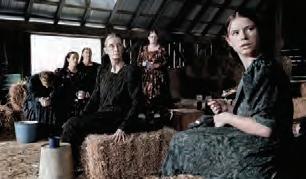
in Winnipeg. “I brought to Sarah the reality of Russian Mennonite plain dress,” she says. “I was able to buy the real things, the real fabrics from real vendors who sold exclusively to Mennonite communities and colonies.”
Using the same fabrics used in Mennonite communities today, Alfred says her costumes needed to be primarily made of polyester. “That’s what vendors have available
and it’s affordable in those remote communities and colonies. We used stronger colors and bolder patterns for characters of the same nature, but we couldn’t add a collar or change a neckline because that’s all very strictly traditional.” Though the traditional style of the clothing may seem simple, Alfred says the styles are “the culmination of 500 years of the Mennonites’ travels through Europe.” —Ryan Fleming
8 DEADLINE.COM/ AWARDSLINE 1 The Fabelmans ODDS 7/1 2 Everything Everywhere All at Once ODDS 15/2 3 Top Gun: Maverick ODDS 8/1 4 The Banshees of Inisherin ODDS 8/1 5 Avatar: The Way of Water ODDS 10/1 6 TÁR ODDS 21/2 7 Women Talking ODDS 12/1 8 Elvis ODDS 13/1 9 Glass Onion ODDS 28/1 10 The Woman King ODDS 30/1
&
Best Picture At press time, here is how GoldDerby’s experts ranked the Oscar chances in the Best Picture race. Get up-to-date rankings and make your own predictions at GoldDerby.com Charted Territory Walk
FT QUICK SHOTS JOJO WHILDEN/UNIVERSAL PICTURES/UNIVERSAL PICTURES/MICHAEL GIBSON/ORION PICTURES/COURTESY EVERETT COLLECTION
We try to capture them on the move from one place to another, or from their desk to a place where they can hear better… those movements really helped with those moments.” —Ryan
Costume designer Quita Alfred.
Natasha Braier on set.
Women Talking
She Said
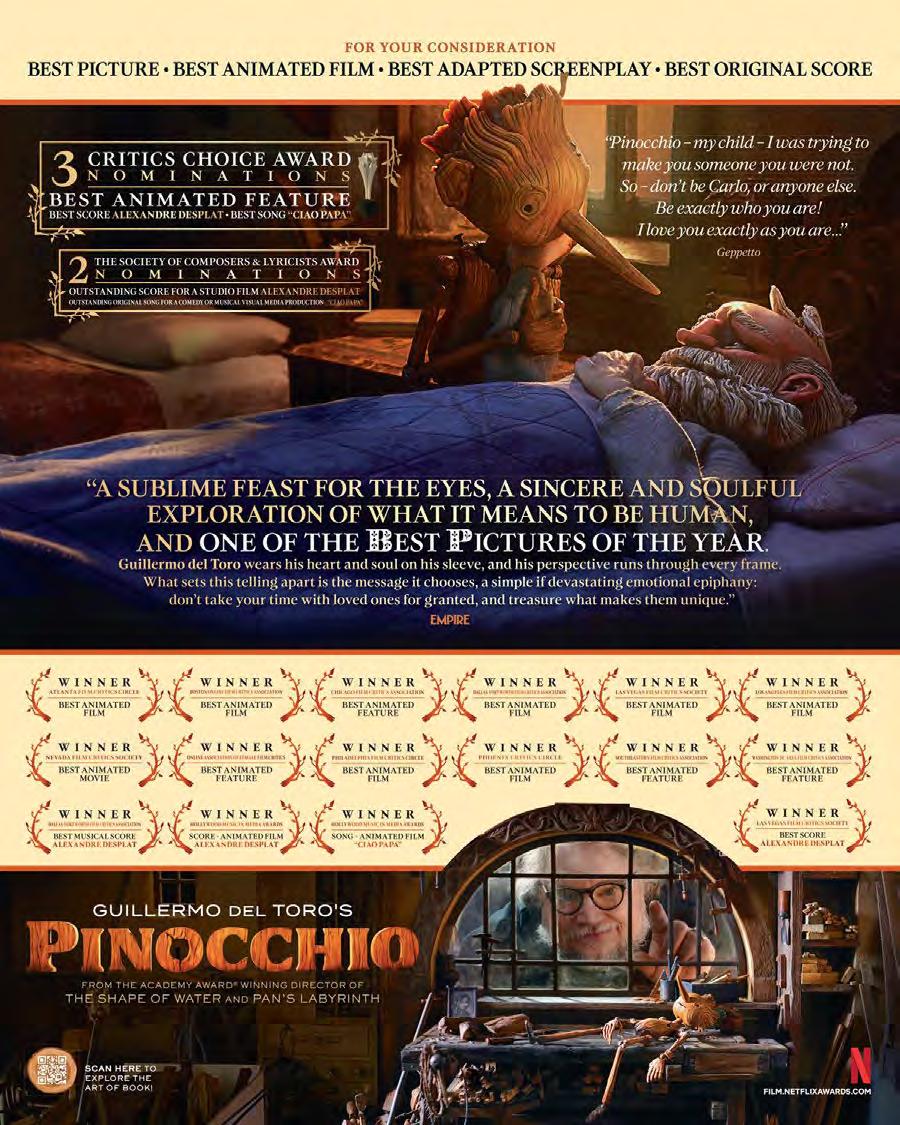
TOP GUN: MAVERICK
By Antonia Blyth
Tom really didn’t want to make another Top Gun and [director Tony Scott’s suicide] made it even less likely. I’m sure for him, that’s probably another reason why he wouldn’t ever consider going back. But I pitched the idea of this story being a reconciliation between him and Rooster set against this mission that would take Rooster into this very dangerous situation, that they’d end up together across enemy lines, having to resolve their differences and work together to get back home. As soon as I pitched that idea, I could just see the wheels in Tom’s head start to turn and all of a sudden, he had a very emotional reason, a hook back into this character, and a reason to come back, because I think in his mind it was like a one in a million shot that we would be able to get it right. He kept saying, “Joe, we got to hit a bullet with a bullet.” And that was his line on this movie. And so, I certainly heard that in my head every day as we were making the film. I think everyone who worked on this film felt like the bar was very high because we all were fans of the original.
Val Kilmer was the one who came up with the idea to make Iceman ill. I’ll never forget the shoot day with him and Tom. That scene with those two guys, two actors at their absolute best pulling off a scene like that, their first time together on camera since 1986. The friendship between the two, the mutual respect between the two of them as real people very much mirrors the characters. So, I think that’s why that scene lands so well. When we were putting the film together, we all wanted Val to be a part of it, but we just didn’t know what was possible. So, we had Val come in and said to him, “We’d love to have you in this film.” It was his idea to make it feel as authentic as possible. Once he had that idea, it opened up that whole storyline and just allowed us to tell this story in a better way. I was blown away when he offered that up. The scene was intense and very emotional, but when the camera wasn’t running, hearing him and Tom talk about the hijinks of making the first film and how much fun they had and the tricks they were pulling on each other, and just the craziness of that time and that era, was really fun to listen in on. You really felt that connective tissue to the past.
It was a very, very difficult world to live in and shoot a movie in. I spent two weeks on an aircraft carrier, and that was tough. And the fact that these people do that for six months or nine months without seeing their families, I was just really blown away by their sacrifice and what they give up to do that job for us. So, I think all of us on the crew walked away with even more respect for all the men and women out there. And that’s another reason we wanted this film to represent them in the best way possible. Because they worked so hard to help us capture all that. Every flight was flown by real Navy personnel. Every time you see Phoenix flying in the film, she’s being flown by a female aviator. The Navy has very different personnel than it did in 1986. The movie Top Gun: Maverick represents the Navy of today as opposed to the Navy of 1986. And that’s how far it’s come and how different it is now than then. So, it was good that our film was able to represent that in a really authentic way.
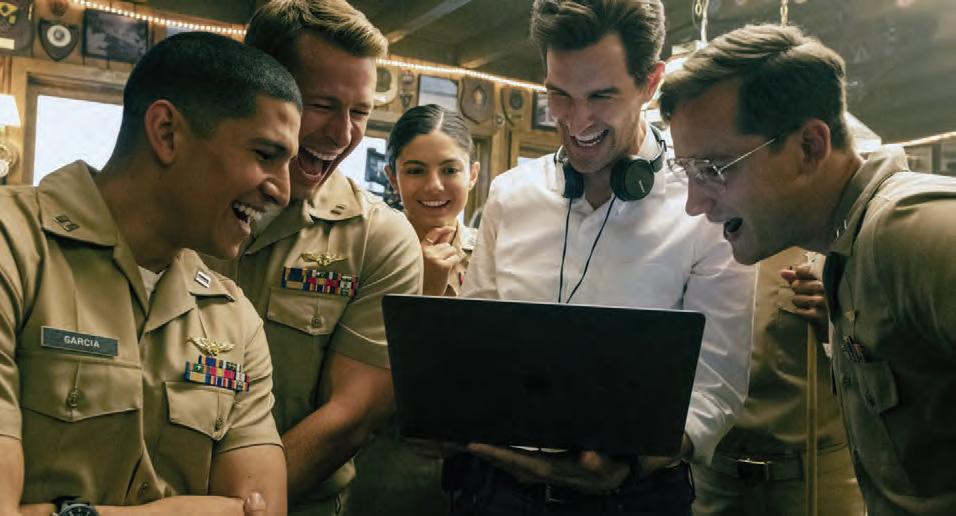
Tom was jumping off the roof of his house as a kid. He’s just always been that way. So, for him, he loves [stunts]. He’s always very well-trained and is working with the best people. To an outsider, it does look insane. But I

10 DEADLINE.COM
Director Joseph Kosinski tells some personal stories behind the successful sequel and this season’s biggest splash
From left: producer Christopher McQuarrie, Tom Cruise, director Joseph Kosinski and producer Jerry Bruckheimer.
PARAMOUNT PICTURES/COURTESY EVERETT COLLECTION FT THE BIG REVEAL
From left: Danny Ramirez, Glen Powell, Monica Barbaro, Joseph Kosinski and Lewis Pullman on the Top Gun: Maverick set.

think for him; he’d want to be doing nothing else. It’s his dream. He’s living his dream every day on a movie set doing these things. So, for him to do it is one thing. But on this film, I had all the other actors [flying for real] too. They all wanted to do it to prove they could do it, and to deliver something really special. Because once we saw the footage they were getting, it was undeniable. As soon as they landed, we’d put the chips from the cameras into the monitor and we’d sit and watch it, and everyone would cheer when you saw those great moments. The other thing is, I knew they were in the hands of truly the best aviators in the world. I mean, when you saw how professional these Navy pilots were, it does look incredibly dangerous and thrilling and exciting. But that’s what these people do every day.
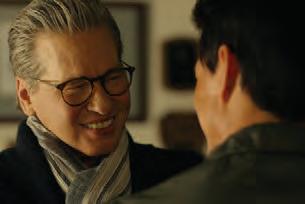
You’re pulling 6, 7, 7.5 Gs in the jet, and that’s incredibly draining. The actors were wiped out. Some days, we would have the actors fly in the morning and the afternoon and that’s when people would get sick. People would be just exhausted. It was really, really difficult. Even for the real pilots themselves, that’s a lot of work. One day the weather was so beautiful, Tom came up to me and said, “I think I should go three times today.” He’s like, “Joe, when you see this footage, you’re going to be blown away.” So, Tom went up and shot his third act sequence, which is the big bombing run. He came back, and
it was the last debrief of the day. I think all the other pilots had gone back to their trailers, and Tom came in and he collapsed in a chair, and he had his black Ray-Bans on. I said, “Tom, how’d you do?” And he said, “We crushed it.” It was very Maverick/Tom Cruise. Is there a difference?
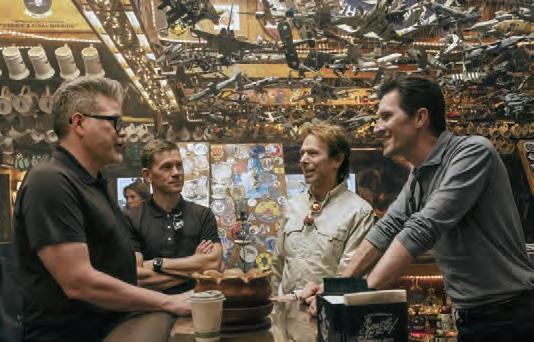
I had a huge love of aviation growing up. I was building model airplanes, really complex radio-controlled airplanes and flying them around. The first thing I did after getting this job was, I flew out to the Teddy Roosevelt aircraft carrier. I jumped on a Greyhound, which is not the fast jet, but I did get to fly out there and catch the cable, and then I got the catapult launch off the jet. When you’re directing the film, you kind of get to become a ‘subject matter expert’, which is the Navy term—the SME—on any subject you want. So, I got to live that dream of being in the Navy for a couple years. I got to go to places that civilians don’t get to go to. I got to see things that no civilian would get to see. I had my camera confiscated at one point. Wiped clean. I took some pictures and maybe captured something I wasn’t supposed to capture, and my camera was quickly returned to me without any photos on it. I got to go to China Lake and shoot in a hangar that is top secret. And it was all in this quest for authenticity. And I think you feel it when you see it, because you don’t feel like you’re in a Hollywood-designed setting. There’s a reality to it.
We collaborated with the actual engineers who make the real secret aircraft. It was just a dream come true.
Films from the ’80s are ones that people keep going back to because of that strong story foundation. Top Gun is one of those movies I remember seeing in the theater, along with Raiders of the Lost Ark and Back to the Future. I think that era was storydriven—certainly, there were visual effects, but not at the level you have now—because the story had to carry the film and visual effects could add a little special sauce on top. I think even Star Wars, which you think of as a giant effects film, had something like 400 shots in it, compared to movies now which have 2,500 or 3,000 effects shots. So, they had to have a fundamentally strong story to draw you in. I remembered that
experience of seeing Top Gun as an 11-year-old kid. So, when Jerry Bruckheimer sent me an early draft of Maverick, I had all those recollections, memories and feelings of what that movie felt like. ★

12 DEADLINE.COM
Clockwise from below: Iceman and Maverick; McQuarrie, Tommy Harper, Bruckheimer and Kosinski; Cruise in flight.
FT THE BIG REVEAL
PICTURES/COURTESY
Top Gun: Maverick
PARAMOUNT
EVERETT COLLECTION

GIRL POWER
How Ireland’s The Quiet Girl became a surprise stalking horse in the International Oscar race
 By Damon Wise
By Damon Wise
For the last three years, the winner of the International Oscar has pretty much been a given: First came Bong Joon-ho’s Parasite, then Thomas Vinterberg’s Another Round, and then Ryusuke Hamaguchi’s Drive My Car—all anointed by Cannes and eased to the finish line after prominent festival play in the usual cosmopolitan areas.
This year’s shortlist, however, paints 2022 as being far from such a one-horse race. True, the supremacy of Cannes as the foreign-language kingmaker is unchallenged, having berthed nine of the 15 contenders, and it’s worth wondering whether Triangle of Sadness would be the film to beat had its director, Sweden’s Ruben Östlund, filmed it in his native tongue. And, yes, once again, the field is overwhelmingly male, with just three female-directed titles—Morocco’s The Blue Caftan, France’s Saint Omer and Austria’s Corsage—vying with heavyweights like Park Chan-wook (South Korea) and Alejandro G. Iñárritu (Mexico) for inclusion in the final five.
However, the anomaly in this year’s shortlist is a film that challenges the usual notions of representation in the category. Based on the novella Foster by Claire Keegan, Ireland’s entry The Quiet Girl tells the story of Cáit, a 9-year-old girl who is sent away by her dysfunctional family to live with relatives in the country during the summer of 1981. One of a handful of films made by largely English-speaking countries to be submitted to the Academy (another being Australia’s You Won’t Be Alone, filmed in Macedonian), The Quiet Girl is filmed entirely in the Irish language, a form of Gaelic, which poses some interesting questions about cinema and national identity.
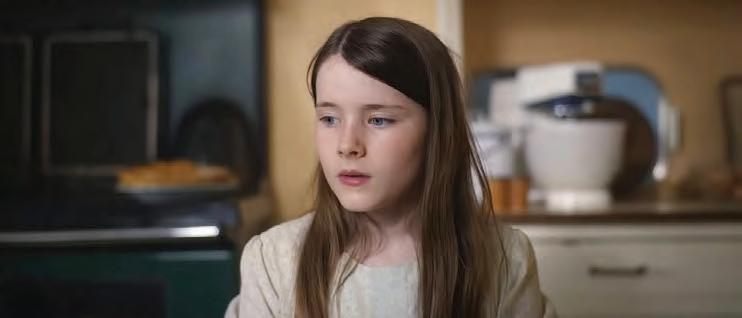
For director Colm Bairéad, making the shortlist was an achievement in itself. “We knew from the outset that we would be eligible,” he says, “but we also knew that the task of competing at that level— against the very best of world cinema—was an extraordinarily difficult one. So I kind of pushed that notion to the back of my mind and just focused on making a film that would appeal to my own sensibility.”
But after the film’s critical reception proved so positive (more on that later), the prospect of getting a nomination in the Best International Feature category quickly became a talking point. Says Bairéad, “No Irish film has ever been nominated in this category at the Academy awards. For an Irish-language film to achieve this would be a monumental moment, both for our country and for our language, which is an endangered language and which has rarely had a voice in the history of cinema.”
Of all the films on the list, Bairéad’s film has had the longest life, premiering in February at the Berlinale’s often-overlooked Generations strand and getting a dual release in the U.K. and Ireland the following May. But the film is still on its path, garnering more and more enthusiastic reviews as audiences continue to discover it.
14 DEADLINE.COM/ AWARDSLINE
BANKSIDE FILMS/COURTESY EVERETT COLLECTION
FT FOCUS ON: INTERNATIONAL
The Quiet Girl
From left: Kate Nic Chonaonaigh and Catherine Clinch in The Quiet Girl

Was it obvious to Bairéad that his creation would be so enduring? “Well,” he says, “there’s always that moment in the edit when your film—though incomplete—finds its voice for the first time, where you stop looking at the sheet music, so to speak, and just let this thing you’ve assembled speak to you for what it is. I remember at the end of a particular viewing being overwhelmed, emotionally. It’s that magical and slightly dangerous moment where you fall in love with the work. And from that point onwards, you give all of yourself to it and you’re trying to help it to find its fullest expression of itself, in the hope of achieving a similar response in others.”
In terms of the audience reaction, Bairéad credits the film’s success in Berlin and at the Irish Film and Television Awards (AKA the IFTAs), where it picked up seven awards, including Best Film, with creating momentum before the theatrical release.
“It just kept growing and growing,” he recalls, “holding screens across the two territories. In the end, The Quiet Girl ran in cinemas for over six months and grossed over €1 million at the Irish/U.K. box office, smashing the previous record for an Irish-language film and becoming a kind of cultural landmark here in Ireland. Beyond its home shores, it has so far been released in Australia and New Zealand, where it received a phenomenal reception, and it’s still playing in Australian cinemas after nearly four months. Audience reactions at festivals across the globe have been just as encouraging with the film receiving many Audience Awards, so we’re very excited to see what 2023 brings when the film is released in more international territories, including the U.S. [in February].”
The film’s commercial success might even mean that The Quiet Girl has a long shot at appearing in other categories, something that would have been unthinkable five or more years ago. Says Bairéad, “The

success of international films in multiple categories of the Academy Awards in recent years is a good indicator of how the Academy is opening its arms to a broader, more inclusive idea of cinema. Which is, in itself, reflective of a broader audience response, I think.”
He recalls Bong Joon-ho’s Oscar acceptance speech, in which the Parasite director joked about “the one-inch-tall barrier of subtitles”. “People are happily stepping over that now,” he says. “You can feel the energy of that audience online, the fervency with which they engage with this cinema from all over the world; it’s palpable. As for Irish-language film production, it will be really interesting to see what emerges in the coming years in the wake of The Quiet Girl’s success. No one can claim anymore that making a film in Irish is a dead end, either critically or commercially. That veil has been lifted.”
The film’s epic journey has given Bairéad a lot of time to reflect about his film’s meaning and how to interpret its burgeoning popularity.
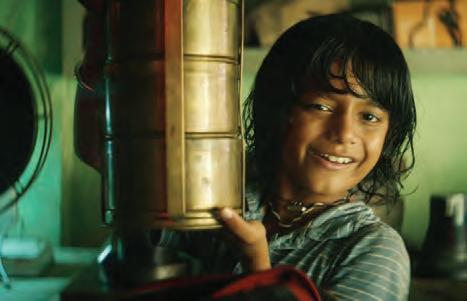
“You could say that The Quiet Girl is a small story, that it’s
a kind of miniature, and that would be true,” he says. “But, to me, its essence has always felt huge, because it touches upon things that are fundamental to all human beings—the need for love, the question of family, the phenomenon of grief. These things were all present in the story the film was adapted from, which itself had been translated into multiple languages, so it was clear before we began that there was a universality to this story. It was just a question of harnessing that and honoring it in a new medium.”
Looking at the shortlist, The Quiet Girl stands out, alongside Belgium’s Close and India’s Last Film Show, as part of a mini-wave of films this year that treated the inner lives of pre-teen children with care and respect. Might that have something to do with its success? Says Bairéad, “There’s possibly some truth to the idea that films centered on children have the potential for a broader acceptance—it’s difficult for an audience not to care for a child, regardless of what culture that child is coming from or what language they’re speaking. From our own direct experience, audiences everywhere have tended to speak of the film’s beauty, referring not only to the visual presentation of the story or the manner of its telling, but to its deeper meaning.”
Which is?
“‘What will survive of us is love,’ wrote the great poet Philip Larkin. That same message applies to this film.” ★

16 DEADLINE.COM/ AWARDSLINE A24/MONSOON FILMS/STRAND RELEASING/COURTESY EVERETT COLLECTION
Close
Last Film Show
FT FOCUS ON: INTERNATIONAL
The Blue Caftan

A WIDE, WIDE WORLD
International-themed films dominate this season’s Oscar documentary feature shortlist
By Matt Carey
In theory, international films can earn an Oscar nomination for Best Picture in any given year. But in reality, only a handful have ever attained that distinction, and a single one— Parasite—has claimed the prize.
For a truly global competition—international and American films contending in the same category—one has to turn to the Best Documentary Feature race. This year alone, shortlisted documentaries vying for a nomination originate from China, Vietnam, India, Ukraine, Canada and the U.S.
Vietnamese director Ha Le Diem shot her shortlisted film Children of the Mist in a Hmong community in Northern Vietnam, where teenage girls are routinely kidnapped by male suitors and coerced into marriages. Di, the 14-year-old heroine of the documentary, flirts with a boy who soon abducts her and with help from his family tries to force her to tie the knot.
“New Year is the season of bride kidnapping, and it is allowed,” Di’s mother informs her young daughter. Di observes, “Mum means that if I am kidnapped, I must cope on my own.”
Children of the Mist made the shortlist despite not benefiting from a major distributor. The same is true of Hidden Letters, directed by Violet du Feng and Qing Zhao. That film explores gender relations in contemporary China through the lens of two protagonists who come from a part of the country where
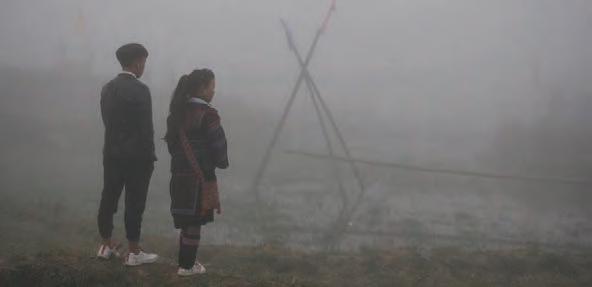
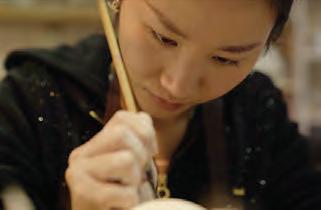
women developed a secret language to cope with suffocating patriarchy.
“Four hundred years ago in feudal society in China, where women had bound feet,” du Feng has said, “and were deprived rights of education, they decided to create their own language by writing poems and songs to give each other hope and dignity… The language survived.”
In an earlier era of the Academy, internationalthemed films like these might have gone unrecognized. But about half a dozen years ago, filmmaker Roger Ross Williams—then a governor of the Academy’s Documentary Branch—began pushing to expand branch membership beyond the traditional profile of white, male and American.
“Now the Documentary Branch is a third international,” Williams says. “We’re the first branch to go from non-gender parity to gender parity. And we have an incredible amount of BIPOC members. We still have a lot of work to do too, but we are the most diverse branch in the Academy.”
Syrian-born filmmaker Orwa Nyrabia, the artistic director of IDFA who joined the Academy’s Doc Branch in 2017, allied with Williams in efforts to increase the branch’s international contingent.
“That was very necessary,” Nyrabia comments. “I think what’s been achieved is an amazing accomplishment. And I think on the Documentary Branch level, Roger Ross Williams has done the Academy a historical favor.”
The impact of the increased international membership can be seen in the roster of documentaries
to secure Oscar nominations in recent years, including a pair in 2022: Flee, the story of a gay Afghan refugee directed by Danish filmmaker Jonas Poher Rasmussen, and Writing with Fire, about Dalit women journalists in North-Central India directed by Indian filmmakers Rintu Thomas and Sushmit Ghosh. The Mole Agent from Chile, Romania’s Collective, Brazil’s The Edge of Democracy, Honeyland from North Macedonia, and The Cave and For Sama—both from Syria—are among other recent international documentaries to claim Oscar nominations.
In addition to Hidden Letters and Children of the Mist, the Doc Branch shortlisted several other international contenders, including A House Made of Splinters from Danish director Simon Lereng Wilmont, set in a shelter in Eastern Ukraine that houses neglected children. The vivacity and vulnerability of the young protagonists has touched many viewers.
“I was drawn to Eva,” Wilmont says of one of his subjects, “because of the look in her eye. It had both sadness and joy, and she was doing these cartwheels all the time. And sometimes it seemed like that was her way of getting the anger out, and sometimes it was to celebrate how happy she was.”
One Oscar favorite hails from India: All That
18 DEADLINE.COM/ AWARDSLINE
FT FOCUS ON: DOCUMENTARY
MOVEMENT/CARGO FILMS/COURTESY
COLLECTION
FILM
EVERETT
Children of the Mist
Hidden Letters

Breathes. Shaunak Sen’s film, winner of the top documentary prizes at Sundance and Cannes, examines two brothers and their assistant in Delhi, India, who rehabilitate birds suffering in the city’s choking air pollution.
“When you live in Delhi, you’re constantly thinking of the air,” Sen says. “The air itself is a palpable, visceral, tactile, heavy, and gray phenomenon and a texture of grayness sort of constantly laminates your life. I was interested in doing something which is like an abstract triangulation of air, bird, humans. And that’s actually how the film began.”
Unlike some other international hopefuls, All That Breathes boasts a major distribution partner in HBO Documentary Films, alongside Submarine Deluxe and Sideshow. HBO Documentary Films, under the leadership of Nancy Abraham and Lisa Heller, also contends with three other films: Moonage Daydream, Brett Morgen’s David Bowie doc; The Janes, by Tia Lessin and Emma Pildes about a group of women who set up a secret network to provide abortion services in Chicago in the 1960s, and All the Beauty and the Bloodshed, the Venice Golden Bear-winning film directed by Oscar winner Laura Poitras (Citizenfour). The latter film centers on renowned photographer Nan Goldin, who successfully pressured major art institutions to cut ties with the Sacklers, the family whose wealth was partly derived from selling the opioid OxyContin.
Neon, the taste-making independent production company and distributor, released All the Beauty and the Bloodshed theatrically. It also distributed Moonage Daydream, the top-grossing documentary of the year, with more than $12 million in receipts worldwide, and another big Oscar favorite, Fire of Love, directed by Sara Dosa, about an adventurous French couple who studied volcanoes but lost their lives to their
scientific obsession.
National Geographic released Fire of Love, scoring a shortlist hat trick with that film, Matthew Heineman’s Retrograde, and The Territory, the feature directorial debut of Alex Pritz. The Territory tells the story of an Indigenous Brazilian tribe attempting to protect its land in the Amazon rainforest from illegal miners, squatters and other invaders.
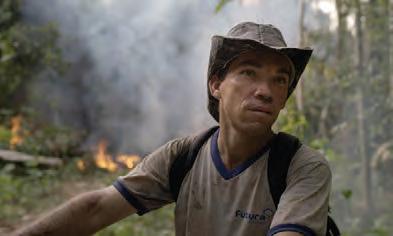
“One of the most meaningful things for us was that NatGeo supported us in releasing the film in Brazilian theaters. We’ve just come back from opening weekend in São Paulo and Rio de Janeiro and 15 cities across the Amazon,” Pritz said last fall. “We’re nearing a hundred festivals now and it’s just been an incredible ride.”
Netflix’s hopes hinge on Descendant, Margaret
Brown’s documentary about people in the Mobile, Alabama area who trace their ancestry to survivors of the last slave ship to enter U.S. waters on the eve of the Civil War. And Sony Pictures Classics has Hallelujah: Leonard Cohen, a Journey, a Song, by Daniel Geller and Dayna Goldfine, about the late Canadian singer-songwriter’s most cherished composition.
“Of all the songs, it feels like the one where, in a way, he distilled so much of his essence,” Geller says. “And that’s probably why it took about seven years for him to write the first version [he] recorded.”

Canadian filmmaker Daniel Roher directed the Oscar favorite Navalny, about the Russian opposition leader who was nearly killed in a Kremlin-conceived poisoning plot. After recuperating in Europe, Navalny returned to Russia and was promptly arrested and imprisoned. At a recent Q&A, the filmmakers were asked about the larger geopolitical context of their film.
“There’s a simple answer, which is, will the world tilt toward authoritarianism?” producer Shane Boris responded. “And the answer is yes,
if we do nothing. And I think that’s what Navalny shows in the most profound way, that it is our responsibility to do something.”
Navalny represents something of an Oscar swan song for CNN Films, the documentary division of CNN that produced RBG and other titles going back a decade. Late last year, new CNN chief Chris Licht announced CNN Films would no longer partner with outside-based filmmakers on projects but instead produce documentaries exclusively in-house.
MTV Documentary Films, which earned an Oscar nomination last year for Ascension, returns to contention with Last Flight Home, Ondi Timoner’s poignant film about her ailing father Eli Timoner, who decided to end his life as permitted under California’s End of Life Option law.
David Siev’s contender Bad Axe, from IFC Films, has gained awards momentum after its debut at SXSW, where it won the audience prize for documentary. Like Last Flight Home, it’s a film that springs from experience.
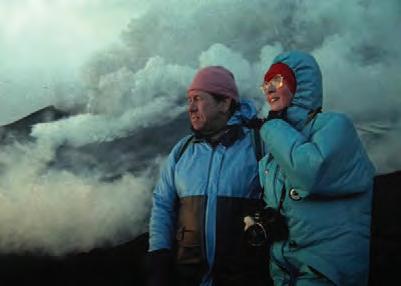
“It’s an incredibly personal story because it’s a film about my family,” Siev says. “My mother, she’s Mexican-American, and my dad is a Cambodian refugee that came here after the Killing Fields in 1979… It’s a story of hope, resilience and what the American dream looks like in 2020.”
Last year, Summer of Soul—a doc about a se-
ries of groundbreaking concerts by African American artists in Harlem—earned the Oscar for Best Documentary Feature, which was evidence that American-oriented stories still enjoy an advantage when it comes to winning in the category. Whether an international-focused documentary beats the odds this year remains to be seen, but a vital indication will appear when the Oscar nominations are announced on January 24. ★
20 DEADLINE.COM/ AWARDSLINE FT FOCUS ON: DOCUMENTARY NATIONAL GEOGRAPHIC/SONY PICTURES CLASSICS/NEON/COURTESY
EVERETT COLLECTION
The Territory
Fire of Love
Hallelujah: Leonard Cohen, a Journey, a Song
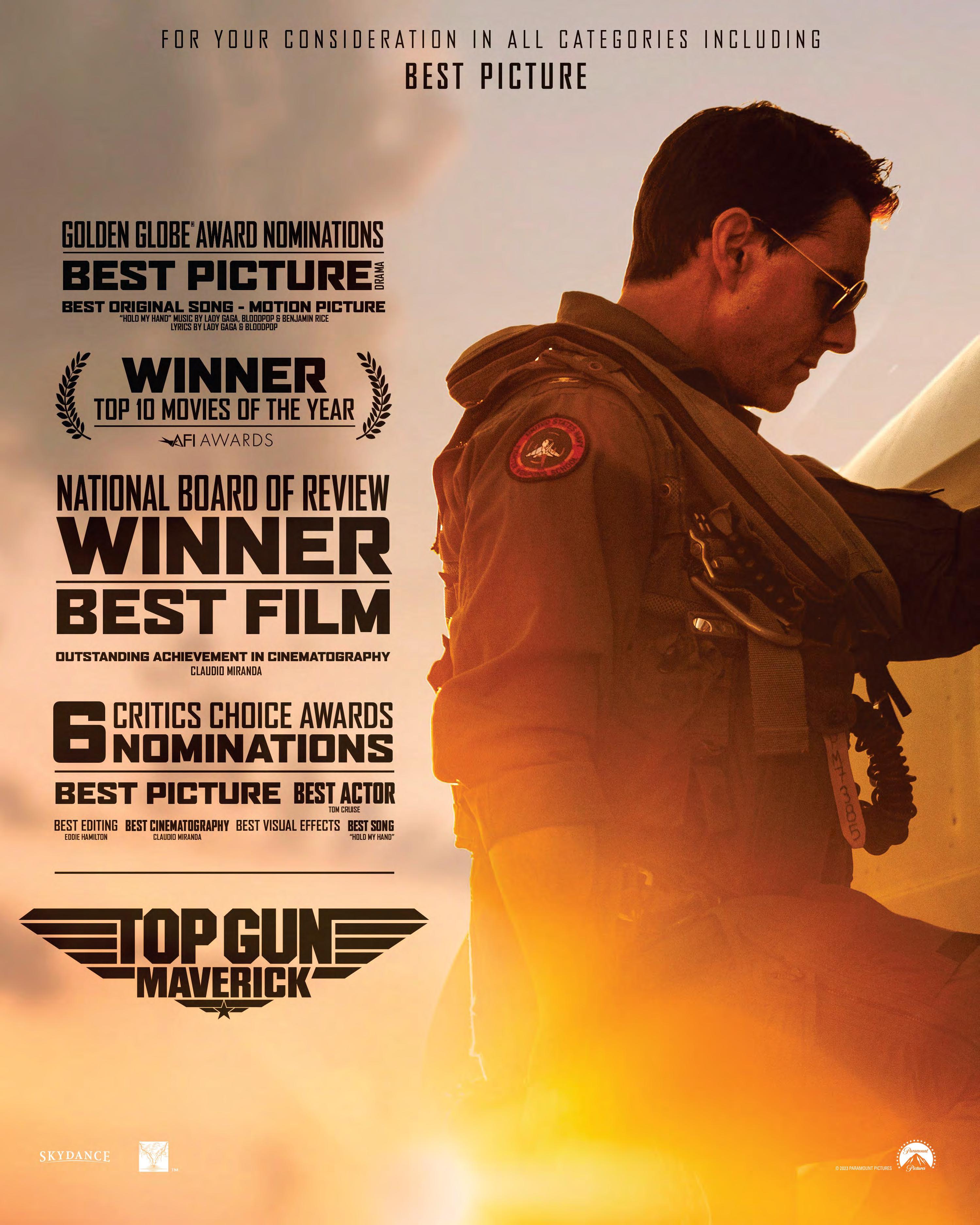
FRESH FACE
By Destiny Jackson
WHO
Felix Kammerer
Age: 27
Hometown: Vienna, Austria
WHAT
In his feature film debut, Austrian theater actor Felix Kammerer delivers a haunting star-making performance in Edward Berger’s German-language rendition of All Quiet on the Western Front. The anti-war drama, based on Erich Maria Remarque’s 1929 novel of the same name, follows a German battalion of spirited young men as they experience the atrocities of war while battling the French on the frontline. More specifically, the soldiers’ road to disillusionment is seen through the eyes of plucky Paul Bäumer (Kammerer) as the damning psychological effects of World War I combat ravage what’s left of his innocence.
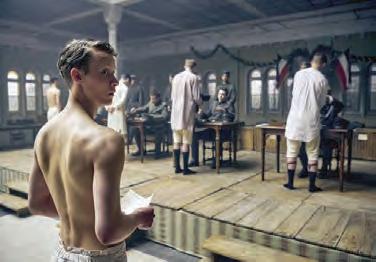

For Kammerer, a veteran of stage plays but a newcomer to film, watching himself on the big screen for the first time offered great insight. Upon witnessing the raw expression of trauma and humanity in his performance, Kammerer decided he was on the right career track. “I really liked that I couldn’t see myself on the screen,” Kammerer says. “I had nothing to do with that person. It felt like it was Paul on the screen and me watching this person. For me, that’s a great sign that I have detached from that role so clearly. When I feel that I’m totally fine with what I’m seeing and doing, while at the same time I don’t feel that it’s me, that’s a very important factor. That’s how I know I’ve done a good job.”
WHY
Born to esteemed opera singers, Kammerer’s career choice seemed almost inevitable as he describes it. “Because of my parents, I grew up on stage and in changing rooms and theater houses,” Kammerer recalls. “First, I wanted to be a director, cinematographer, or even a physicist—though I’m bad at math. But then I started acting in youth theater companies, and when I was 17, I realized that acting was something I wanted to study.”
After spending four years at Berlin’s Ernst Busch Academy of Dramatic Arts, Kammerer was handpicked by dramaturge Sabrina Zwach to join the prestigious Burgtheater in Vienna. There, Kammerer would find himself trading in soliloquies for marching orders. At Zwach’s behest, her husband, All Quiet on the Western Front producer Malte Grunert, saw Kammerer during one of his first plays at the theater. Grunert was so impressed by his performance onstage that he offered Kammerer an audition right on the spot after the show and personally recommended him to Berger for consideration. “I owe it to [Zwach] that I’m here where I am now,” Kammerer says. “Her husband came to watch a play and saw me on stage and really liked what I did. That’s how it all started. It was an accident.”
Kammerer did not let the switch from stage to screen faze him. During his six-month prep period, he threw himself into research to help him capture the essence of an early 1900s soldier. In addition to watching films and gaining access to rare pictures and audio files from the beginning of
the 20th Century, Kammerer’s most daunting task was sifting through war letters from the British National Archives’ Letters from the First World War collection. “I observed everything that I found, and read around 2,500 letters from the front,” he says. “It’s so interesting and heartbreaking to read those letters because they’re censored. People didn’t want to tell their families [about the difficulties] of what was really going on. And those letters are their private thoughts. Seeing that helped a lot in preparing me for this role.”
WHEN & WHERE
As for where we’ll see the rising star appear next, Kammerer jokes that he can’t share that classified information just yet. But when he considers the roles he’s aiming at in the future, he says, “I’d like a project that is important in a more universal way. Not just a happy story, but something that tells us something about humankind, about history, something that has many layers and can tell us something about the things we don’t understand about ourselves. Something that makes you feel, ‘Ah, we needed that movie.’”★
22 DEADLINE.COM/ AWARDSLINE FT FRESH FACE
BAJO/NETFLIX
REINER
Felix Kammerer as German soldier Paul Bäumer.


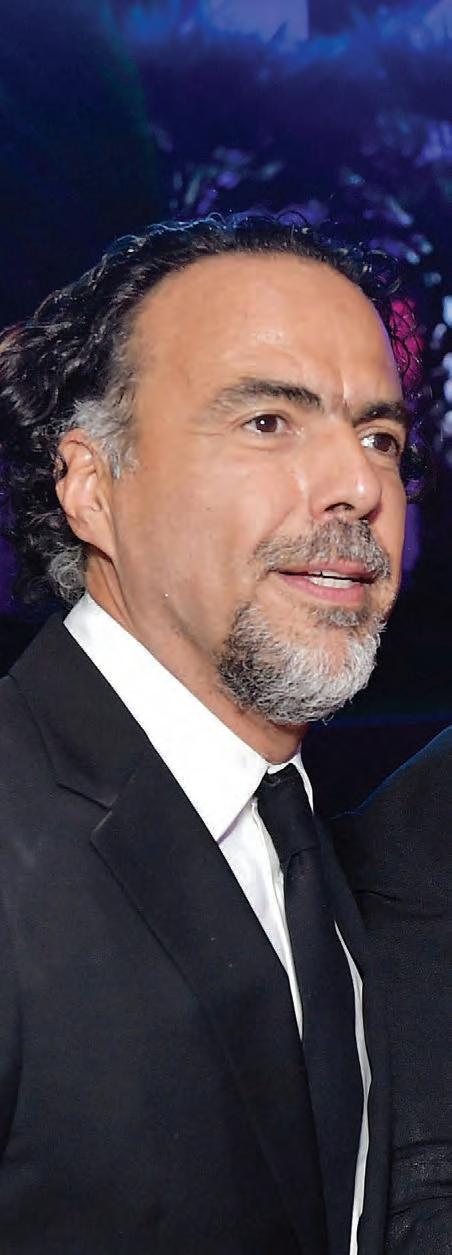
GETTY
Alfonso Cuarón, Guillermo del Toro and Alejandro G. Iñárritu have forged an unshakeable friendship over years of filmmaking in their native Mexico and internationally. They won five Best Director Oscars and claimed two Best Picture trophies in the space of six years, bolstering the profile of Mexican cinema on the global stage. In their first joint interview in more than a decade, the ‘Three Amigos’ gather with Joe Utichi for a wide-ranging discussion about art, life and the future of cinema.

DEADLINE.COM/ AWARDSLINE 25
The
filmmakers Alfonso Cuarón
Guillermo del Toro and Alejandro G. Iñárritu
released three new movies in the space of the same year was 2006. By then, their reputations at home had been established by early successes like Y tu mamá también (Cuarón), The Devil’s Backbone (del Toro) and Amores Perros (Iñárritu) and they had each worked in the U.S., with del Toro and Cuarón stepping into blockbuster cinema with Hellboy and Harry Potter and the Prisoner of Azkaban respectively, and Iñárritu directing Sean Penn and Naomi Watts to Oscar nominations with 21 Grams
When they donned tuxedos to celebrate the 79th Academy Awards together on February 25, 2007, the ‘Three Amigos’, as they’d been dubbed, might have considered the evening a high watermark in their respective careers. Iñárritu had been Best Director and Best Picture nominated for Babel; Del Toro had a nod for his Original Screenplay for Pan’s Labyrinth; and Cuarón was nominated for his Adapted Screenplay and Editing on Children of Men.
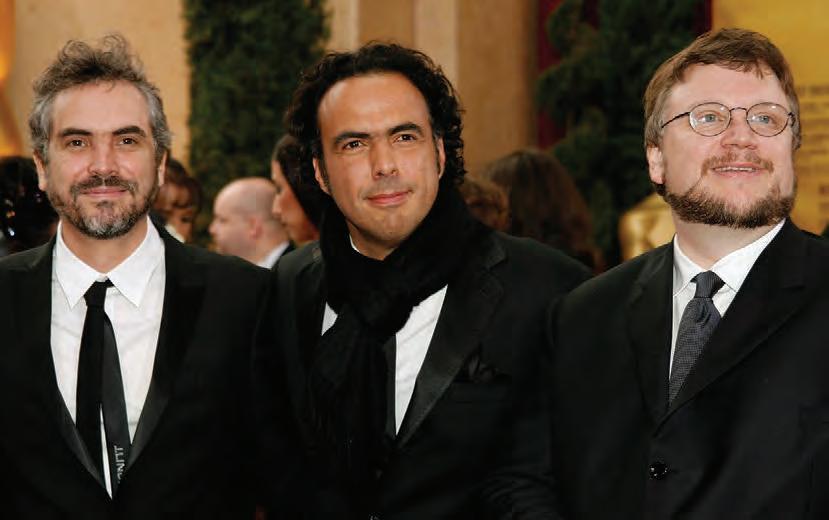
Few could have predicted then that just a few years later, between
2013 and 2018, Cuarón, del Toro and Iñárritu would split no fewer than five of the six Best Director Oscars and take home two Best Picture trophies for a run of work that firmly established them in the pantheon of cinema history. With Gravity, Birdman, The Revenant, The Shape of Water and Roma, the three filmmakers ascended the Oscar stage to share their unique visions of cinema with the world. And against a political backdrop of anti-immigrant sentiment, they made inarguable statements about the power of the international community of film.
Behind all the pomp, praise and prizes is a friendship and collaboration that has endured for decades. They have supported one another and helped champion new voices, in Mexico and around the world. They have forged successes both together and independently, and they have carried failures for themselves and for each other.
They gather now, for their first major joint interview since 2006, as each of them continues to tread new ground. Alfonso Cuarón is still cooking his next feature, but he has this year produced Alice Rohrwacher’s Oscar-shortlisted short film Le pupille and Rodrigo García’s Raymond & Ray, which premiered at the Toronto film festival. Guillermo del Toro has literally attached his name to two projects this year: anthology series Guillermo del Toro’s Cabinet of Curiosities, and his first animated feature Guillermo del Toro’s Pinocchio, both for Netflix. And Alejandro G. Iñárritu delivers his most personal work to date with Bardo: False Chronicle of a Handful of Truths, in which he takes an unabashed look at his own triumphs and tragedies.
The conversation between the three old friends flows easily and requires little moderation. So obsessive is their interest in their chosen field that ideas become bold, and arguments become (comfortably) heated. But we begin where we should, with a trip down memory lane, and their first encounters with one another…
26 DEADLINE.COM/ AWARDSLINE
GETTY IMAGES/LIONS GATE/EVERETT COLLECTION//20TH CENTURY FOX/NICK WALL/WIREIMAGE
last time Mexican
,
Alfonso Cuarón, Alejandro G. Iñárritu and Guillermo del Toro at the Academy Awards in 2007.
GUILLERMO DEL TORO: To start chronologically, Alfonso and I met in the ’80s having heard about each other through mutual friends. I remember thinking, ‘Who is this guy who everyone likes?’
When you’re 20 or younger, you’re envious of everybody [laughs]. ‘Why do people like this guy?’
We finally met in the waiting room of Hora marcada, a TV program that I was going to do the makeup effects on; Alfonso was writing and directing. I went in to say, “Look, I’ll do the makeup effects for you if you’ll let me direct and write a few episodes.”
So, we became friends very quickly, and then Alejandro and I met because Alfonso called me and said, “There’s this guy who made a movie called Amores Perros, and he’s a goddamned genius, but he’s also really, really stubborn and he should cut the movie a little bit.” He gave me Alejandro’s phone number and a VHS—which I still have—of an early cut of Amores Perros
He told me, “We’ve all decided that the only guy as stubborn as him is you, so you should go and make him cut the movie.”
ALEJANDRO G. IÑÁRRITU: It was also Antonio Urrutia, no, Gordo?
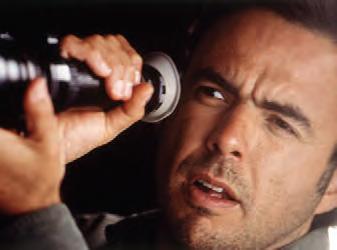
DEL TORO: Yeah, him and Alfonso both. They said, “He’s a genius, but he’s the most stubborn motherfucker.” And it’s still true today [laughs].
IÑÁRRITU: Look who’s talking [laughs].
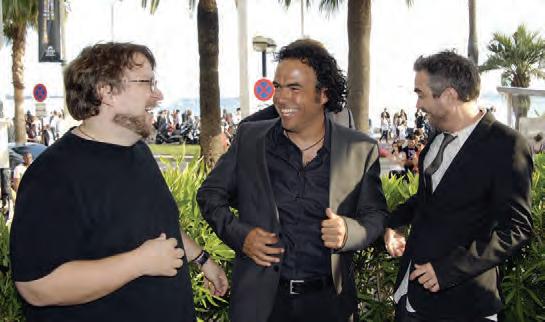
Before Guillermo called me, I went to LA to meet Alfonso. He was already preparing Great Expectations, and he was living in the fancy hotel, the Chateau Marmont. He was already kind of a rockstar for me, and I hadn’t met him yet.
I was about to start directing a pilot that I wrote for TV. It was my first attempt to do something that was one hour in length. Alfonso knew my work in advertising a little bit, and he always sent nice comments through Chivo [cinematographer Emmanuel Lubezki]. I worked with Chivo before anything, and he had obviously worked with Alfonso by then. So, I went to visit Chivo, and I met Alfonso in the garden of the Chateau Marmont, and we spent two or three hours talking.
I literally went to get his advice, and he was very generous and read what I wrote. He was, in a way, mentoring me, giving advice about casting,
about blocking, things like that. I remember how generous he was, and in that moment, I really appreciated it.
So, I met him in ’95 and then I met Guillermo in ’99, when I was editing Amores Perros. And yes, it’s true that the film was finished. I edited it in my house for eight months and I considered it done, but it’s also true that it did need to be edited down. Guillermo and I spent three or four days in the studio discussing the movie, with him trying to get a little bit of consciousness out of this stubborn guy talking now. And he succeeded, I guess,
because it’s a shorter film as you know it now. Well, how many minutes did you say, Gordo? You said 20, I think, and we lost seven.
DEL TORO: Listen, I still say it and you should take my word for it. I have the VHS. We did lose about 20 minutes. You may have put some back. And we flipped the bank robbery from one reel to another.
IÑÁRRITU: Honestly, maybe it was a masterpiece and you destroyed it. What about that?
DEL TORO: [Laughs] No, but what is great about the three of us is the friendship was formed very fast. Alfonso and I, it was like we’d known each other all our lives, and the same thing was true when I met Alejandro. I felt he wasn’t just a great filmmaker, but a good guy. I liked him.
Theirs was a friendship forged in brutal honesty. As the three filmmakers explain it, nothing is off-limits when it comes to the feedback they offer one another, provided it follows one golden rule...
DEL TORO: The curious thing is we are very different, but we do also have a certain leaning towards philosophies about life that are similar somehow. We don’t see failure or success as defining features. We can see the good in the bad and the bad in the good. We have a dialogue that is very real, and I think that’s what helps us not get lost. It’s helpful to have these two guys to keep me in check, so that I don’t get high on my own supply. We remember, at the end of the day, that we grew up together.
ALFONSO CUARÓN: You can talk about the differences between us, but I see them more as complements, in the sense that I think we’re each very aware of our own limitations and of each other’s strengths. In that sense, even if we have a specific way of how we approach cinema, each one of us always understands where the other is coming from.
That’s great, because when there are disagreements—when I want to do something specific, and one of them puts a red flag on it—I immediately know that it’s something I have to be cautious about. That maybe his solution is not the solution I’m looking for, but that perhaps I have to find some solution.
And I mean, the communication between us is brutally honest. It is brutal. I have tried to have that kind of conversation with other peers, and they don’t like it [laughs].
DEL TORO: It’s true.
CUARÓN: Maybe I can be that brutal with Paweł [Pawlikowski] too, but most people don’t like it, and with Paweł the complementary nature of the relationship doesn’t exist in the same way it exists with Guillermo and Alejandro.
Some of the things Guillermo or Alejandro say to me, they really sting. They sting so bad, and I’m hurt. But the funny thing is that before the anger rises, laughter does, because you feel almost silly to be exposed in such a brutal way. The complement of the three of us is very strange, because it’s like these guys are funhouse mirror versions of myself.
DEL TORO: That’s a great way of putting it. The way we talk to each other, when Alfonso says brutal, he means brutal. You might show them a cut and they’ll tear it apart and go, “Look, no matter what you think this might be, this is what the audience will tell you about it, and this is what the critics will say. Change it or don’t change it, but this is what you must accept.”
DEADLINE.COM/ AWARDSLINE 27
Iñárritu directs Amores Perros in Mexico circa 1999.
Del Toro, Iñárritu and Cuarón at the Cannes Film Festival, 2007.
IÑÁRRITU: The nonverbal rule between us is that, more than just being brutal for the sake of it, whenever we have something to say about each other’s work, it has to be something that is both truthful and useful, not destructive. That rule is really important, because I’ll never lie to them, and I know they won’t lie to me.
When I talk to other directors, I don’t have the same depth of relationship that I have with these two. We talk about technical things, stuff that is on the surface. But with these two, the benefit is they know very deeply who I am, and what my motivations are, and what triggers me. That deep knowledge of what needs to be said, and of how to say it in a way that is truthful and useful, is a complex mechanic.
DEL TORO: Alfonso and I co-produced The Devil’s Backbone and Pan’s Labyrinth. We co-produced with Alejandro on Biutiful. The three of us co-produced a movie together called Rudo y Cursi. But it’s more than just producing; I’m inspired by them.

I remember one time I discussed with them writing a one-setting thriller. Alfonso said, “Oh, I’m going to write one myself,” and he wrote Gravity. And I think Alfonso’s experiments with the splice take on Children of Men were incredible additions to the vocabulary of world film. He refined that language in a beautiful way on Children of Men, and I think that somewhat inspired Alejandro to do Birdman
When I saw Birdman, I thought, ‘I’ve got to do The Shape of Water,’ because I was very afraid of how I could do that project for $19.5 million, which is a very tight number. I asked Alejandro how much he spent on Birdman and he told me, and it was something not that high. He said, “A budget is a state of mind,” and I knew then, I could do it.
So, if you ask me, we’re constantly inspiring one another, but we’re also tough. Alejandro and Alfonso have both been really tough with me when I make a mistake. I won’t go into the details because there are NDAs all over the place [laughs], but they’ve told me before: “Don’t do this.” And I go and I do it, and it’s a mistake. We warn each other. Very lovingly, but very sternly.
IÑÁRRITU: For me it’s the same. The work of Guillermo and Alfonso has always been a trigger for inspiration, and they’ve encouraged me to go further and learn about my own approach. As a filmmaker, you’re growing as a person, and as a person you’re changing perspectives, the way you live, the way you experience life, the way things impact you psychologically, spiritually and physically. So, it’s great that we have been able to share those shifts in our perspectives on life and adapting ourselves to what we want to say and the way we want to say it.
Circumstances have a huge impact; you’re always going through periods in your life where you’re getting lost, or you’re on a bumpy road, or you’re particularly inspired and creative. We’ve
28 DEADLINE.COM/AWARDSLINE
VIVIEN KILLILEA/GETTY IMAGES/PICTUREHOUSE/WARNER BROS./EVERETT COLLECTION
been able to manage that by being there for one another so that where one of us is down, the others are super high and can say, “Don’t fuck around, don’t get depressed. Get up. You can do it.” They open the door to things you can’t see in a particular moment. That’s the gift. That’s the blessing. We do make very different films, and we do come from different approaches, but I’m always in awe of what Guillermo and Alfonso can do that I never could. Like Pinocchio, for Guillermo: I wouldn’t even know where to start making a film like that. To see these incredible puppets and the technology he uses, and how he works with stop motion; there’s something about it I can’t even fathom. And yet I admire it and I learn from that.
DEL TORO: I also think we have three dialogues between each other, and at the same time a separate dialogue with the world. I don’t think the world knows Alejandro, I don’t think the world knows Alfonso, and I don’t think the world knows me. No matter how much work we put out, there’s an essence of each of us that is reserved on a human level for those that know us as artists and human beings. We can talk to each other about our craft and our successes in the most personal and philosophical way, and that helps us. I do believe there has been a moment or two where we have saved one another’s sanity at one point or another in our friendship.

Cuarón, del Toro and Iñárritu came of age together during a particular moment in time for Mexican film, and they resolved to lead their industry’s evolution. The creative inspiration they draw from one another is what makes them stronger and bolder as filmmakers, even to this day...
IÑÁRRITU: The only example I can think of for three directors who know each other as well as this is Spielberg, Coppola and Scorsese. They belong to the same generation, the same country, the same drive. The three of us share the same circumstances, coming from the same world, and we understand deeply who we are, not as filmmakers but as people.
DEL TORO: We came up in a different panorama of what Mexican cinema meant to the country and to international audiences. We started changing some of the technical aspects, and some of the presentational aspects of it, and the approach to genre and things like that. It was almost like the ABCs of what we set out to do, and now that is taken for granted.
CUARÓN: In many ways, the goal of our conversations is not even about the films, but about what the films are going to mean in our lives, and how they’re going to keep on building the lives we want. That, for me, is the most important aspect,
to share the success and failure with one another and to understand how that impacts our lives, and what we learn from it.
DEL TORO: It’s so true. Our movies together are not a filmography. They’re a biography of each of us. I see Alfonso’s high school movies, and then his senior movies, and I see how all our preoccupations get deeper. That doesn’t mean they’re more meaningful or not, but they get deeper in the context of who we are as the movies progress.
The first part of our career was how to handle the language of cinema. The latter part of our career is when the language of cinema and who we are start making contact. The films become a lot more personal, not necessarily in visible ways, but sometimes. I think Roma, Pinocchio and Bardo all have that in common, even if one of them is pure biography, one is a classic children’s fairy tale, and the other is obliquely a biography but also isn’t. They are joined in similar ways. Different approaches, but ultimately the way we have deepened in our own biography within film is very similar.
CUARÓN: Symbolic biographies, we can put it that way.
DEL TORO: I remember seeing Amores Perros and thinking, ‘Look at this guy, and his rhythm.’ It was percussive, and it was an incredibly prodigious handling of the tools of cinema. The virtuosity for me on Bardo is a lot more exquisite, a lot more refined. It’s not percussive, but it’s lyrical and really hard to execute. And the way it affects who he is, and the way he views the world, is a lot more delicate. It was the same with Roma

CUARÓN: Everything we say to one another comes from a place of love and generosity. It doesn’t come from competition or jealousy. What happens is that, yes, I see something Guillermo or Alejandro did, and I think, ‘I know nothing.’ I’m in awe. There’s a feeling of admiration, and I’m left to realize that I have a lot of growing up to do in cinema. But then, for as brutal as we can be with one another, when you hear something positive from them it makes you feel that pretty much,
you’re at the same level, just on a different path. I think that’s very reassuring, and it’s what allows for that brutal honesty.
I remember having that same thought when I saw Amores Perros. Besides the filmic aspect and being exposed to that kind of cinema, it also exposed this whole thing of, ‘What the heck have I been doing all these years?’ I found I needed to recover something that was a bit lost.
DEL TORO: When I was finishing Pacific Rim, and Alfonso was finishing Gravity, we showed each other the movies and we were both really happy with what we’d achieved. Then we went together to see Birdman, and we came out and said, “Oh my God. The house wins.”
It’s one of the rare times we went straight to a bar in Santa Monica, the three of us, and we got drunk together, because I remember after Alejandro had done Biutiful, he said, “I want to do something quick and small next.” And his quick, small movie was Birdman [laughs]. It was so demolishing to see what he was doing formally.
IÑÁRRITU: You guys are being very generous, but that’s the beauty of what we’re saying, because the exact same thing happens to me when I see the work of these guys. I will never forget how blown away I was seeing Children of Men for the
DEADLINE.COM/ AWARDSLINE 29
Above: Del Toro directs Pan’s Labyrinth in Spain c. 2005. Below: Cuarón directs Harry Potter and the Prisoner of Azkaban in England, c. 2003.
first time. I couldn’t understand how Alfonso had done some of those shots. Every single sequence was better than the last.
And I would say, as a Mexican filmmaker, that Cronos is a film that I think triggered in every Mexican filmmaker the idea that it was possible to make something that not only broke the rules of Mexican cinema—that you had to be political or talk about a specific thing—but that also injected genre cinema with a quality and a soul that nobody at the time had done. In a way, it was Guillermo who opened those doors.
We’re sending a lot of flowers to one another, but it is true that the good thing of being inspired by your friends is that it triggers in you not jealousy but awe. It guides and triggers your own sense of self, and pushes you forward to the next thing you should explore.
I think it’s also true that we’re at a moment in our careers where we’re epitomizing what we’ve learned through the years. You can only really explore new languages when you’ve done so many things in the past, so that you can put together everything you’ve learned and at the same time open the door for a new light in the room. I think that’s what we are always trying to do for one another when we talk.
CUARÓN: I’m still amazed and in awe of the possibilities of cinema, including the unexplored ones. To be able to have that conversation and admire other masters—old masters and new ones—to give us cinema that challenges us… I think that spirit is in our conversations.
I don’t think you invent new languages, because in many ways we’ve always tried to honor the language of cinema. I think there are few in the history of cinema who have given us the gift of reinventing and transforming cinema in terms of language, but I think what Guillermo, Alejandro and I try to do is to find out how to serve that language best.
DEL TORO: Yeah, but I think like the Beatles “With a Little Help from My Friends”, we have all sung out of key. Many times, in all the years of knowing
each other. And I know that, regardless of what happens, I’ll have these guys. That’s always the real consolation.
I think we’re also mindful to shepherd new voices, and we need to produce and mentor new directors. We’re very conscious and conscientious about that. Just this year, Alfonso produced a short [Le pupille] and I love that he’s doing that. Every time we produce other directors, we know we’re being part of the flow. Cinema doesn’t start and stop with our generation.
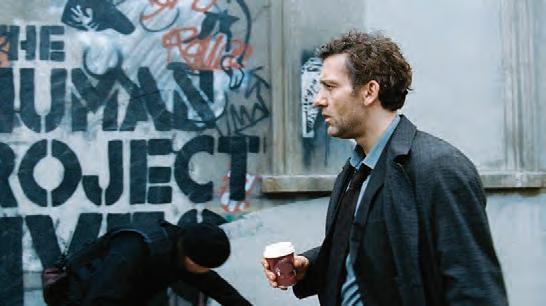


The trio never saw success in the United States as the pinnacle of achievement and have returned to Mexico not only to shoot their projects (even portions of Pinocchio were animated in Guadalajara) but also to support the work of the local industry and to give a leg up for Mexican artists...
DEL TORO: We came from a generation that was completely lost in Mexican cinema—a generation of directors that had to battle a lot of adversity. The people that came after us are doing great, inventive and beautiful things. We feel that even though we’re making movies in America, we carry with us a lot of our roots by producing in Mexico, or by looking at work that’s being done here and helping to boost it.
We belong to a limbo—a bardo—that came out of
seeking to weigh into an industry that was not natural to us. That we have in common. That’s important to say, because when we talk to an American filmmaker that feels they belong completely, we realize we are still doing things that are oddities. We are not completely commercial filmmakers in America, nor are we making movies exclusively about Mexico. We have the bardo commonality that we can articulate between ourselves in a very unguarded way.
The curious thing is that we come from Mexico, we work in America, but I think that we all live in film. We have had residency of cinema, you could say, since we were kids. That’s another country we inhabit.
CUARÓN: In Mexico now, on the one hand there’s a healthy industry for workers in the sense of the amount of work; there’s a lot of production, and that is healthy. I think work conditions are something very important: to create standards for those conditions. Here I’m talking about within the industry in general, not necessarily about filmmakers. With the explosion of series and content for platforms, there’s an immense amount of production but there isn’t a clear regulation for how it should be done, and sometimes the regulations have been inherited from how the old
30 DEADLINE.COM/ AWARDSLINE
A scene from Cuarón’s 2006 release Children of Men , starring Clive Owen.
20TH CENTURY FOX/MURDO MACLEOD/WARNER BROS./UNIVERSAL/EVERETT COLLECTION/VITTORIO ZUNINO/GETTY IMAGES FOR RFF
Left: Iñárritu with Michael Keaton on the set of Birdman in New York, c. 2013. Right: Cuarón shoots Gravity in London c. 2011.
industry used to do it. I think it’s very important to address that, for workers.
The other thing, in the sense of craftsmanship, is that because of the amount of production—and this is something that is being experienced worldwide—young people getting into the industry have a very short time to go through their learning curve. People start work as a third assistant on a production, and then they find themselves as the head of department on the next production because of the amount of production going on. On the one hand that’s great, but on the other, there’s a certain understanding of craftsmanship that comes from experience, and through the elder craftsmen teaching the younger generation the tricks of the trade. That’s a concern I have worldwide because it’s not just happening in Mexico. There’s always going to be a handful of very motivated people who try to learn this stuff in their own way, but as an industry that can be diluted.
And I do think it’s very important to look at how that comes together in a place like Mexico, because Mexico has flourished in the relationship between government sponsorship in partnership with private investment. In the last few years, the government subsidies have been lost, and with great detriment because it creates a dichotomy. Part of the reason there’s such a healthy industry of workers in Mexico, and there are plenty of jobs, is precisely because of the generations that came through because of that government sponsorship.
DEL TORO: All I wish is that we can establish continuity to what has already been gained. Mexico and Mexican cinema, in its relationship to the world, is very prominent now. New filmmakers are being looked at with great hope, and a lot of new female directors especially are standing strong on the international stage from Mexico. The continuity of that generation is important.
As Alfonso said, it’s a dichotomy, because it’s a very good moment in some ways and a very difficult moment in others. It’s not an industry that was subsidized out of capricious decisions; it was subsidized because it was not protected in NAFTA [the North American Free Trade Agreement]. It was left completely unprotected by many of the big government moves. Other industries in Mexico were protected, but the cinema industry was left completely open. That’s why it requires a subsidy. It’s not capricious, it’s not about quality, it’s about it being left alone to fend for itself.
CUARÓN: That had proven to be an amazing investment from the government for the last few decades, and what you’re talking about—that continuity you’re talking about—is very important because Alejandro, Guillermo and I witnessed firsthand the hardship of the generation that came before us. A generation of amazing masters that the three of us owe such a debt to. They had to survive incredibly tough circumstances, and ever since that system was created, a new continuity

DEADLINE.COM/AWARDSLINE 31
was able to emerge. It is as much an industry continuity as a cultural continuity. And probably that, perhaps, would be the biggest argument in support of those incentives.
By the time Cuarón, del Toro and Iñárritu attended the Oscars in 2007, they had been dubbed the ‘Three Amigos’ and were years into their friendship. But their complicated relationship with success makes reminiscing about the decade and a half that followed tricky for them...
IÑÁRRITU: First of all, I want to mention that George Clooney stole our name, and he did a tequila [Casamigos], and frankly he should give us a little bit of a percentage [laughs]. We should have done that tequila, by the way. “The Three Amigos Tequila.” He was a wise guy, I think, Mr. George Clooney.

CUARÓN: [Laughs] Is this the section where we play “Reflections of My Life” by Marmalade as we look back?
DEL TORO: I look back on that time and I see three young guys. I see a lot of youth and I see three guys that believe in movies in the same way we believe in movies now. The adventure we’ve been on has not been lost on all of us, and I think we have only been able to survive success in the sense that we’ve embraced each other’s success with love, which is a very hard test for any friendship. We’ve been incredibly wise and loving with one another about failures and successes.
I’ve witnessed the deepening of Alejandro and Alfonso as people and as filmmakers. Filmmaking is a mysterious craft; a lot of people talk about film, and they don’t understand the actual mechanisms and syntax of how many hours and how much precision goes into the craft. There’s a mythology about film being something that just happens, but it’s something you will. It’s an accident that you must calculate with the help of hundreds of people to make happen. It’s a tribal birth. Every shot in a movie is a tribal birth that a director has had to orchestrate.
I have seen these guys’ craft deepen as much as their minds and souls have deepened, so when I look back, I see youth, I see lessons learned, I see the beauty of the scars. There’s a beauty to aging that I value a lot.
CUARÓN: And it’s a so-called success, because when we talk about any kind of success, it must coincide with different and specific moments in our lives. I think it’s been so beneficial to have this friendship with Guillermo and Alejandro endure because success is a double-edged sword. Depending on the time and moment you’re at in your life, you can be happy for the success of a friend because you know that in that specific
32 DEADLINE.COM/AWARDSLINE DEADLINE CONTENDERS PORTRAIT STUDIO/NETFLIX/DISNEY+/EVERETT COLLECTION
moment, he went through so much hardship. The added validation [of Oscar and critical success] is just the cherry on the cake.
As friends, you need each other to warn you to be careful of success. “This is great, and you’re enjoying these days and this moment, but remember it will end soon, and life will keep going on, so don’t invest too much in this perception of success.” If anything, the thing I remember most about those periods
is more where we were in life and what kind of impact that success had on us.
The perception of failure is the most beautiful gift we can receive, because it’s almost like a metaphor for all of the courses we still need to correct. Sometimes you realize that maybe the perception of a film you’ve done is of a failure, but in terms of what you wanted to achieve in life and in cinema, it was a tremendous success.
While some of their peers have decried the idea of cinema having a place on a streaming service, Cuarón, del Toro and Iñárritu have made comfortable homes for themselves at Netflix. They are adamant that cinema can exist outside of movie theaters, though they confess their own concerns about the ‘content’ era, and how it is influencing audiences...

CUARÓN: That word, ‘content’, has become so difficult not to use, but also the unfortunate part is that a lot of the stuff being made is content. It’s ordered as content. That’s some of it. The mistake is to pile on the amazing stuff that is being made in the context of the [streaming] platforms and call all of it ‘content’.
DEL TORO: We’re in a moment right now that is very dangerous and isn’t talked about much, but I think there’s a countermovement where ambition is getting punished. Where it’s almost like you’re expected to line up with content in a way. I think there are very big swings that you need to take as a filmmaker and a storyteller that are being viewed in a strange way from the perspective of content.
CUARÓN: It has to do with what you said before, Guillermo, about how the perception of cinema is so limited and that many people don’t understand what goes into making a film. It’s this limitation of considering cinema to be story and technique, when in fact there’s way more going on in that process of which story and technique are only two parts. Two very important parts, but they’re not
exclusively what cinema is.
So, right now, if you don’t conform, as Guillermo says, to the perceptions of what is pleasing in terms of technique and story, you’re punished.
DEL TORO: A lot of people talk about film in terms of the business of it. Whether it’s the box office, or the budget, or what goes on behind the scenes, it’s being discussed in the language of a kind of half-expertise. But that discussion doesn’t take into account the other possibilities of the artform as a form of expression.
I think the cinema we’re getting now is postCovid, post-Trump, post-truth cinema, and it’s very apocalyptic in a way. There are big movements happening that are very interesting. And we won’t be able to fully see them until 10 years from now, but that doesn’t mean we shouldn’t discuss them. It’s a very interesting moment in cinema. A lot of it feels like end-of-days cinema, as people are not discussing it in that context.
CUARÓN: I’m surprised by the way people discuss this thing of the end of cinema, when you have so much amazing new cinema that is coming out, and so many great first-time directors are emerging. I find it to be the most amazing period.
And I want to clarify, because in this conversation when we talk about the way cinema is punished, and ambition is punished, that is not coming from the platforms, because the proof of it is right here. Pinocchio and Bardo are films from a platform.
DEL TORO: And Roma
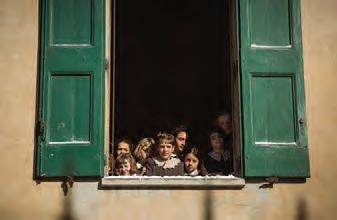
CUARÓN: But in the digital conversation, on social media—and let’s remember they’re not the majority, they’re just the loudest—it becomes very dangerous, particularly when you see these amazing voices and first-time filmmakers that are able to emerge. Because it’s important when people talk about, “Oh, cinema is this…” that they stop focusing on the same old people. Why don’t they turn and look at what young filmmakers are doing, and the amazing cinema they’re creating?
We’re navigating a new world that is in a
completely different universe from the one that Alejandro, Guillermo, and I grew up with that was the more traditional route from theatrical, to video, to TV.
IÑÁRRITU: Yesterday I was talking to a friend about coffee. A friend of mine wants to start a coffee company. He’s obsessed with coffee: the grinding, the brewing…
CUARÓN: He should call it ‘Tres Amigos’. It’s a good name [laughs].
IÑÁRRITU: Exactly. But I want to say that I was thinking about that conversation as you were talking, because we were having a big discussion about what coffee means to people who are obsessed with it. There’s this incredible tradition of simple, black coffee where it comes from the way it’s grown, the way it’s prepared, the whole thing. The way drinking it was about having conversations with friends and taking a moment to enjoy life. And then, suddenly, Starbucks came along, and it transformed the coffee habit into a faster pace. You didn’t have a coffee with a friend; you ordered it on the app, and you added gallons of cream and pounds of sugar to everything. Black coffee represents 3 percent of what they sell, and everything else is coffee with other things.
In a way, I just want to make a metaphor between that and cinema, because I think, as
DEADLINE.COM/ AWARDSLINE 33
Iñárritu with Daniel Giménez Cacho on the set of Bardo in Mexico, c. 2021.
A scene from Alice Rohrwacher’s Oscar-contending short Le pupille , produced by Cuarón.
Alfonso was saying, we’re talking about technique and story in a way that is not about the language, or the real, traditional essence of cinema, which is much more about the simple, black coffee. We’ve added so many stimulants to it, and a stimulant has to taste good and sugary from the first sip. Anything that’s a little mysterious, anything that takes a little bit of time to brew, becomes completely challenged by that conversation.
I will say that in music, even with all the streaming platforms there now, what’s happening is that kids are talking and making it their own, and there’s an orgy of musicians combining electronic with vintage, with classical, with jazz. They’re blending it and discovering new forms, and yes, a lot of it is bad shit, but there’s also so many incredible things emerging from that music. I think we’re in a renaissance for music because of it, and it’s not happening at the same pace in cinema.
DEL TORO: But it will.
IÑÁRRITU: It will, it will. But I think the kids really need the space to blend so many of the possibilities of cinema, and the danger is that if we keep feeding the audience with the sugary coffee, they won’t accept a simple black coffee anymore.

CUARÓN: Yeah, but I think it’s happening with younger filmmakers, and this year has proven it with some of these amazing movies they’re serving up that are the perfectly blended coffees [laughs].
Like Guillermo said, we must stop being so obsessed with the numbers. What is the obsession with those numbers? It’s an easy way to look at a film, but a film cannot be understood with numbers just because you’re too lazy to try to really understand cinema. All the numbers offer is a point of comparison, but we’re in a world that’s lost in statistics.
This whole conversation about the death of cinema, yes, probably it’s the death of cinema in the way that you know it, but there’s a new cinema coming up, and why would it be dying now? What would be the reason? They make the case that, “Oh, fewer people are going to the cinema,” but I don’t know: more people are hooked to their computers. We just need to acknowledge that the new generation engages with cinema differently. Of course, I love the experience of going to the cinema, and I go and see films in the theater as often as I can. But I’m by no means going to say it’s the only way to experience a film. There’s a lot of
cinema I’m quite happy to watch on a platform. The platforms are getting the biggest hit in all of this because they don’t share their numbers, without opening the conversation up to what kind of theatrical support certain types of cinema are getting.
At the end of the 1920s there was also this conversation about the death of cinema, because sound was coming in. They said it wouldn’t survive and people would stop going to the cinema. I think we need to remember that and be humbler in the knowledge that new generations are going to come and take the best out of those tools to create an amazing means of expression. So, I think cinema will prevail.
IÑÁRRITU: It used to be that you could only hear music in the concert halls, and then records came along, and then the radio. If you hear Beethoven or Mozart on your headphones, does it stop being great music? Obviously, it’s better to go to the concert hall and hear 120 musicians play it live, but no matter how you hear it, it doesn’t diminish the idea behind the music.
What I’m concerned about is less the technology, and the ways that people are watching cinema, but that there’s a dictatorship of ideas behind that. It’s about the movies that are being made to please that media. If you watch a Fellini or a Godard movie on your computer, it’s still a great movie.
It doesn’t change the power of the idea. But I think the ideas are being reduced to computer size in terms of ideology, and I think everybody is participating in that. The reduction of the idea is what we should discuss, not the possibilities of the medium.
DEL TORO: I think the size of the idea is more important than the size of the screen, definitely. Cinema—the marketing and financial side—has always tried to be constrained by rules. Right now, for example, you hear something like, “The algorithm says people need to be hooked in the first five minutes of the film,” but that was true in the ’70s and ’80s. That’s always been true. You need to have a strong opening sequence. I think the beauty is the new voices will rise against this silliness in the same way we rose against the silliness in our own time.
CUARÓN: I agree. I don’t think it’s a conversation that’ll change because it’s a lazy one. It’s easy to have, and it’s one that sells. That’s not going to change. But what will change is how new filmmakers gravitate through it, and how they make the best out of it. Older generations criticize how thin-skinned the younger generation is, but I think it’s the opposite. This generation growing up in the world of criticism and shame-giving on social networks, they’re used to it.
IÑÁRRITU: I was thinking about that the other day, how when we were coming up and making our first films, we didn’t have the social media conversation that can be so loud and overwhelming for a young filmmaker. It can be cruel, and it can be paralyzing. To have the courage to be disliked and to fail at this time is much more difficult than it was before.
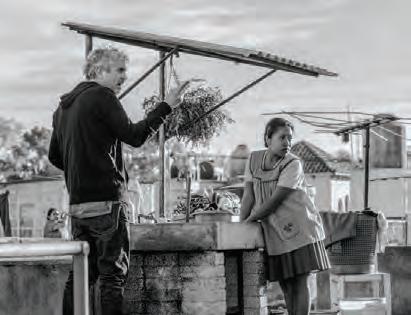
34 DEADLINE.COM/ AWARDSLINE
COLLECTION/KERRY HAYES/KIMBERLY FRENCH/2OTH
EVERETT
CENTURY FOX/NETFLIX
Cuarón directs Yalitza Aparicio on the set of Roma in Mexico, c. 2016.
Del Toro directs Sally Hawkins and Octavia Spencer in The Shape of Water in Canada, c. 2016.
DEL TORO: Yeah, and when I see a film like Everything Everywhere All at Once, and I realize how much it is impacting the generation of my kids, and how they embrace it in the same way I embraced The Graduate when I was their age, I love that. I love that people can be so passionate about a movie that reflects something to them even if the older generation don’t get it. That movie has become a landmark for one generation to be able to say forever, “That was my voice at that time.”
CUARÓN: I think it happened the same way in the the ’90s with the films of Tarantino, or with Trainspotting, where it felt like there was a huge new injection of energy into cinema, and it’s exactly the same thing for this generation with Everything Everywhere
IÑÁRRITU: I’ve always said that making a film is a miracle. It’s so difficult to make a film that anyone with a film under their arm deserves my respect and admiration whether I liked the work or not. It’s an act of courage and it’s very, very respectable. A lot of the conversation now is about the negative, but I was the president of the jury in Cannes and the first rule I gave to the jury was: “Guys, we’ll discuss the films that we see every two days. I don’t want anybody to say anything bad about any of the films. If you didn’t like the film, don’t bring it to the table. Let’s just bring what we love, and let’s fight for that.”
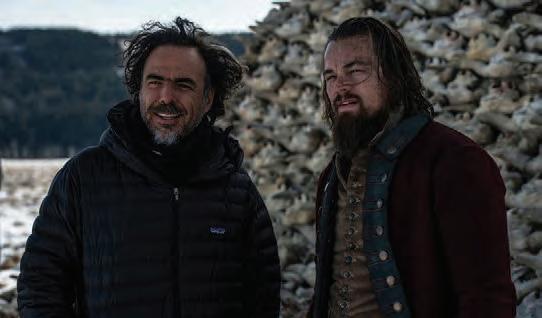
It was such a positive thing. Parasite won the Palme d’Or, and we loved so many of the films that year, but I think about what that would be like if it was a rule that everybody only ever talked about what they loved. What if the discussion of film was about the love of cinema, and that encouraged people into the theaters because we were discussing with passion the shots and the movies that changed our lives?
DEL TORO: I think that’s a good idea for a countermovement, but I like the dialectic of the negative. I actually think it’s artificial to say that the [negativity of] the discussion today is unique. What the world asks from a new storyteller is to have a life examined, meaning that it’s a time to examine or position in the social structure, 100%. That’s a valid position. And don’t forget the fears we all had when we
were first coming out. We were full of fears. I was told over and over again, “Don’t try to do genre, because genre doesn’t have artistic validity.”
You’re always surrendering yourself to existing structures. That was our conversation, and [this generation’s] conversation is complex in the same way, about privilege, about origins, about social responsibilities. I think that’s good and healthy.
It’s an interesting time for those voices to rise against those fears, because art definitely cannot be born out of fear. But it’s our responsibility for each of us to talk about the love of this and that.
I like that people don’t like the movies I make. I actually like it [laughs].
IÑÁRRITU: I want to clarify that I’m talking about the obsession with negativity, and I’m not saying it doesn’t work or isn’t needed when it’s something like what we were talking about between us, where it comes from something that can be constructive to receive.
The more I enter and belong to the best clubs I want to belong to, I’m less afraid of that negativity,
but I say that as a 60-year-old man with a career. For younger people, I think it can be more traumatic, and I think the language of it becomes important: that it should be useful, pointing to what doesn’t work, and not destructive. And I think the conversations can often become destructive.
CUARÓN: That kind of conversation will always exist, but it’s OK to expose it. It’s a lazy way of looking at things.
DEL TORO: It’s always interesting generationally that when you think an artform is dying, what is really dying is the way you understand that artform. The artform will continue after we are all dead, and I think part of it is to know when your time has come, and when it’s time to listen more and talk less. What has happened with the medium has happened because the market changed, and the market changed because audiences dictated what they wanted. The dialogue continues and it transforms.
We’re going through a mysterious transition, and I don’t think anyone knows exactly where we’ll land as a society in five years, much less as an artform, but part of it is acknowledging that it’s not your cinema anymore. It belongs to the next generation. They’re in charge, not us.
I’ll tell you, younger filmmakers like Ari Aster, or the Daniels, or Chloé Zhao, these filmmakers are brave and they’re sturdy. They’re really very solid. I think the beauty of cinema, and the beauty of our generation and our voice, is that we didn’t invent it and we’re not going to save it. It’s going to go on without us, and that’s the beauty of it.
And I think part of the wisdom of understanding that is knowing when to shut up, so we should end the conversation there [laughs]. ★

DEADLINE.COM/ AWARDSLINE 35
A scene from Guillermo del Toro’s Pinocchio.
Iñárritu directs Leonardo DiCaprio on location for The Revenant , c. 2014.
The Best Of 2022 | Contenders
Not long after, you got an email from him saying he’d written a part in The Banshees of Inisherin specifically for you.
I couldn’t believe it. I remember Colin, while we were doing The Killing of a Sacred Deer, saying that Martin had a part in a movie he hadn’t finished writing that he thought he might want me to play. So, after that first meeting, he emailed me, and we met in New York. I put it down to a law of attraction thing of working hard toward what you want, because I had a picture of him that was the background on my phone. Literally seconds before he showed up, I thought, ‘I’d better take this off because it’s a little weird if he sees I’ve got a picture of him on my phone.’ In the end, I told him about it anyway, and he laughed his socks off.
We were due to shoot it a couple of months after that, but then Covid hit, and it gave us a year and a half to sit with it. That time really helped.
Barry KEOGHAN
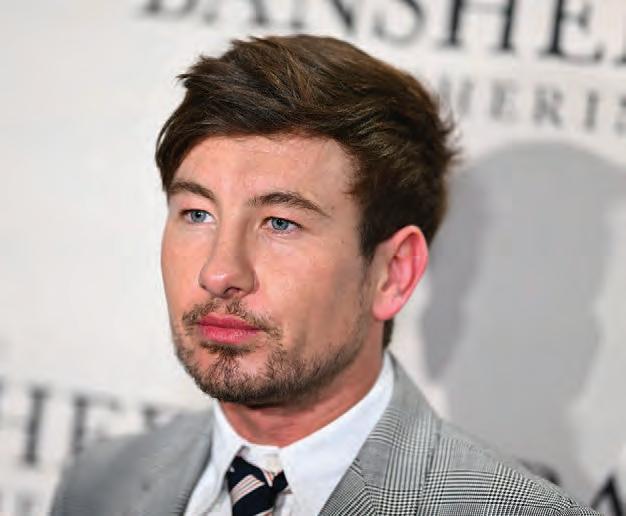 BY JOE UTICHI
BY JOE UTICHI
Martin McDonagh’s The Banshees of Inisherin promises a reunion of the In Bruges team of Colin Farrell and Brendan Gleeson, and it overdelivers, featuring supporting performances from both Kerry Condon and Barry Keoghan that are attracting the attention of awards groups internationally. Keoghan has had a charmed run in recent years, crossing directors like Yorgos Lanthimos, Christopher Nolan, David Lowery and Chloé Zhao off his list of must-work-withs (and there’s a literal list). And he was the highlight of this year’s The Batman, becoming the latest actor to play the Joker, even though his single scene didn’t make the final cut.
You assembled a list of directors you wanted to work with, long before you ever started landing roles in movies. You’ve worked with many of those directors already, but Martin McDonagh was right up top, wasn’t he?
He was a big one. And can you remember—make sure you get this in the piece—that you were the one that first introduced me to Martin? It was at the Fox Searchlight Oscar party in LA the year of Three Billboards Outside Ebbing, Missouri. You brought me along to the party and I remember talking to you that night and saying thank you, because I’d always wanted to meet him. I was in awe. You definitely deserve credit for this one.
He told you he was already a fan, so my contribution was minimal.
You hit it off right away, but as a fan of his work, was it a challenge to get past that feeling of awe that you described?
Martin’s just a legend, man. When you get to know him, you realize he’s just a big kid. He’s so excited, and eager to go to work. When you work with someone of his caliber, you’re always quite nervous because you go in knowing you have to be on your mark. But he was open to discussing everything, and we’d have debates about how far we should go with every scene. With a character like this, you don’t want to play around so much that he comes across as being comic relief; we wanted to make Dominic feel as real as possible. But sometimes you had to push it a little further, or pull it back, and Martin knows exactly what he wants at all
36 DEADLINE.COM/ AWARDSLINE
ROY ROCHLIN/GETTY IMAGES/JONATHAN HESSION/SEARCHLIGHT PICTURES/COURTESY
COLLECTION
EVERETT
up-and-comer is at the
The
The Irish
heart of Martin McDonagh’s
Banshees of Inisherin
★ ★ ★ ★ ★
times—like any great director—and he put me in the right lane for it.
Let’s dig into that complexity. How did you draw the line between the tragedy of Dominic’s journey in the film and the levity he brings to Inisherin?
It was a very fine line and having the right motivation behind every scene became very central to what Martin and I discussed; what felt real and what didn’t. You also have to measure yourself up against Colin, Brendan and Kerry. There were times when you knew you had to go big and times when you needed to keep it contained. I became adept at turning to Martin after every take and checking in. “Did I do too much?” or, “Do I need to bring it up a little?”
It was heartbreaking to read Dominic’s story on the page. He’s a guy who says it like it is, and on an island like that where everyone’s reserved and talking behind everyone else’s backs, it’s good to have that view on stuff, where it’s a different angle that he sees the world from. He has a naivety, but he also has a great intelligence. All he really wants is for everyone to be happy, and he’s a character who lives day by day. It’s really sad that everyone on the island has made up their mind that he’s a little feckin’ eejit, or whatever. But I see no harm in him. I could relate to him in that sense of wanting to be true and honest, and sometimes that honesty can sting.
The character was challenging, but at the same time I couldn’t have asked for a nicer movie to be a part of. Colin, Brendan and Kerry are all feckin’ brilliant, and being from Ireland, it had a feeling of home. There’s a language there I understand. A brogue. So, for all of the challenge, it was also a blessing. I just hope I get to do it again with them.
Martin McDonagh has assembled a bit of a troupe. Colin, Brendan and Kerry have all worked with him multiple times on stage and screen. It may not be your only call. Hopefully. Honestly, I’ve been blessed to work with some of the most amazing filmmakers, and you learn so much from them. But I still have the same determination and drive that
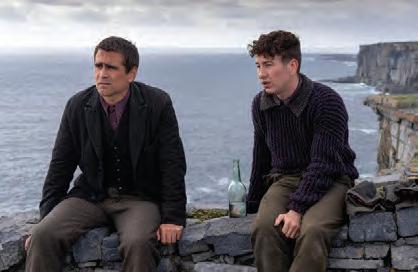
I had when I started out doing this job, to go where I want to go. It’s not about fame or recognition, although it’s beautiful to be recognized for your work. It’s about challenging myself, breaking stigmas and stereotypes, and seeing how far I can push myself with what I play.
You’d come off two big movies—
The Batman and Eternals —and this was a return to set from Covid lockdowns. Given you grew up in inner Dublin, did that pandemic life give you a sense of the isolation the script was dealing with? That for all of the real traumas present on this tiny island, for some reason the residents are all focused on two friends falling out.
Definitely. It’s incredible that this breakup is what holds our focus. And it is a breakup story, although you don’t usually see it in the context of two friends drifting apart. It hits you because loneliness is scary. It hits you because things like that have happened to all of us—certainly to me— growing up, where it’s not so direct but where someone just stops wanting to be friends with you. It’s fucking heartbreaking; you start questioning yourself. The collage of everything in this movie engages you. It takes you along for the ride and it’s enjoyable.
You know, I’ve been watching it all Christmas. People have come over to the house and I’m like, “Want to watch Banshees?”
Seriously?
Well, my girlfriend’s usually the one
making everyone watch it, but I don’t exactly stop her. I’ve seen it four times now. Once in the cinema and three times on Disney+. I’m very proud of it. I know we’re always critical of our own work, and that’s a healthy thing to an extent, but with this I just thoroughly enjoyed the ride, so watching it is a pleasure. And every time you watch it, you pick up new details. It’s like a play whereby every night it evolves. That’s hard to translate to screen, but Martin has done it.
This is your third movie with Colin Farrell. What has getting to know him meant to you, personally and professionally?
I’m a massive fan of Colin’s work, and of Colin as a person. We’re always chatting. I swear, when you see your friends get attention for their work you think it’s great and brilliant, and you’re so happy. But when it happens to someone as genuinely lovely and supportive as Colin, it means all the more. He has a genuine care for other people, and I see him chat to people who he hasn’t met before, and he immediately engages them and makes them feel heard. It’s a rare skill, and Colin has been like that for me from day one. He’s been so helpful in a million ways, and he’s a massive mentor to me.
Let’s get back to that list of directors you wanted to work with. Are there more collaborations on the horizon? Well, I’m about to work with someone else on that list. Now, this is not a list that contains 100 filmmakers.
It’s a list of maybe 35 or 40, max. And I’ve managed to check off quite a few. The one thing I’ll say has changed for me after doing a few movies is that the opportunities are there more than they were. But my determination and will to keep elevating and diving deep into characters, and figuring stuff out about myself, has only really gotten stronger. It’s just that now, because people have seen me in stuff, it’s easier to get in a room.
Are you actively pursuing those names on that list, or are they coming to you?
It’s more of a law of attraction thing. I’ve always made lists. Things that would bring me contentedness, happiness and health. I don’t get too specific about it, and I don’t ask for ridiculous stuff, but I always write it down; put it in print. I don’t believe in luck and I’m quite religious, so I have faith. And the law of attraction is preached on a level where it’s not like you say, “I want a nice car,” and you get a nice car. It’s more about opportunity. “Give me the opportunity and I’ll work for it.” If it doesn’t happen, it doesn’t happen, but it has felt like there’s someone out there in the universe who’s listening to me.
It's quite remarkable what I’ve written down that’s come true, man. It’s freaky, to be honest. I don’t chase these people. I don’t bombard them. But I’ve had the opportunity to walk in their space and be in their circles— like when you brought me along to that party and introduced me to Martin—and the rest has followed. It’s not just in the acting world that I’ve been asking, either. In life, too. I think: be good and receive good, you know?
I just want to try everything. Not just in the industry, but outside it. I’m putting down carpets three days a week at the moment, with my girlfriend’s brothers, because they have their own company. Using my hands and learning the craft. I’m doing a bit of boxing again. I’ve been doing falconry. And I’m learning how to be a father, with my 6-month-old Brando. That’s a fulltime job in itself. I have a massive interest in the world outside of acting, and so trying a bit of everything is very important to me.
★
DEADLINE.COM/ AWARDSLINE 37
From left, Colin Farrell as Pádraic Súilleabháin with Keoghan as Dominic Kearney.
Chinonye CHUKWU
TILL
Where were you when you first learned about the murder of Emmett Till?
I don’t know the exact moment. I believe I’ve known since elementary school, but I didn’t really know much. What happened to Emmett was like a footnote in a history book, and that was it. So, I didn’t really know the story. I think a lot of people don’t know the story, and they definitely don’t know a lot about [his mother] Mamie and her journey and her contributions, or even much about Emmett as a person.
With such difficult material, how did you go about protecting yourself, and your cast, against any sort of emotional backfire?
We had a therapist on set every day, and she was a resource for the cast and crew. For myself, as a filmmaker, the first part of my care was in how the story was told. This is a film about Mamie Till-Mobley. It’s about a mother and her love for her child. This is not a story about the physical violence inflicted on a Black body. And so I was very declarative about that from the very beginning, and then I just kind of went from there. I knew that that was the story I wanted to tell, and I knew that showing physical violence was not necessary. My experience as a Black woman, and the experience of a lot of people who are part of marginalized communities, is so much more than just the pain that is inherent to our existence on this earth. So, when I thought of this film, I never saw it as just a quote-unquote “trauma school”, because that would do a disservice to the lives, to the dignity, of the people involved. —Valerie Complex

38 DEADLINE.COM/AWARDSLINE
MICHAEL BUCKNER FOR DEADLINE
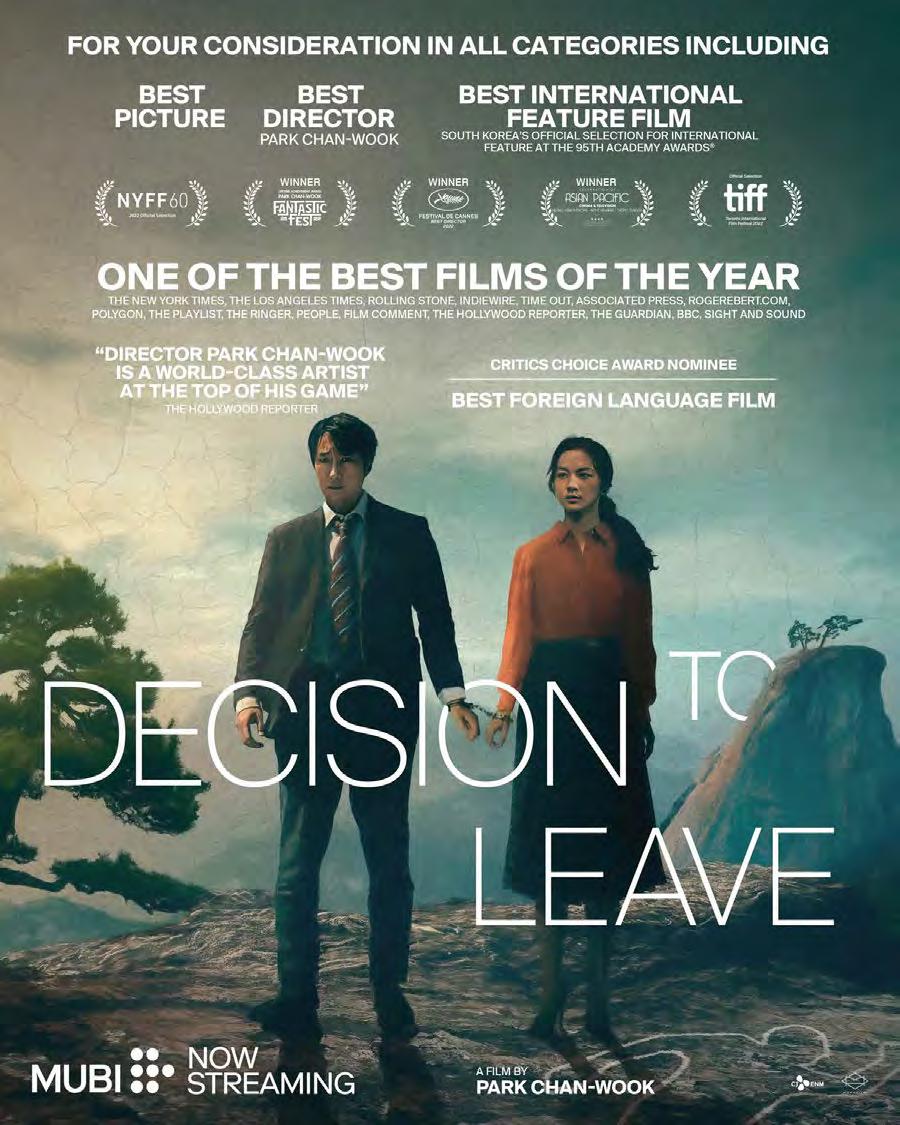
Greta GERWIG
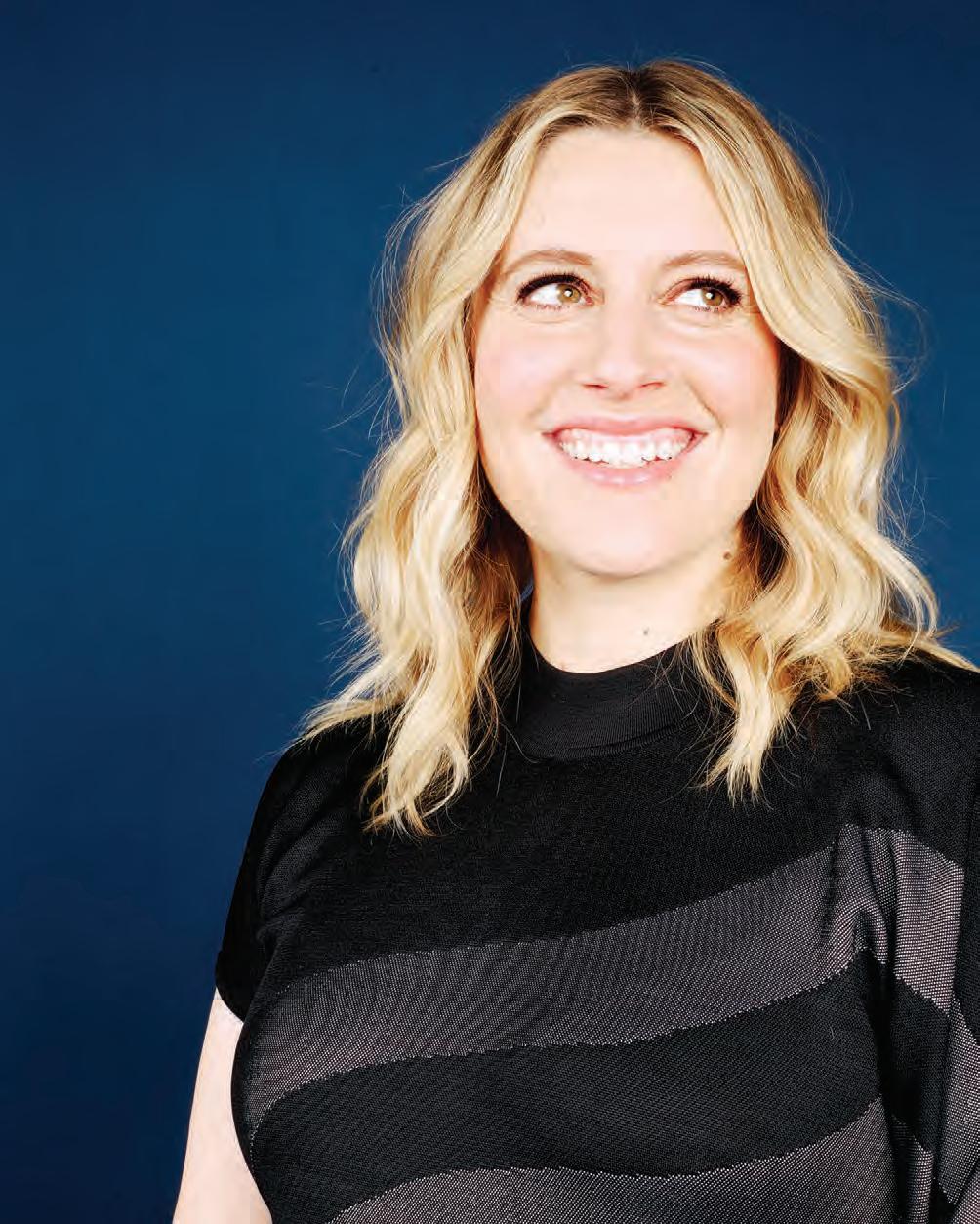
WHITE NOISE
White Noise is Noah Baumbach’s first full-on literary adaptation, a take on Don DeLillo’s novel from 1985. What was the process like? Yeah, this is the first time he’s done an adaptation, but it felt so natural. He was reading it just at the end of 2019, going into 2020. He’d read it when he was younger, and when he read it again he was struck by how much it seemed to be about right now. And then as soon as the pandemic hit, it became even more about right now. I mean, it’s hilarious. It’s dark, it’s crazy, and it understands how we can’t cope with anything. Obviously, it’s Don DeLillo’s genius, but it felt connected to the kind of writing Noah does. So, he started working on the screenplay, then he gave me some pages and said, “What do you think of this?” I was just extremely jealous, so I knew it was great.
How quickly did it come together?
He’s very diligent about working—he just sits at the dining room table and turns out these pages. I suffer more [when I’m writing], and I feel sort of inadequate [laughs]. But, yeah, he just turned these pages out and I was like, “Oh, this is brilliant.” It became so quickly a movie. And it’s funny that the narrative of the book is that it’s unfilmable, because, I think to both of us, it felt just instantly cinematic. It had all of these cinema genres in it already. It had, like, a family comedy, it had a disaster movie, it had a sci-fi movie, and it had a deep marital drama. —Dominic Patten
40 DEADLINE.COM/AWARDSLINE
MICHAEL
BUCKNER FOR DEADLINE

Park CHAN-WOOK
BY DAMON WISE
Bong Joon-ho may be the national hero for bringing home the Oscar for Parasite, but it was Park Chan-wook who first blazed the trail for Korean cinema. After two false starts, his career began in earnest in 2000 with Berlinale hit Joint Security Area (J.S.A), a military thriller set in the no-man’s land between North and South Korea. In the years since, Director Park has been a quicksilver talent, never repeating himself and bringing savagely original twists to genres as diverse as the vampire movie (Thirst), the erotic thriller (Handmaiden) and manga (Oldboy). His latest, Decision to Leave, a perversely modern whodunnit, is no exception.

What were your thoughts going to Cannes with Decision To Leave?
I guess I don’t really have a concept of such a macroscopic view of my career. I don’t think I ever had that comprehensive look back at my career. It’s always more of a case-by-case and day-by-day assignment. But I do remember worrying about how this film has less violence and portrayals of sex. So I was a bit concerned about whether the audience would be disappointed by that.
But you seem to have hit a nerve. Given the success of Glass Onion, people seemed to have been looking to invest in those kinds of mystery stories this last year.
I do believe that that kind of story that you’ve mentioned is the joy of the oldest kind of genre film that’s
been around. So many films have been made with such kind of mystery. So what’s really important is to express that in a new format, and also personally for me, how to combine that with a story of love.
I couldn’t help thinking also you were drawing parallels between a detective and a director in the sense that the detective is looking for the perfect mystery in the same way that a director is looking for the perfect story.
Yes. A director has to create the perfect mystery and also to solve the mystery, whereas a detective is only tasked with the task of solving that mystery. A director’s job is to put the puzzle pieces together, but also to create those puzzle pieces themselves. That’s it.
42 DEADLINE.COM/ AWARDSLINE
The director of hit Korean thriller Decision to Leave explains how less is much more when it comes to creating tension
★ ★ ★ ★ ★
FLORES
GILBERT

When you were starting out, how was the film industry in Korea? When I did J.S.A., that’s when the boom of the Korean film industry began, and we were allowed to propose more bold ideas for movies. For instance, if you think about J.S.A., it actually had the potential to go against government laws. And if the government wanted to sue the film, they could definitely go ahead and do that. So if I were to put it more dramatically, this was a movie that could send me to jail. But we were able to make that film because the industry had that power of commercial investment, and I was able to also cast the best stars of the time in that film. So if I were to put it simply, the industry had the commercial energy to make these films and the artistic courage to try something new.
But then, it seems, you found your style very quickly.
To some extent, I do believe it was inevitable because I did not graduate film school. In Korea at the time, the only movies that were released in theaters would be contemporary American or Korean films, and whenever I watched those movies, I wasn’t that greatly satisfied. So, I really wanted to make a movie that would satisfy me and a movie that I would want to watch. I’ve always had that thirst for something that could satisfy me in that way. That’s why whenever people who have studied or traveled abroad would come home and tell me about the movies of Ingmar Bergman or [Pier Paolo] Pasolini, I did not have the opportunity to watch them, so I would imagine what kind of movies these movies were. So, I want to call my style a self-studied kind of style. It’s not influenced by a particular director’s work or included in a particular school of work. It’s a style that kind of does whatever it wants to do.
Oldboy was a huge film for you, but were you ever frustrated that, for a time, it kind of pigeonholed you as a horror director? Was it a curse as well as a blessing?
I actually continued to make those kinds of films even after Oldboy, so I don’t think it’s fair to call it the curse of Oldboy. I’ve just been making the things that I want to make.
I just meant that people had a preconception of what kind of director you would be.
I haven’t been extra conscious of the expectations for me, and I’ve never made films to satisfy those expectations, so it’s never really bothered me.
You’ve only made one film in America and it’s often forgotten. I wonder how you feel about Stoker now, because this is a film that is shaped by other people’s narrative, not yours. It’s framed by the typical narrative of an outsider who goes to Hollywood.
This was the first movie that I made that had a script that was written by somebody else. But even though I wasn’t credited, I actually made a lot of revisions on the script myself. So just like my other films where I wrote the script myself, like Oldboy or J.S.A., these works are actually adapted from an original work. They’re adaptations. So you could kind of see it in that similar way of an adaptation. Also, for instance, Handmaiden was adapted from a novel, but I made that creative adaptation myself.
So as much as it is a story by Sarah Waters, it is also my story, and that’s how I feel about Stoker. But all the people involved with the making of that film were such brilliant people.
It was actually one of the happiest times that I spent making a film. And I’m equally highly satisfied with the final product. Just as in Stoker, I always want to return to [making] a drama with a small number of people in an isolated tight space and seeing the drama that unfolds there. Using a minimal setting to create maximum tension, I think that is the purest form of cinema.
Handmaiden was your biggest and most ambitious project. Were you surprised it became such a success? To me, it’s probably your wildest film.
I don’t really think there’s a director who makes a film thinking it’s not going to be a success. Even though there were dangerous elements, I had confidence that the story would connect with audiences. The love story between our two protagonists is very endearing, we end on a very touching, happy ending, and the plot is entertaining. It’s filled with tension, and it never bores you. So I wasn’t too surprised to see its commercial success.

A few years ago you ventured into streaming with The Little Drummer Girl ? How has that worked out for you?
The author of The Little Drummer Girl, John le Carré, has always been a hero to me, so I’ve always wanted to adapt the work of his. But I couldn’t quite find the right opportunity to do so. And that’s when I ran into the
conception of this work. So even among all of the le Carré fans, I think this is actually one of my favorite works. It almost felt like a story written for me. And to put it in a more extreme sense, it almost felt like a story that I wrote myself.
This was the first time that I worked on a television series. And even though the quality that we’ve ended up with both regarding the visual and the audio is high enough to be worth seeing it in a theater, it’s kind of sad to know that it won’t be seen in a theater. But on the bright side, we did not have to crop out the stories from the original work to fit into that feature-film timeframe, and on top of that we could have the opportunity to express the details of the supporting characters, both in the Mossad group and the terrorist group as well. All these supporting characters have the chance to be expressed in great detail. So those kind of upsides made me feel better about not having this shown in a theater.
What are you working on now?
I’ve been working as the showrunner of the HBO series The Sympathizer. The history of Vietnam is something that Koreans can empathize with because it’s very similar to the history of Korea. For instance, the element of the civil war within Vietnam between the south and the north, these are elements that I can empathize with as a Korean. So I’m very fortunate to have found a project that interests me like this. It tells the story of Vietnamese immigrants after the war settling in the U.S. and then returning to Vietnam as well. On the outside it might seem like just a simple espionage work, but it has a lot more depth to it and I do want to also label it as a humanistic drama piece.
In the meantime, what are your hopes for 2023?
My hope is for the pandemic to die down more, to completely go away, so that theaters can be full of people just as they were before. ★
44 DEADLINE.COM/ AWARDSLINE
CJ ENM CO./MOHO FILMW
Park Hae-il and Tang Wei in Decision to Leave.
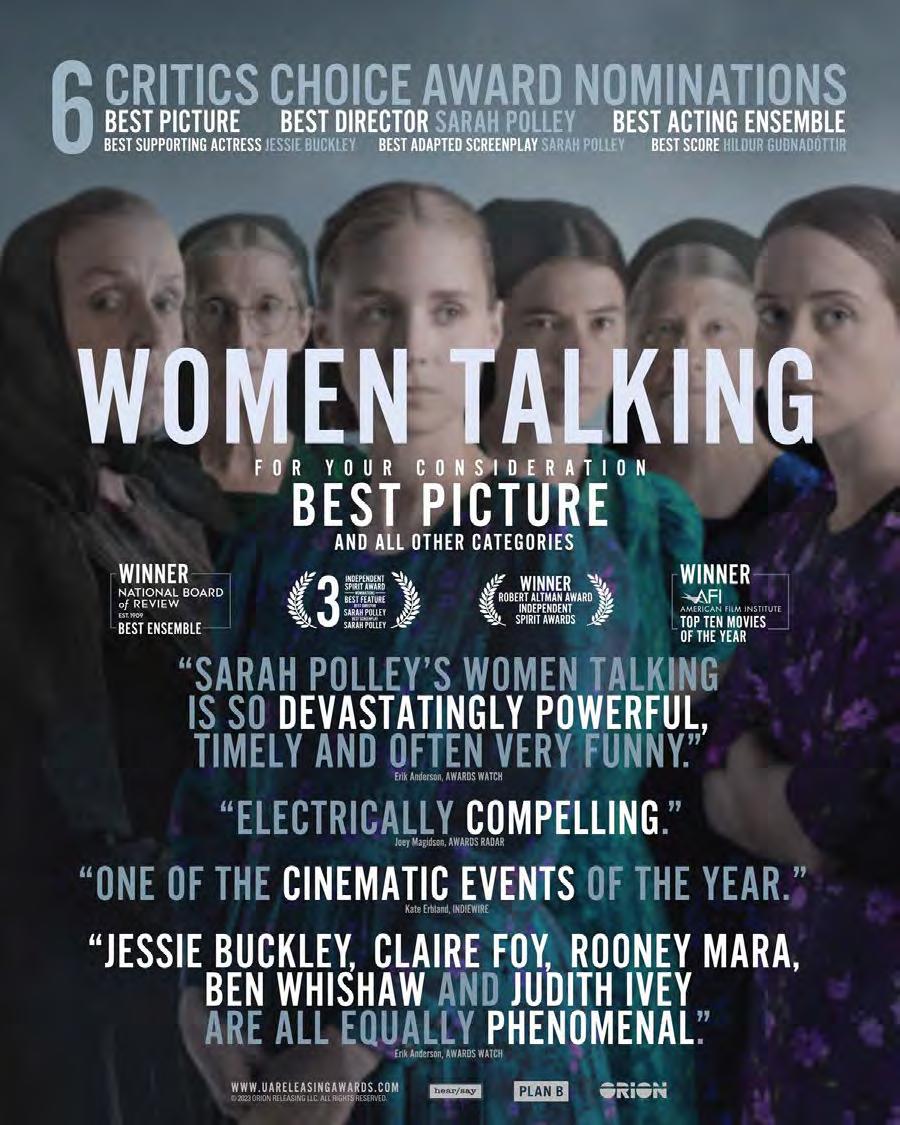
Jessica CHASTAIN
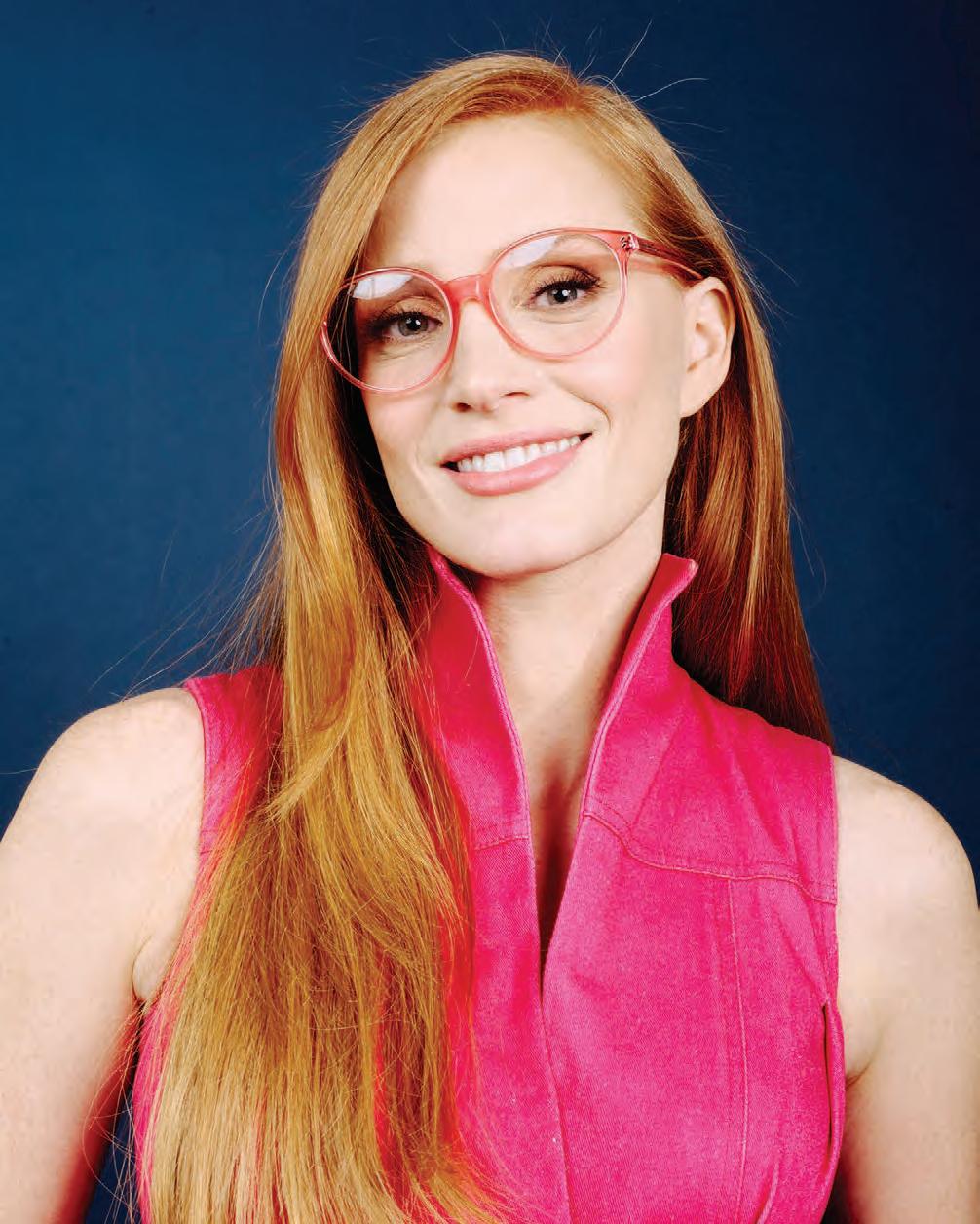
THE GOOD NURSE
In The Good Nurse you play Amy Loughren, who helped catch medical serial killer Charlie Cullen. What’s it like to take on somebody’s life and play them knowing that they’re there on set and they’re watching you?
Oh, it was incredibly intimidating. It’s the very first time I’ve ever been observed playing scenes from someone’s life by them. Even on Molly’s Game, Molly Bloom never came to set. A lot of people think that things were made up for the movie, to make it more Hollywood and entertaining, but no. It was incredible to have the gift of her generosity, and the fact that she was there to talk us through everything was incredibly helpful. I mean, I found ways into the character that only came from my conversations with her.
The film is also an indictment of the American healthcare system— this guy worked at eight or nine hospitals and they never did anything about it.
Yeah. What I love so much about this film, and why it feels so different from other true-crime stories, is that, to me, the supervillain of the story isn’t the person committing the violence. It’s the organization that allows it to exist, in terms of turning a blind eye to it for profit. It was interesting to have a director [like Tobias Lindholm] who isn’t an American, who’s from a country that has healthy healthcare, who could come in and look at why this happened and why it could happen again.
—Pete Hammond
46 DEADLINE.COM/AWARDSLINE
MICHAEL
BUCKNER FOR DEADLINE
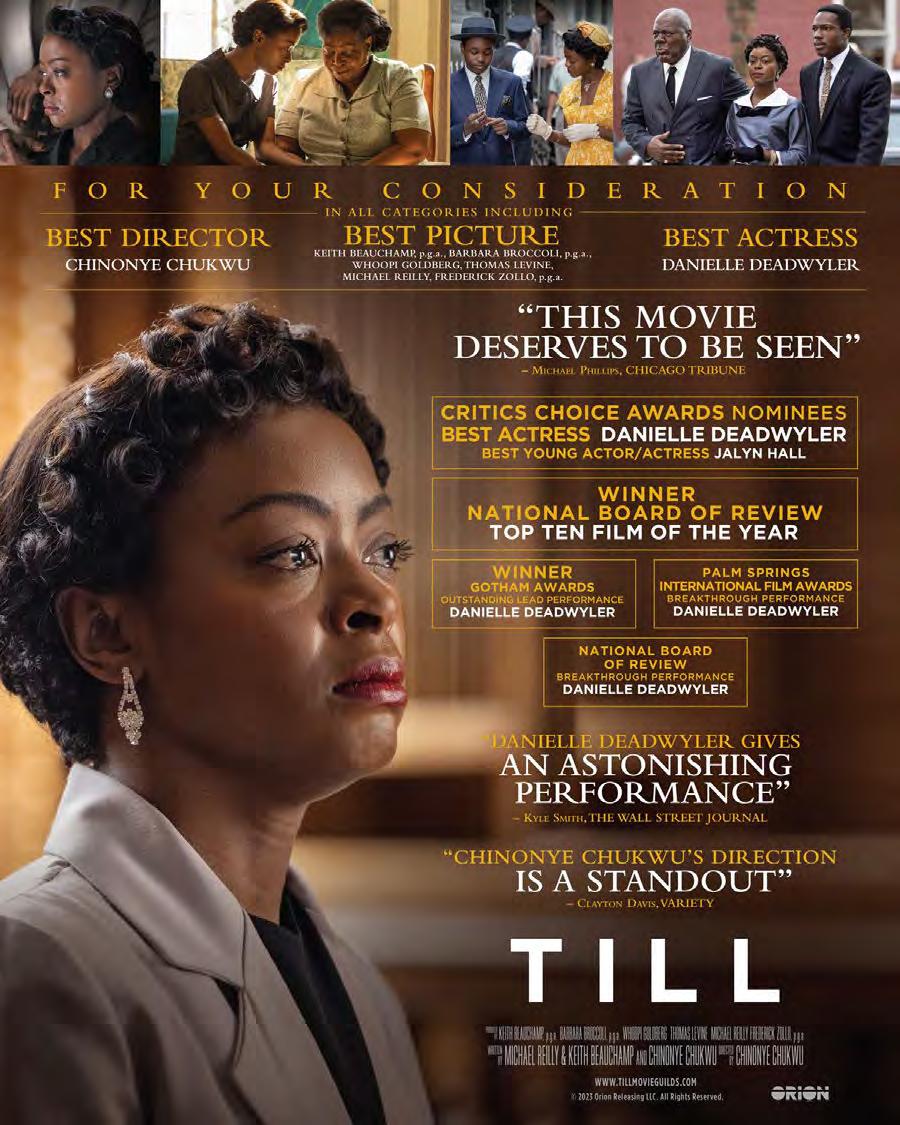
Eddie REDMAYNE

THE GOOD NURSE
The real Amy Loughren still can’t believe Charlie Cullen did what he did, and thinks it was somebody else within him. How difficult was that to play?
In the prep, Amy talked to Jess [Chastain] and me about her love for this man, how kind and gentle and self-deprecating he was, and the fact that he saved her life. And then she met this other human being twice, once was when she was [wearing a police wire], and again in the interrogation room. She described how his eyes glazed over and he became a different human being. That was such a revelation for us, because it meant that we could tell this story truthfully. It was about a friendship, and I suppose in some ways it was a love story. Tobias [Lindholm, director] would do these amazing long takes in which we would play the scene and perhaps improvise slightly around it, and it was always the moments after the moments that he was capturing that had this unnerving quality. That was when you got a glimpse into this other side of him.
Was it intimidating ?
Honestly, despite the subject matter being really intense, the making of this film was one of the great experiences of my life. We had an extraordinary time making it, and I think one of the reasons was that Tobias is one of those rare directors that asks for— or demanded—proper rehearsal time. So we had a month in which Jess and I went to nurse school, and we worked with Krysty Wilson-Cairns, our brilliant screenwriter, so that by the time we started filming we were all telling exactly the same story. Our resources were fantastic, from the ICU nurse who was on set every day with us, so that everything about the experience was as authentic as possible. —Pete Hammond
48 DEADLINE.COM/AWARDSLINE
MICHAEL BUCKNER FOR DEADLINE

How the multi-hyphenate made a moving miniature microcosm in Marcel the Shell with Shoes On
BY ANTONIA BLYTH
Jenny Slate is pretty memorable as an entitled dry-cleaning client twirling a chihuahua around her head in Everything Everywhere All at Once, but it’s her role as an animated shell with one googly eye that really captured attention this season. In Marcel the Shell with Shoes On, we’re given a full-length feature version of the character Slate co-created with director Dean Fleischer Camp back in 2010. Voicing Marcel and leaning into her improv skills to help cook up the comedy character’s quirky and poignant dialogue, Slate explains why she thinks Marcel’s miniature perspective has inspired so many, and why this gig suits her so much better than SNL ever did.
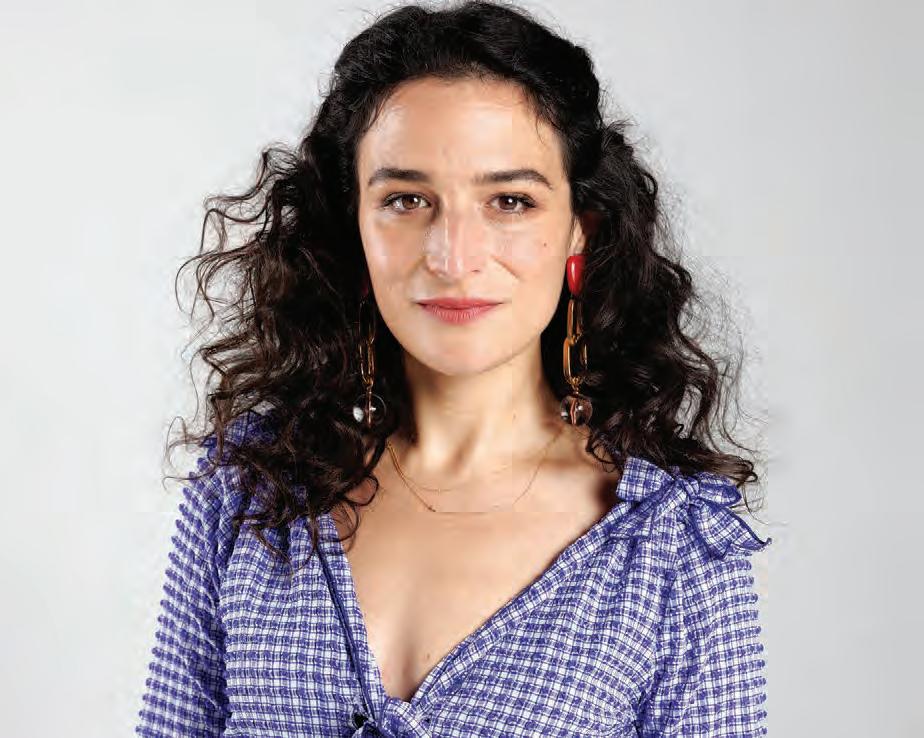
Years ago, you came up with the voice of Marcel when you and Dean and some friends were squashed into a hotel room at a wedding. What part of you was speaking through Marcel back then? Because doing voices can sometimes be about expressing a thing you wouldn’t normally say. And sometimes that’s right. One of the reasons why I was not the right fit for a show like SNL is because I’m really bad at impressions of famous people. I can do an impression that, in its emotional expression, sounds a lot like someone in my personal life, like my mom or my baby, but am I going to be able to give you a really good Lady Gaga? No, I’m horrible at that and I don’t really want to, because there’s only one of those in my opinion.
You don’t go there because you don’t actually want to do it?
Yeah, I don’t really want to. And that is also another thing about me, you can’t make me do what I don’t want to do. And I really honestly am a person who aims to please, so that has always been a source of conflict for me. But the voice of Marcel is like somebody making an abstract painting to try to describe a set of feelings that they have. That’s as close as I can describe it. There are these moments in your daily life when you feel small and you feel needed, that you need to be heard. You feel insistent, and also gregarious and likeable and ready to party. You put that all together and it comes out in this weird tight stream. And that’s what that voice is. To me, the character of Marcel is me if I could really
50 DEADLINE.COM/ AWARDSLINE
★ ★ ★ ★ ★
Jenny SLATE
POLK/GETTY IMAGES FOR IMDB
RICH

be considerate of and connected to other people, but just be a little bit less freaked out by what they think of me. And Marcel’s pretty relaxed into his own state of being.

I feel like that’s a chunk of his broad appeal, the simple purity of self-belief in Marcel.
When I think about the film, what I find relieving about it is that what stuns, hurts and wallops Marcel the most is also what sets him free to take his largest risks and feel his greatest power, which is that the world is infinite. It’s huge. Of course, you can be lost in it. It’s really, really frightening when you have a particular aim to connect and then you realize how much could possibly get in your way. How much distance is able to exist—distance that you can’t even measure—and how you’re not just in your house, your town, your country, your continent, or on the Earth. You’re in the universe, and it can really, really hurt to know that. But your smallness is a part of that. And it’s not smallness, it’s just existence and presence… I just love it. It makes me feel so good.
Back in 2010, this was a little short. You didn’t expect anyone to see it and then suddenly, millions were watching on YouTube. It took seven years to finish the feature, but how did the film come about? I don’t think we intended for it to take seven years. And we had a Covid shutdown as well. But first it was me and Dean, and we were writing these ong documents, which turned into treatments, and we were like, ‘There is a movie.’ Then we brought on Elisabeth Holm, our incredible producer, and she also helped create the story with us. And then Nick Paley, who ended up being our co-writer, and who is responsible for many of the beautiful moments in the movie. He’s just an incredible writer and his writing and state of mind reminds me of how the Shakers made their furniture. It’s so functional and it’s aesthetically pleasing
in a way that just is perfectly in the zone. It’s not too little, it’s not too much. It’s exactly what you need for the appetite you have.
Liz introduced us to the folks at Cinereach and they were our clear partners in that they were really good at giving us creative notes. They were really involved in shaping the film, but they also really let us have the final say. And when we did come to them saying, “Look, we’re going to need a little bit more of everything,” they considered it seriously and came back and gave us what we needed in order to make the film that we wanted to make. And that’s Philipp Engelhorn, who started Cinereach. I don’t know that I’ve ever met anyone who actually really knows how to support artists in the way that Phil does. And the film wouldn’t exist if he wasn’t there. It’s really Phil and the people that work with him, Caroline Kaplan and Andrew Goldman and Paul Mezey. They’re incredible.
Isabella Rossellini plays Nana Connie. Did she immediately get what you were doing? Is that why she wanted to do it?
When she got to the house where we were recording, Isabella said that she didn’t know what Marcel was, and that her kids told her. She is really an adventurer. She just seems to be, to me, someone who wants work that impacts her senses. She had a lot of questions. And the interesting thing is, sometimes if an actor
shows up to set and they suddenly have a lot of questions, it can be scary for them. A lot of people want to know what they’re getting into. But for Isabella, the questions were just exciting to her. She trusted that we had the answer. I don’t think she had done a lot of improv before and she was really keen to get in there. There was no hesitation. There was no, “I’m feeling silly.” There was no question about, “Why do I have a microphone taped to my forehead?” Instead, she just fully jumped in, and I felt that even though we had been working on the project for a while, the way that she was so confident and self-possessed set a tone for me, that I should also just come in there and totally inhabit.
So it’s essentially improv that you re-work over and over and then you pick out the gems? Well, it’s multi-layered, and I think we try to talk about this really carefully because Dean and Nick did so much work on the actual script that exists. But that said, I also did a lot of improv... It would be like, now we’re going into the bathroom, and Marcel is telling Dean how he makes the rope out of pubes. But then from that, you get the improv of, they’re called ‘hardy hairs’ and you can hear Dean laughing.
Sometimes the way you hear him laugh in the film, you know it’s the first time he’s heard something. Yeah, it’s really, really nice. And
then there are other moments that are totally written. Marcel, how he climbs up the wall with the honey and things like that. So, we would record, then Dean and Nick would go through the audio, shape it down into a more understandable story, because we had so much improv and so much audio. And then from that, they would say, “Well OK, so we thought this moment would really land, but it turns out there’s not much there. What scene should be in its place? Should the story take a different turn here?” And then they would write to that. And then we would go back and re-record and reimprovise within that script and find more space. And then they would come back and write more and clarify what had been said. And then we would re-record again.
Is there a favorite line from Marcel that still gets you every time?
I really like the last part in the laundry room. It soothes me and reminds me of how I am capable of feeling. Oh man, I don’t know. I love so much of it. I’m not sure that I have a favorite line today, but I really like when Marcel says that he’s angry that he didn’t get a better goodbye.
★
52 DEADLINE.COM/ AWARDSLINE
A24/COURTESY EVERETT COLLECTION
Marcel studies a map in Marcel the Shell with Shoes On
The character of Marcel is me if I could really be considerate of and connected to other people, but just be a little bit less freaked out by what they think of me.

Ryan COOGLER
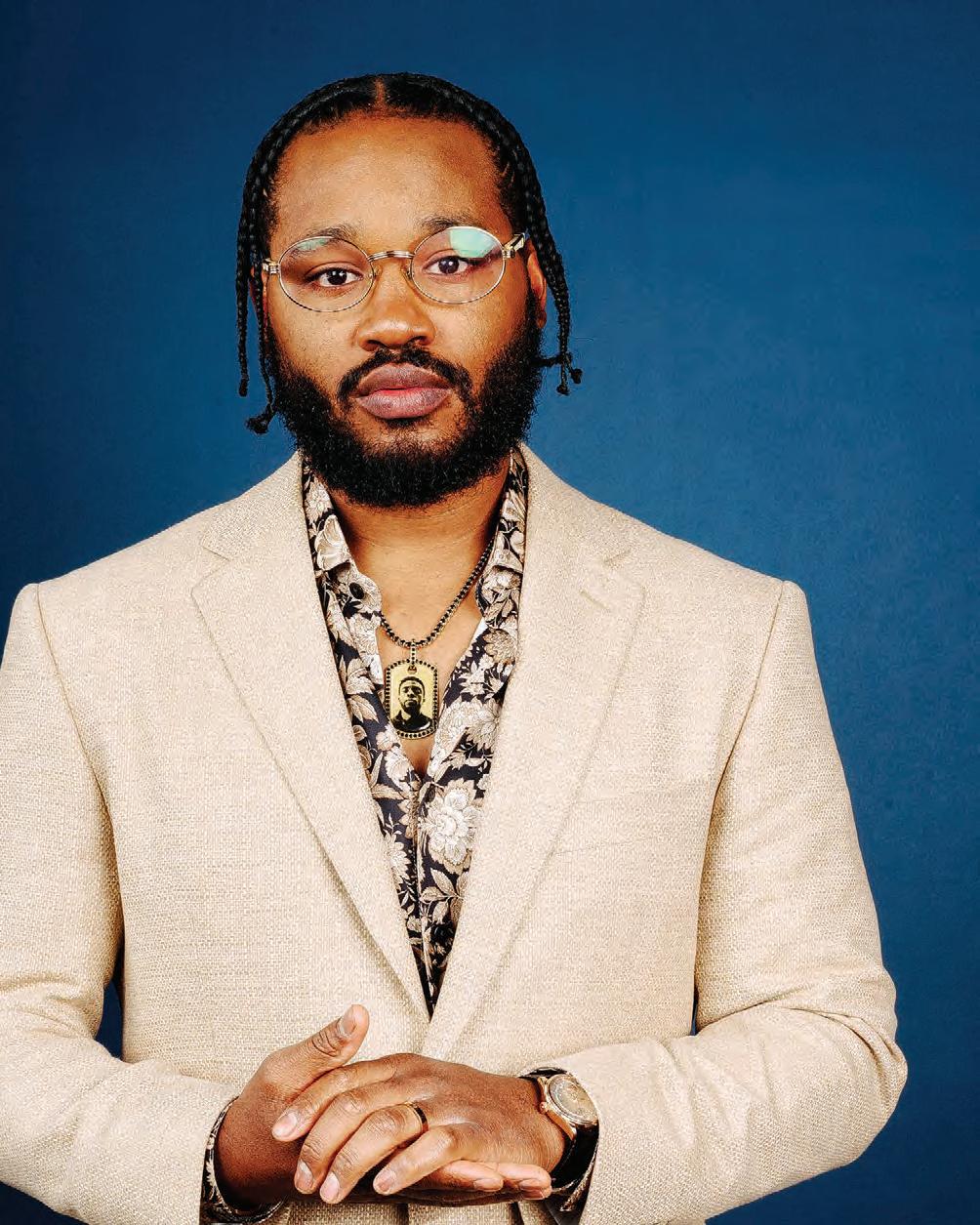
BLACK PANTHER: WAKANDA FOREVER
What were some of the biggest changes that you made after Chadwick Boseman’s passing that made the movie into what we see now?
I think the biggest change was the decision to have a different protagonist, and that was a really risky change. But we all knew Chadwick; he was very close to us. He and the character were very aligned for us all creatively, so it was the best way for us to move forward. And that change opened up the opportunity for us to make a film about a mother and a daughter. It became very clear to us that that would be the relationship that would anchor the film. It was a brilliant opportunity for Joe Robert Cole, my co-writer and myself, and all of my collaborators. We got really excited about making a superhero movie that was about motherhood: about a Black mom and a Black daughter.
Can you talk about the research that went into bringing authenticity to Wakanda?
I could talk about that for a long time [laughs]. I love to be a student, and the craft of filmmaking allows us to do that so often. We worked with a lot of consultants in the same way that we did on the first film. On this one, we went even deeper with African cultural consultants, but also we found a great Mesoamerican cultural consultant, a gentleman named Dr. Gerardo Aldana, who’s out of San Diego and is very familiar with the region. He’s an archeologist, an anthropologist, and he helped us create the glyphs for the writing system.
I learned a great deal, and a lot of it fit right into the mythology that we were building. —Valerie Complex
54 DEADLINE.COM/AWARDSLINE
MICHAEL BUCKNER FOR
DEADLINE

Kate HUDSON

GLASS ONION
Is it true you stalked Rian Johnson for the part of ditzy influencer Birdie Jay?
Oh, I did. That’s a true story. I knew there was an opportunity in this second Knives Out installment for a character that I might be right for, and I got a chance to read the script. I shouldn’t have read it, but I found someone who let me read it, and then I was like, ‘I have to get in the room with Rian.’ I love comedy, but it’s very rare that you read something that is so deeply funny and it’s all there. There’s nothing to add. The only thing I could bring was knowing I could step right inside of Birdie and ground her so that Birdie’s flamboyancy and insanity is, hopefully, a little bit more layered and likable. It’s just a dream for an actor, and I’m so grateful to have been given the opportunity.
Did you improvise at all?
No. Rian is a very specific writer-director. He wrote an incredible script. In fact, the thing with Birdie was that there were moments where everyone was like, “I can’t wait till we get to your line,” and the pressure on me was like, ‘Oh fuck! I hope [I can deliver]!’ But, to me, characters like that can just be fun, but you can also really dig into the physicality of them. It’s like being a dancer, and for someone like me, who really loves using their body, Birdie was a gift. I’ve never played anybody like that before.
—Pete Hammond
56 DEADLINE.COM/AWARDSLINE
DEADLINE
MICHAEL
BUCKNER FOR

Bitaté URU EU WAU WAU
BY MATTHEW CAREY
For young Bitaté Uru Eu Wau Wau, the violent chattering of a distant buzzsaw sends an ominous signal. It’s the sound of his people’s land in the Brazilian rainforest being chewed up by illegal invaders. The Oscar-contending documentary The Territory , directed by Alex Pritz, shows how Bitaté and members of his Indigenous tribe, the Uru-Eu-Wau-Wau, are attempting to fend off loggers, miners and squatters devouring huge tracts of the Amazon. Among their only means of defense is media attention to their plight. Without it, their territory will continue to disappear. Bitaté spoke with us through an interpreter from an Uru village in Brazil’s state of Rondônia.

What has it been like for you to be the protagonist of an Oscarcontending documentary that has been seen around the world?
I feel honored. It brings to the forefront the fight of my people. It displays for the world the situation we
58 DEADLINE.COM/ AWARDSLINE
The protagonist of The Territory talks about his experience making the documentary and the fight to save his Indigenous people’s land
★ ★ ★ ★ ★
NATIONAL GEOGRAPHIC/COURTESY EVERETT COLLECTION

live in. We know that the challenge that we face—that we have always faced in our territory—is being represented now to the world beyond Brazil. People are talking about it. So, I feel very good about that.
When the filmmakers first approached you about making a documentary, what were your thoughts? And how did you become convinced they would tell your story along with the story of the Uru in a way that would do justice to you?
At first, it was a big thing for us to digest: Americans coming—what do they want to do here? Throughout the colonization decades, we learned to be greatly concerned about this. And we wanted to know, what do they want from us? So, we had a number of conversations, three sitdowns where we talked with Alex [Pritz], with the producer Gabriel [Uchida], and our community. And then we decided, let’s see what happens as we move forward with this.
We began to understand that it was a chance for us to demonstrate our culture and the work that we do. I was able to overcome the resistance from my own community, from my people… We thought a lot about how we can show the reality of our people and of this territory. The Territory does a good job of representing who the Uru-Eu-Wau-Wau people are.
Can you describe the emotions you feel when you see parts of Uru territory consumed by these outsiders—the miners, the loggers, the illegal settlers?
Sad. We feel very sad. We see people come in tearing down all of our forests that we have fought to protect… We know [invaders], are going to come in and they’re going to kill our territory. They’re going to burn it. They’re going to take the timber out of it. And that makes us very sad as Indigenous peoples. We have fought so much to protect our territory, to keep it in good shape. So, it’s sad to see our home place deforested the way it is. It’s very sad.
Pritz told us the Uru urged him and his filmmaking team to seek out the land grabbers to interview them as well. Why was that important to you?
We thought it was important to know how the other side thinks, what’s going through their minds… These are issues we live with every day, and these are the things that happen. And we want it to be told that way.
You and other members of the Uru-Eu-Wau-Wau became part of the filmmaking process, learning to use cameras and drones. What was that like?
At first, we thought we were going to do some filming for them, but they’re not going to use it. And then, we got more and more feedback from them and we began to improve our abilities. And we understood this is on behalf of all Indigenous communities, all the Indigenous peoples. So, it was important for us to tackle the challenge of learning the technology. Technology, as I always say, is our weapon in today’s world. Learning all the different aspects of technology so that we could promote knowledge about the struggle we have here and about the reality that we live in that was important to us.
How much have you learned about filmmaking during the last few years of your involvement in making The Territory?
I think I learned a lot. I was a photographer already. I’ve always liked taking photos, and Tangãi [Uru Eu Wau Wau] also has grown a lot in filmmaking, and he films a lot throughout our territory, and that has helped both of us to grow. I have seen a great increase in my confidence in doing this kind of work. And I have so much confidence that I’m able to teach others to do it. I want to show the younger ones how to record, how a camera works and how to use drones also. We’re doing some good filming with drones, so my confidence is growing. I feel strengthened in that.
How big a difference does it make to you and the Uru to be able to tell your own story with video instead of relying on outsiders?
Moving forward, I believe we now can tell our own story without needing other people. We have the equipment to do it. We have enough people to tell the story. At the beginning, we didn’t know that for sure. We didn’t think that we would fit the bill. We thought that we would have a little part and give a few tips about this and that. But today, I say, no, our people can do this work without needing outsiders. Alex and his team played a fundamental role in equipping us so that we might be able to keep growing. And I’m very happy knowing we’ll be able to create the next storytelling about our people and history. I envision things that I can do with my people. We now know what it means to have a central role in a production. I think we can do this on our own now.
How optimistic or pessimistic do you feel about the future of the Uru-Eu-Wau-Wau?
A bit of both—optimistic and pessimistic. Especially with these invasions, we have mixed feelings. But I
think that maybe over the past four years, I’ve become more optimistic. With the next four years, we have this new government [under Brazilian President Lula da Silva]. We have [the Brazilian government agency] FUNAI, the National Foundation for Indians, [which] is very pro-Indigenous peoples. I will continue to be optimistic for now. But I will always be a bit ambivalent on that, feeling pessimistic and optimistic at different times. We live on a reservation, and we have these invasions. So, we have to balance both of those feelings.
I understand that the Uru are building an audio-visual center to help aid in the study of filmmaking. We hope that by February it will be ready for use… We hope that not only our people, but other Indigenous communities will be able to come in and benefit from this… people from other [Brazilian] states, from other places, can come here to learn about our territory and learn something about filmmaking. We feel a lot of gratitude for all that’s being done.
There are very few people who get the visibility that The Territory is bringing to us. If we can use The Territory as a documentary that communicates the situation of [the Uru], we want more and more of our peoples to have that opportunity.
What can people do to support you and the Uru-Eu-Wau-Wau?
We want to expose people to our reality so that our people can then see improvements in the life we live here; the situations we face. I also believe it’s important to get the word out about the documentary so that people will watch it and join the impact campaign on our website. That’s a way that they can go to the site and strengthen us and support us and increase their awareness of all that we are doing. We are also calling on the government of Brazil to protect all of our regions and our communities. We need help not only here in my community, but throughout all of our Indigenous territories. ★
60 DEADLINE.COM/ AWARDSLINE
We feel very sad. We see people come in tearing down all of our forests that we have fought to protect… We know [invaders], they’re going to come in and they’re going to kill our territory.

Carey MULLIGAN

SHE SAID
So much of what makes the film so affecting is you get a sense of how the story affected Megan Twohey and Jodi Kantor, the two women who broke the Weinstein scandal in The New York Times. What did you make of their journey?
Lots of capable journalists had tried to get the story, and I think that’s what’s so exciting about the film. When I read that first article I was shocked. It felt sort of seismic, but I didn’t think about who had written it. But I think what’s great about the film is that you’re seeing not just the investigation, which is laid out in the book, but also Rebecca Lenkiewicz, our screenwriter, worked with Jodie and Megan to see their personal lives, to see what they were dealing with at home. What I love is that this is a document of these two incredible women who made this historic achievement. But what was the unique connection between them that meant they were the ones that could do it? I think that’s what the film shows. They’re extraordinary journalists,
very skilled, and they’ve been doing it a long time. The combination of the two of them got it over the line.
How would you describe the atmosphere at screenings?
The whole way through, we all felt a big weight of responsibility to the survivors, and to Megan and Jodi obviously. The New York premiere was the first time we’d shown the film, and when Megan and Jodi came out it was like Bruce Springsteen had walked on stage. Everyone went crazy. And then Ashley Judd came on. She hadn’t walked the carpet beforehand, so no one knew she was there. Everyone was on their feet. There were lots of tears. It was unbelievably emotional for everyone. There were multiple survivors in the room. I think we owe such an enormous debt of gratitude to these incredible women. The film is really a sort of testimony to their courage, and, actually, the world would look pretty different if it wasn’t for these women. —Joe Utichi
62 DEADLINE.COM/AWARDSLINE
DEADLINE
MICHAEL
BUCKNER FOR
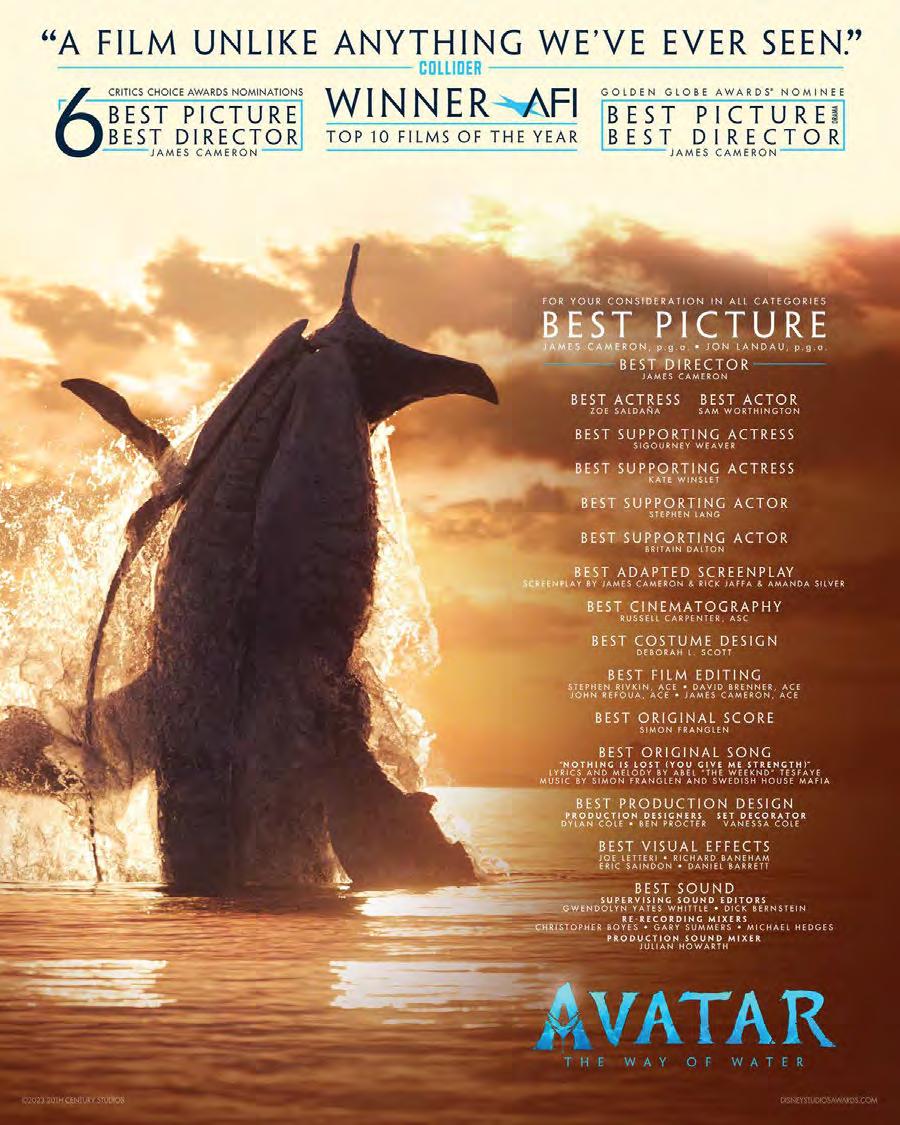
Sarah POLLEY

WOMEN TALKING
You’ve been in the industry a long time. How did you learn to protect yourself, and what did you learn as a director?
As an actor, I’ve had experiences of working with filmmakers who definitely prioritized the end product over the wellbeing of the people they were working with. I’m not actually sure that made their films better, and I think it’d be interesting to see, if they had behaved differently, would they have made an even better film? We sometimes embed the idea of genius in with bad behavior, and perhaps if we separated that out, we’d find that might actually be missing people’s actual potential. But I’ve also had the privilege of working with filmmakers who really did make the experience of the people they were working with really prominent in their minds, and I also saw them do great work. So that became a guiding principle for me: how do you create a safe and joyful nurturing space for people to do their work and take risks in?
And how has your experience affected the way you work creatively?
I’m not sure. I think probably a lot of those things are unconscious, but hopefully, you take the best of what you’ve seen and try to assimilate that and reject the things that caused you harm. More and more, having witnessed the filmmaking process so many times, it’s really interesting to see how much credit the director gets for other people’s ideas, and how comfortable everybody is with that. It’s such a collective process, even for filmmakers who pretend it isn’t. They’re stealing people’s ideas constantly, it’s part of the job. So I think one of the things I’m interested in is having a conversation about that and actually blowing open that process into a more public one where we talk about who thought of things that we didn’t, and how that benefited the filmmaking, because there’s this real cult of the filmmaker and it’s really based on theft. —Valerie Complex
64 DEADLINE.COM/AWARDSLINE
MICHAEL BUCKNER FOR DEADLINE

Paul DANO
 BY DESTINY JACKSON
BY DESTINY JACKSON
Steven Spielberg’s The Fabelmans is a semi-autobiographical account of the director’s upbringing, co-written with Tony Kushner. It’s a deeply personal film following Sammy—a proxy for the young Spielberg—a Jewish American boy who, after discovering a shocking family secret, uses his filmmaking dreams to explore the truth about himself and the world around him via the power of movies. In the film, Paul Dano plays Sammy’s father, Burt Fabelman, the fictional version of Spielberg’s father Arnold, a groundbreaking electrical engineer. Here, Dano reveals his deep research and close work with the director to capture the true essence of a life well-lived.
Steven Spielberg reached out to you personally about the possibility of playing his father in The Fabelmans. How did that go?
During the pandemic, I got a text saying, “Steven Spielberg wants to meet with you,” which is not a text you’re
expecting on your average day. It was nice to receive, but I was nervous about meeting him because I knew nothing about this movie. I looked up ‘unmade Steven Spielberg films’ to try and guess what he was making. Then we met on Zoom, and he was really
easy to talk to, which I was surprised by. I think sometimes we project onto people who are that culturally iconic, but he was very open to me and emotionally available and intuitive. He told me what this film was going to be about, and I had this immense feeling. In terms of what I saw in his eyes, his father had passed about eight months before we first spoke, and it was hard for me to process that in real-time. But once he told me about the idea, I felt very strongly about the project in terms of how I might meet the material, what I might have to offer, and how it resonates with me. And so we had a lovely conversation, and I felt great about our Zoom. Then I read the script, which I thought was beautiful, right from the first sentence describing the family waiting in line for the movie. And Steven and I talked again, and we both took notes with each other like our first little work session. And on the third Zoom, which was just Steven with an unlit cigar in his mouth, he said, “I think you’ll make my dad proud.” And then we officially started.
Was it the easiest audition process that you’ve ever had to go through?
No, because I really felt strongly about this part. I thought once I had spoken to him and he had said what it was, I just really—it’s strange to say this about somebody who’s one of the great film artists of all time—felt like this is such an important film for Steven. And wanting to be a part of this felt so exciting; waiting was hard. But I’m thankful, and yeah, the fact that I didn’t have to audition is lovely.
There’s a lot of discourse about how Burt’s personality could be interpreted as passive, especially in how he handles the affair between Mitzi and his best friend, Benny. It’s interesting that Burt and Sammy don’t ever confront each other about Mitzi, either. How did you interpret Burt’s position as a family man yourself? I always felt like he was somebody who felt deeply but didn’t always know how to express it. I also think he felt like he probably had to contain his own feelings because of what was going on in the family. So, I always looked at this as Mitzi and Sammy were the storm, and Burt was the grounding to that storm.
66 DEADLINE.COM/ AWARDSLINE
The Fabelmans star reveals the emotional connections he made in portraying a version of Steven Spielberg’s father
★ ★ ★ ★ ★
UNIVERSAL/COURTESY EVERETT COLLECTION
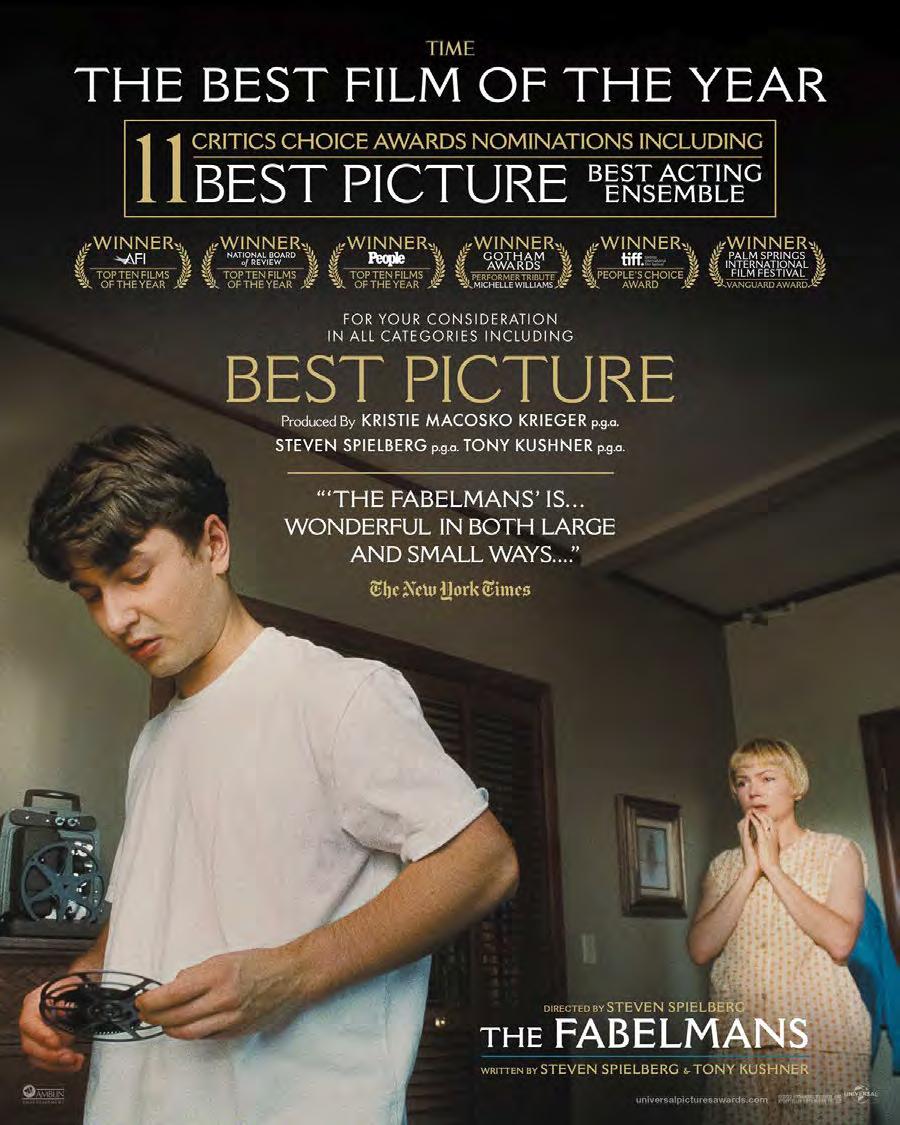
And I think it’s some combination of not being able to see or acknowledge or face the truth while also knowing and trying to contain it for the sake of his family. And ultimately, he does fall on his sword. Like, in the divorce scene, he tries to say that it is his decision; it’s not their mom’s fault. And it certainly wasn’t, but I think he was doing that for the sake of his family, and I think he did that because he still loved Mitzi.
What notes did Spielberg give you that helped influence your portrayal of Burt?
Steven and I spent quite some time talking about Arnold and Burt because it was Burt that I would be playing, ultimately. And the closer we got to filming, the more memories Steven was having. There would be ideas on the day on set, a memory, a gesture, or a word that he’d suddenly want to explore. One of the most important things for me was hearing a recording of Arnold talking about electronics being a way of life for him. He talked about a crystal radio he built when he was a kid; from then on, he was hooked on electronics. It was so much like Steven in the sense that movies are a way of life for him. Steven saw a movie and took a camera and that was it. I always saw this wonderful parallel there, which said so much about Arnold with the way his brain worked through engineering and electronics, much in the way that I think Steven works through movies.
We all had so many incredible resources on set, like, Steven’s family archives had 8mm footage that he shot as a kid, his family photographs and home video. And Arnold was an important figure in the world of computer engineering, so there’s a lot of information about him that you can find. He also served in World War II, and there was some long interview he’d done talking to veterans, so there was just a lot of take-in. I had to ask myself, ‘How do I take this and put it through Burt?’ because I couldn’t take everything in addition to the beautiful script. And on top of that, I don’t look
much like Arnold at all. But I noticed that his center of energy was in a different place than mine. So, looking at his trunk, for example, in a photo, I had the costume designer make me a weight belt that I wore just for the first week to help center my gravity lower. He just had a sturdier feeling connected to the ground. So, I loved having the inspiration of a real person. It’s really fun in a way to have all of that run through you [as an actor] as well, meaning I was letting Arnold into my life but letting Burt lead the way. I loved doing something similar for Love & Mercy, where I played Brian Wilson; there’s something so spiritual about it, weirdly.
What was the most challenging scene for you?
Well, there were many challenging scenes. I mean, certainly, the balance of what he sees and does not see between Mitzi and Benny because I think Steven was asking himself that as well. Meaning, as a kid, he couldn’t see it, but as an adult, you kind of realize, ‘Oh shit.’ But there were days like the divorce scene I talked about. Spending your day doing that? That’s a big scary day. I will say my favorite day was Burt’s last scene in the film because we shot that on the oneyear anniversary of Arnold’s passing. And it felt like a good special day to film such a beautiful scene, hopefully, for Stephen, too. Every day felt like a big day on a film like this. Every scene mattered and every scene had its own challenge.
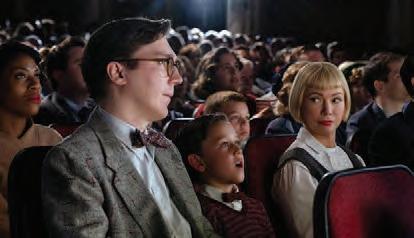
Throughout the film, Burt insinuates that Sammy’s passion for making movies should take the backburner to something more practical. How much do you relate to Sammy in that way? When did you start to take yourself seriously as an artist?
My parents supported my acting, but I think I’ve always been a bit more of a tortoise than a hare. I remember being young and having that desire to succeed. I remember going to audition after audition and what it felt like to get or not get a part. And I remember getting my first break and then that second break. I remember the hustling and meeting other young actors in these audition rooms. And it’s such a strange business as an actor because you’re freelance, especially when starting out, and you don’t have anything to do other than just constantly putting yourself out there. I remember being at my desk when I was around 18 and just being very casual, like, ‘Fuck. I really think I’ve got to do this.’ But I’ve had resistance to the idea before in myself, where I constantly asked, ‘Can I do this? Can you keep putting yourself through this?’ Because there’s a part of me that loves it, but I think it’s hard too. And every two or three years, I ask myself why I’m doing this, and I always re-choose to do it. And it’s incredible that so many people do it, and I certainly feel fortunate that I’m getting to do it now in a way that I want to and
that I feel really good about. I would say I’m still letting myself become the artist I hopefully want to be. And I think it took time, even though I started young. But that’s the journey. I’m sure everybody is different in how they come into themselves. But I think it’s one of the major parts of, well, probably any line of work, but really just becoming an adult is how you grow into yourself, how you accept yourself and be yourself. Because I think that’s where your best work will likely come from.
Having now worked with such esteemed directors and in such a wide variety of genres, these days how do you choose what films and roles you sign up for? What exactly wins the Paul Dano stamp of approval?
Well, I never know what I want to do next until it comes. So, the example of going from The Batman to The Fabelmans is just that I feel so lucky that I would get to do something so different. And it’s what made me excited about acting when I was young and watching other actors. Like, watching Kramer vs. Kramer and Midnight Cowboy and seeing [Dustin Hoffman’s performances in both], that for me is the magic trick. It’s like, ‘Wow, you made me believe. And then you made me believe again in a very different context.’ And speaking of Sammy and what The Fabelmans is about, it was seeing actors who could take you somewhere that felt like a character, a world, and a life. And that was a big goal with this one for me playing Burt. It was just, how do I capture a life lived? So, I love collaborating. You’re putting yourself in the hands of your director, the writer and the editor. And as an actor, hopefully, you’re lucky enough to be in a good group of people, which certainly makes the job better and easier. I also love when I can believe in the final product because I don’t just do this for me; I need to believe in what we’re all making as well. I hope I’ll get to continue to shake it up and follow the scent.
68 DEADLINE.COM/ AWARDSLINE
UNIVERSAL/COURTESY EVERETT COLLECTION
★ Dano with Mateo Zoryan as the young Sammy and Michelle Williams as Mitzi.
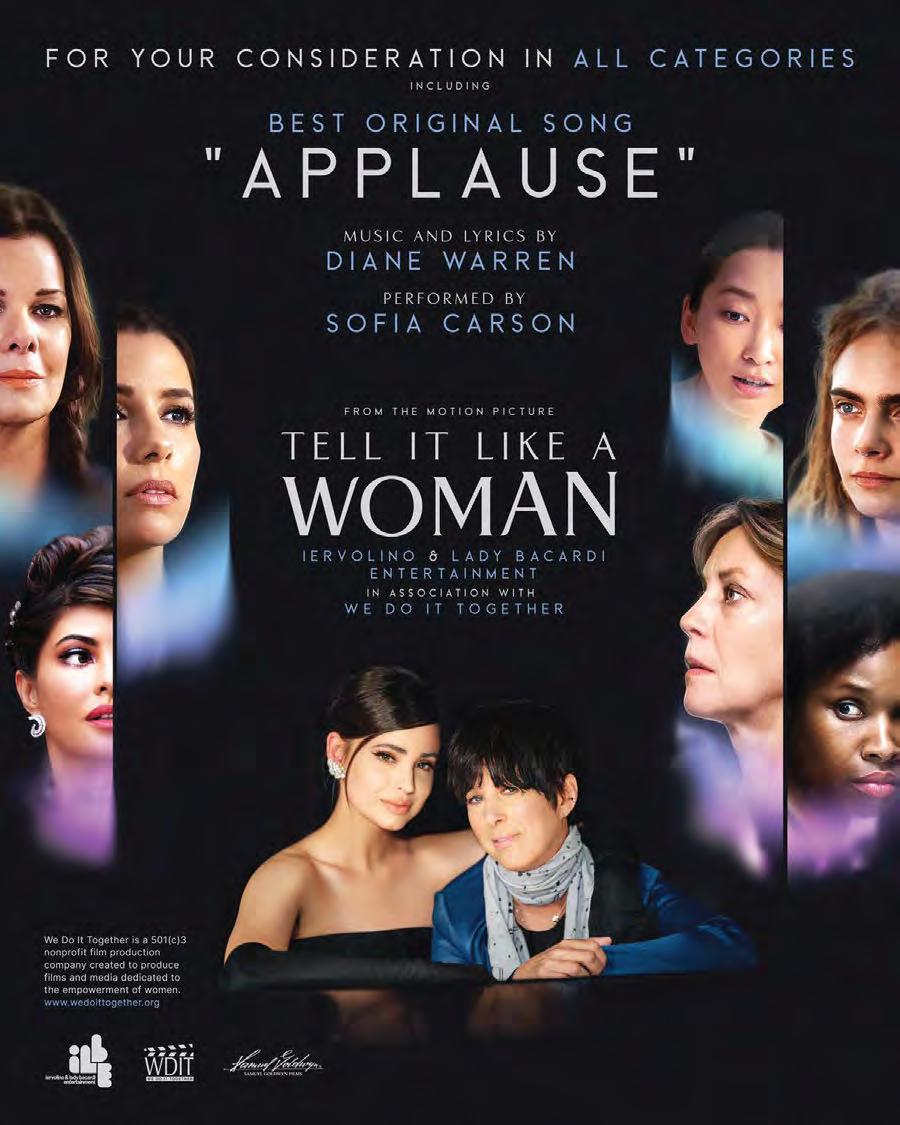
Chronicling History
Film Editors Terilyn A. Shropshire , Sven Budelmann and Conrad Buff on piecing together historical epics
 By Ryan Fleming
By Ryan Fleming
There is no shortage of epic stories found in history, born out of conflict and human resilience. This Oscar season has seen more than its fair share of historical epics, taking place all across the world.
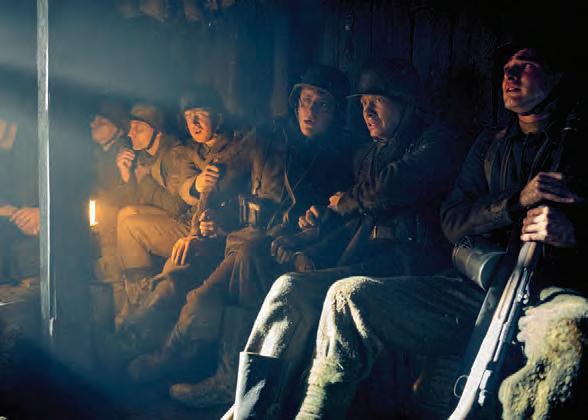
The Woman King takes a look at the all-female Agojie warriors from The Kingdom of Dahomey in 18th century Africa. Based on the 1929 novel of the same name, All Quiet on the Western Front shows a much less heroic side of war and the trauma faced by young men tricked into joining the German frontline. Emancipation is loosely based on the story of ‘Whipped Peter’, an escaped slave from Louisiana whose scarred image went global in the early 1860s.
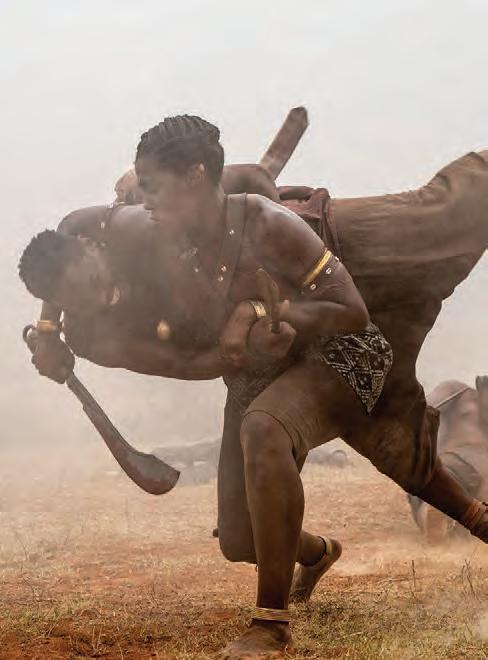
70 DEADLINE.COM/ AWARDSLINE
Film Editing
REINER BAJO/NETFLIX/APPLE/TRISTAR PICTURES/COURTESY EVERETT COLLECTION
All Quiet on the Western Front
The Woman King
Emancipation
The Woman King
Editor Terilyn A. Shropshire was thrilled when director Gina PrinceBythewood referred to The Woman King as “our” next movie. “That was music to an editor’s ears, when you hear ‘our’ instead of ‘my’,” Shropshire says. After hearing the story, she was excited by the chance to show an epic with a focus on a strong female character. “With Nanisca, there were levels of who she was when we were able to peel those layers away and show that vulnerability,” she says. “Often, I found myself wanting to bring the audience into those private moments with her. I try to serve the moments, because as an editor, you always have to be that audience to your film.” Showing that vulnerability is important when working on an “intimately epic” film, as Shropshire calls it, where you begin by building out the characters before the world. “If you can start with that and then build outward, it really does help the storytelling.”

One of the scenes that really sets the tone is at the beginning of the film when the Agojie warriors rise out of the tall grass. Shropshire says that scene was not originally scripted that way. “When we started to start to go in and really look at characters in the editing room, we decided the best way to bring the audience in was through a sense of mystery and discovery.” Before any of the characters were introduced, the women rise from the grass and attack, which establishes a tone for the warriors that allows the audience to start a journey of discovery.


The most important thing for Shropshire was to make sure the film was more of an epic than an action film. “Some of the greatest historical epic movies are really character-driven,” she says. She maintains that the best way to achieve that is through building the world out to be as historically accurate as possible. “Even the subtleties of being able to honor each person’s work, the production designer, the costume designer… they spent a lot of time researching this particular moment in time and it’s my responsibility, as part of the storytelling, to make sure that I’m also bringing the audience in not only visually, but viscerally to a world that they have never seen before.”

DEADLINE.COM/ AWARDSLINE 71
Clockwise from top: Nanisca (Viola Davis) seated next to King Ghezo (John Boyega); Agojie Warriors; Izogie (Lashana Lynch).
Nanisca leading her warriors into battle.
Film Editing
All Quiet on the Western Front
Whereas The Woman King told a story of triumph, All Quiet on the Western Front tells a very different story with its brutal depiction of young German troops in World War I. Editor Sven Budelmann was excited when director Edward Berger approached him for the film, but he also felt a great responsibility to get the story right. “Every German comes into contact with either the novel or the 1930s film adaptation during their school years,” he says. “However, I thought it would be important to make a new, modern version of it… The fact that the film is told from the German point of view, from the point of view of the losers, also means that it has nothing heroic about it. The whole thing is just excruciating and pointless. I think it’s important to keep showing how terrible war is and what it means to fight in a war, especially in light of the current world situation.”
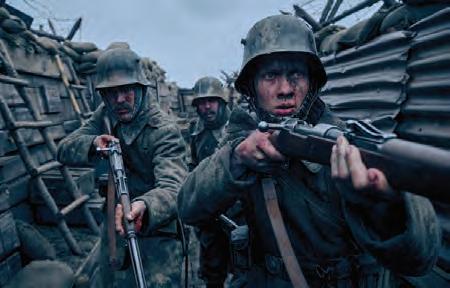
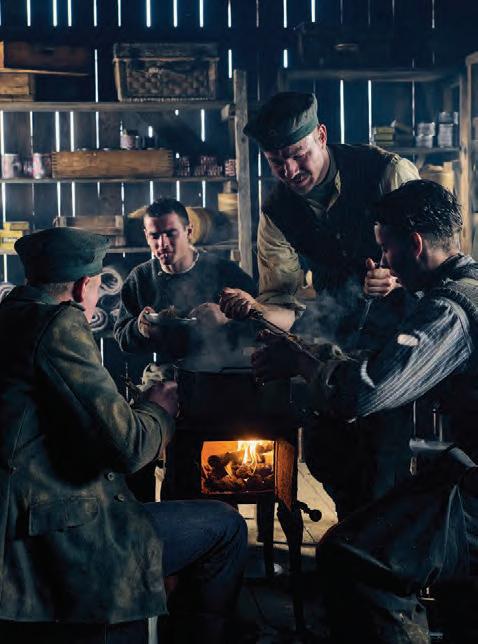
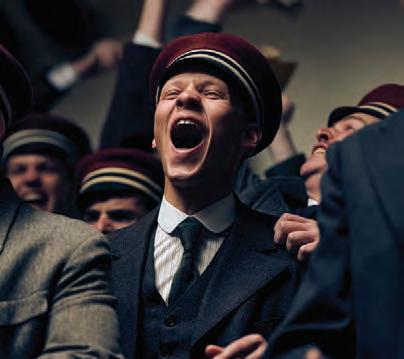
After some discussion with Berger, Budelmann decided to take an almost documentary-like approach to the editing, keeping the style observational while still creating an intimate view of the war through the eyes of the protagonist, Paul Bäumer (Felix Kammerer). During that time, young men like Bäumer joined the war voluntarily and were met with the terrible reality of battle. “We wanted the audience to experience reality as shockingly as Paul Bäumer did,” he says. “We wanted to show the brutality of war as authentically and brutally as possible. Not to make it sensational, but to make it real and tangible. The most important thing was not to make the film heroic. We wanted to show the war as it is—insane, brutal, random.”
The biggest challenge for Budelmann was to find the right balance between the “violence and moments of silence”, he says. “Otherwise it would have been too hard to bear.” Scenes of battle are contrasted with shots of nature to create moments of rest for the audience. That makes the impact of the violence even greater. One of the most impactful scenes of the film was a long shot where Bäumer stabs a French soldier with a knife and then witnesses his agonizing death. “As an audience, we enthusiastically follow him into the war, but we quickly realize what it means to be in the trenches and to fight on the battlefield,” he says. “For me this is the most intense scene in the film. When I saw the first take from the raw footage, I was truly affected and felt uneasy for hours after watching it. We didn’t want to spare the audience either, they had to experience the same emotional development that Paul goes through. That’s why we played out the scene in real time, without shortening anything.”
72 DEADLINE.COM/ AWARDSLINE
BAJO/NETFLIX
REINER
Top, Paul Bäumer (Felix Kammerer) excited to join the frontline; above, Bäumer and Stanislaus Katczinsky (Albrecht Shuch) in the trenches.
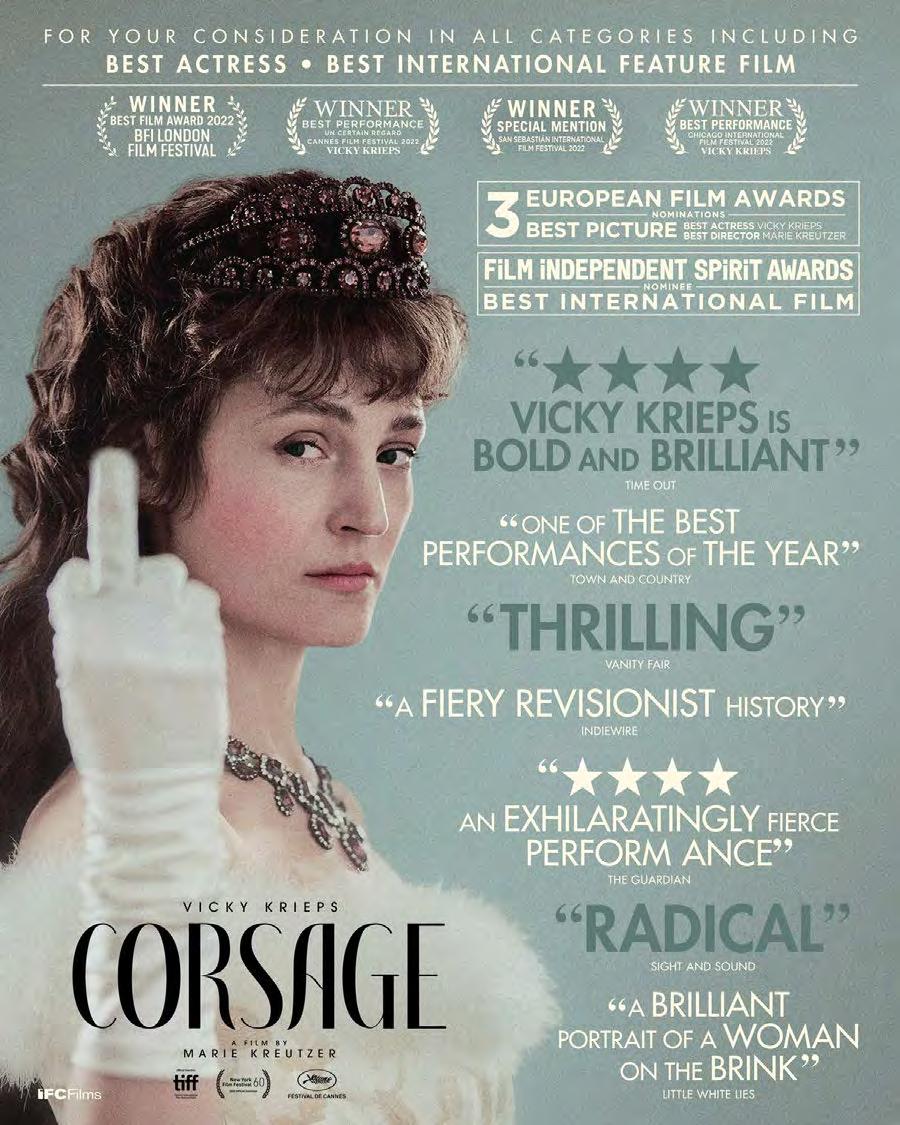
Film Editing
Emancipation
For Emancipation , director Antoine Fuqua relied on longtime collaborator Conrad Buff to edit the historical epic. While the film was being shot in Louisiana, Buff was working from home in California, which he believes allowed him to take a more objective look at the material. “Traditionally, the first pass for most editors is up to us to make the decisions,” he says. Fuqua gave him few notes before the first edit, which gave Buff a lot of freedom, especially in the second act. “There’s a certain absence of dialogue, particularly in the second act area where Peter (Will Smith) and the gang escape from Jim Fassel (Ben Foster) and the railroad camp, which turns into this pursuit.” Since there is little dialogue during the pursuit, Buff leaned into choosing which visual moments would have the greatest impact, and in which order. “There isn’t a roadmap, editorially. It was more documentary-like in that regard, up to me to tell a story.”


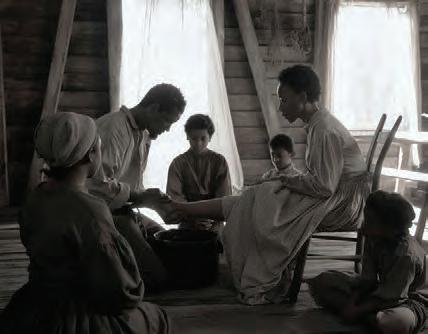
The chase through the swamp was also shot without sound, leaving Buff and the sound crew to create the Foley work for the setting. “Normally in any action sequence, the sound is frequently useless and
has to be recreated,” he says. “Because of the conditions of physically being in swamps, radio mics wouldn’t necessarily work while people are wading into the water.” While Foley work for this kind of film is normal, Buff says they needed to take it to a higher degree to create the subtle sounds of the environment. “The neat thing about it is that it’s not obvious work. It’s not like Top Gun where you are actually seeing jets flying. This is a quieter and a different kind of challenge to Foley… every branch, every footstep, every bit of cloth rubbing against a body all has to be built up. Our sound team was phenomenal in that regard.”
Although the story could call for gruesome scenes of violence, Fuqua opted to have the camera pull away from those moments and instead focus on how Peter reacts to the scene. “There’s such an intensity and sadness in those moments, and I don’t think Antoine was interested in getting any more graphic than what you see in the finished film,” he says. “It’s such an intense film and I’m quite happy that it was no more graphic than it was. It’s already so potent.” ★
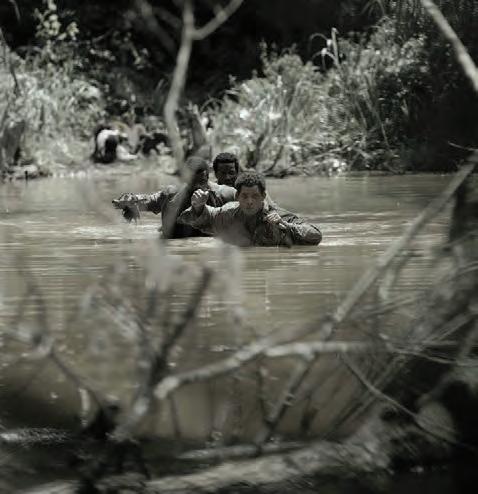
74 DEADLINE.COM/ AWARDSLINE
APPLE
Peter leads a group of escaped slaves through the swamp.
Peter (Will Smith) with his wife Dodienne (Charmaine Bingwa).
From left: Peter joins the Union army; Jim Fassel (Ben Foster) hunts for the escaped slaves.


Jeremy Strong & James Gray
15 No. DEADLINE.COM/AWARDSLINE 77
MICHAEL BUCKNER FOR DEADLINE
Based on
the director’s childhood, James Gray’s Armageddon Time tells the story of 12-year-old Paul (newcomer Banks Repeta), and how his Jewish family reacts to his friendship with a Black student, Johnny (Jaylin Webb), in early ’80s New York. Both boys share a love of space flight, and their pre-teen dreams take their imaginations light years away from their mundane lives. But the backdrop is a moment of tension, as Ronald Reagan, seeking the Republican Party’s nomination for president, stirs up civil unrest in the country. Paul’s father, Irving, played by Succession’s Jeremy Strong, despises Reagan’s dog-whistle provocations and screams at his image when he appears on television. But, he wonders, being from a vulnerable minority himself, is it wise for him to allow his son’s friendship to continue? Having followed the pair from Cannes to Telluride and now awards season, Baz Bamigboye pins Gray and Strong down to discuss the film’s very topical themes.
James, when did you first notice Jeremy, and when did you know you wanted him to play Irving?
JAMES GRAY: Well, after I Zoomed with him. I didn’t know who he was, and then my wife was telling me how great he was, so I wanted to catch up.
JEREMY STRONG: James doesn’t watch anything from the last, like, three or four decades…
You don’t watch TV?
GRAY: That’s not true! I watch movies. I just don’t watch a ton of television. Not out of snobbery. I want to be clear about that because on TV, there’s some great stuff. But, as I’ve said before, I’m trying to be an expert in at least one thing in my life. So I watch a lot of old movies because I think that’s the basics, the rudiments of the history of it. And so I don’t really want to dedicate 60 hours of my life to The Wire, which I hear is a masterpiece. I’ve never done it. It’s overwhelming to me to watch a billion hours of television, you know? I feel that a movie is one hour and 48 minutes. It’s really that.
STRONG: It was apparent to me in our Zoom—I could just feel, as one can—that he wasn’t really
familiar with my work.
How did that lack of familiarity express itself?
STRONG: It didn’t express itself in any sort of explicit way. It was more a sense that one gets. So I had to figure out a way [to impress him], because I really wanted to do this with him. And he was looking at other actors—some great, great actors who are friends of mine—to do this. And I wrote to him, saying I felt I had this character in me. His capacity for love, his incomprehension, his feelings of inadequacy, his goofiness, his rage, all those things I felt I had within me, and I recognized them from experiences in my own life.
The character is described as “a Jewish Stanley Kowalski with a Ph.D.”, which is really an incredible and vivid description, but also a gauntlet to throw down. I remember thinking, ‘I don’t know if I can do this,’ and at the same time, ‘I have to do this.’
So, James, what were you seeing from your end?
GRAY: My wife said he was great, and my wife has fantastic taste. When she says to me, “This actor’s
great,” it’s 99.9 percent certain that the person’s excellent. and that’s why I thought, ‘Well, I should do this Zoom.’ What I saw was that he liked me a lot, so immediately, I thought he was intelligent. [Laughs] Joking aside, I thought he was great. I mean, he was so smart. He had such a fantastic ability to understand human beings, you know? And he quoted something. I don’t even remember what, but it sounded all fancy and way smarter than I am, which is great. You always want to surround yourself with people who are smarter and more interesting than you.

He had passion for the part, and he understood it. I feel that when you work with an actor, if they get it, what you’re trying to do, and they’re not asking for more scenes, usually, it’s a pretty good indicator that they’re going to do a great job. So that night, I went and watched the first three episodes of Succession, if memory serves me correctly.
STRONG: I don’t know if you remember this, James, but I was in Denmark at the time. I have a house about an hour outside of Copenhagen, in this fishing village on the ocean, but I don’t have Wi-Fi there, so I had taken the train into Copenhagen to Zoom with you. I told you that, and you were like, “Why on earth would you take the train to Zoom with me?” [Laughs] I’m glad I took that train.
So James, what’s going through your head as you are watching him in Succession? Are you thinking, “OK, is this the right thespian to portray a character based on my father?”
GRAY: When I look at actors, I never, ever think, ‘Hmm, is the actor right for the part that I have in my head?’ I think that’s a very dangerous approach. What I look for is their total commitment to whatever they’re doing in the work. To me, the process is that the actor is completely dedicated, and that’s how you get an organic surprise. In other words, the actor is doing things you committed to and are consistent with the character that you and he or she or they have talked about. But it’s about moving past that, you know? The actor shouldn’t be doing exactly what I predicted they should do two years before. That’s not interesting. That’s crap. So what I look for is the dedication of the actor to the work.
Jeremy, from your standpoint: was there anything else that you did to prepare for that first Zoom?
STRONG: If anything, I experienced a profound doubt that I was capable of what this role required, and at the same time, there was just a counter-force in me that felt a need to move toward that feeling, if that makes sense. And it’s the intersection of those two things that’s the most fertile creative ground I’ve always sought for the kind of relationships in which an actor and a director have parity in terms of process and the way they feel toward the work. And James is a director that I hope I get to work with
78 DEADLINE.COM/AWARDSLINE
FOCUS FEATURES/COURTESY EVERETT COLLECTION
From left, James Gray and Jeremy Strong collaborate on set.
for the rest of my life, because I know what we could make together.
I feel more and more that a script, even a great script, is essentially a blueprint and that you are embarking on a voyage of discovery together. And the thing is only as good as the discoveries you make in the process. So that requires both being intrepid about it but also being open. And one of the incredible things I discovered about James, for someone who’d written a very, very precise script, is how open he was. One of the first things he said to me was, “Whatever you do, don’t nail it.” I can count on one hand the great directions that I’ve gotten from theater directors and film directors that have stayed with me my whole life, and that’s certainly one of them. James is in the tradition of those great filmmakers who are looking for moments that catch fire and moments of unexpected truth.
So James, when did you say, “OK, I want this actor to be in my film?”
GRAY: Right after the Zoom.
STRONG: Really?
GRAY: Yeah, because when you see that level of commitment and passion in an actor, it almost never translates to mediocre work. I’ve never encountered that. Maybe that case can exist. Maybe there’s somebody like Eve Harrington, who wants the part so bad and pretends, but I’ve never had that. When I see an actor who’s that committed and that interested, it’s going to translate because the person is open and committed.
That’s everything in acting, you know? Is the actor willing, and is the director willing, to explore, talk, think, take risks, and not do the opposite of why we got into the business? Let me explain this to you because it’s actually, weirdly, one of the more tricky and more important concepts: 99.9 percent of all actors and directors got into the business because, in the high school play, they wanted all the ladies in the back row to love them. I understand that impulse. And yet, when we finally get to set, it’s the exact opposite of what we need to do. The exact opposite is to ignore the ladies in the back row and to focus on getting rid of the need for approbation or admiration—to be honest to yourself in the moment and to be willing to be disliked. That’s
It doesn’t engage me with what it means to be a human being.
STRONG: It’s true what James is saying about the reasons that many, many of us sort of start doing this, which is about a form of self-presentation that might get you some kind of validation from others. Or just simply to be liked or to belong. And ridding yourself of those needs is important so that you can be unfettered, free, and open. So, for me, when a director calls action, it’s in a sense about robbing yourself of skill and security and entering a place that’s quite perilous. And you have to do that through character. That’s where craft comes in. You have to take your cool kid suit off.
The thing I love about this movie is that almost every day, I see things that seem to relate to it. Even watching Meghan Markle and Prince Harry’s documentary on Netflix talking about the unconscious bias of the royal family…
GRAY: Well, that’s a good thing, I think. I mean, it’s not really the job or the function of artists, if I may call us that, to offer you a positive view in the face of everything that is in the world. It’s our obligation to convey to you how we see the world, how we feel that it was or is and not what it should be. That’s a very important distinction. And we have a job to confront things with honesty. Class and race, all these things go into the soup of what it means to be a human being today. There are things that are really unpleasant that we have to confront. I don’t think it serves us well to avoid them at all or to give easy answers.
Tell me about the kind of conversations that you had with Jeremy to place him in your story.
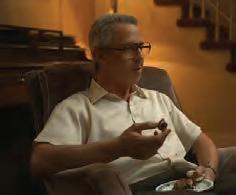
GRAY: Jeremy will confirm this. While we were shooting, I didn’t talk that much, with the exception of some adjustments to certain scenes. The job of the director, I think, is to help the actor realize their beauty and greatness and talent. It’s not my job to tell the actor, “This is what you have to do.” My job is to help them live and be beautiful.

So I resist saying, “Here’s what I want.” That’s not what I’m after. Once I’ve cast the thing, my attitude is always, ‘How can I help the actor be their best?’ Because I’ve already made risk. That’s art.
STRONG: To be willing to be disliked and willing to make a fool of oneself.
GRAY: Yeah. You need that because the art that lasts is the stuff that really asks us to engage in some of our more embarrassing or unsafe qualities, because that’s what makes us human. You know what’s not human? You see an ad for, like, Victoria’s Secret. It’s very nice, but it’s not a work of art, really.
the decision to cast that person. Jeremy would probably be able to answer this better than I would. He asked me a lot of questions, and I don’t know how satisfactorily I answered them [laughs] but once the guy was in the picture, it was his job to get beautiful and find it.
STRONG: I’ll say I’ve played a lot of characters who were based on real people, many of them living people, so I’m used to the process of saturating yourself with everything you possibly can from the template of the real person and then making it your own. In this case, I never felt a greater challenge or responsibility in my life because this person was real and because it was the filmmaker’s father.
Finding a way in was imperative, and I was really in despair of it because, initially, I don’t think James wanted to share very much. I think he felt, like, “It’s on the page and I don’t want you to do some kind of portraiture or imitation of my parents.” I became like a detective, obsessed with finding clues. And so I got on a plane with a tape recorder, went and found James and started that process of just plying him with a million questions.
James, why were you so resistant to participate in Jeremy’s desire to learn more about the character he was going to be playing? What was your hesitancy there?
GRAY: The answer always must come from the actor. The director is not giving answers. The answer is within the actor. The actor is conveying The actor’s job is not to act. It’s one of the great wrong terms ever. The wall must come down between the actor and the character. If the answers are coming from me, it means the actor is not finding it within him or her or themselves. So I don’t give answers to the actor. The actor must find the answers. It’s my job to ask the questions if I think they need help to get to that answer themselves. If I’m giving them the answer, that means it’s a real problem. I mean, I guess I gave
DEADLINE.COM/ AWARDSLINE 79
Left, Strong as Irving Graff; above, from left, cinematographer Darius Khondji and director Gray on the Armageddon Time set.
the answers to the kids. But they’re 12, you know? It’s a very different language.
STRONG: I agree with James. Every time you play a character, it’s like you’re building a new instrument that’s never existed before, and then you have to learn to play it. And only once that instrument has been built and learned can you answer your own questions.
What do you think, both of you, the film says about America today? I know it’s set in the 1980s, but it does speak to so much that’s going on now. For example, when Donald Trump had dinner in Florida with a white supremacist, I thought of your
movie and the scene at the school with Trump’s father, Fred Trump… GRAY: Well, first of all, thank you. But what do I think it says about today? You know, nothing comes from nothing. It’s like history has very complex threads, and you can never get to the bottom of it. To try is folly, but that doesn’t mean you don’t try. You and I look at the world today and what we see is an unendingly complex situation that has been handled excessively poorly by our institutions. And it’s our job to point out how difficult it will be to unpack those things. It’s basically as simple as that.
Every time I buy a Nike shoe or a sneaker of any kind, I’m contributing to a brutal capitalist system in which the person who made my shoe is probably oppressed in the most vicious fashion. There is no action that we can take that is without a component of ethical and moral compromise of some kind. And it’s incumbent upon us, since we can’t live a clean existence, to know this and to work as hard as we can to make the world a better place. To contribute just a little bit to this mountain of endeavor that we call progress.
So there are two alternatives, right? The first is to make art, which expresses this in all of its complexity. And the other is to bury your head in the sand and think that the best version of this solution would be to simply focus on the life cycle of Captain Marvel. There isn’t really a third path, I don’t think, at least not that I’ve discovered. I prefer the one that engages with what is actually going on in the world and acknowledges its many layers. Not the one that tells me a whole bucket of bullshit. And this comes down to something really as simple as that. Knowing what is going on in the world, are you awake to it, or is your head buried in the sand? And are you doing a corporation’s bidding without knowing it, or aren’t you? We all have our ideological box. You can’t get out of it. But what you can do is say, ‘This is my box; this is where I am. What can I do to do better?’
STRONG: That’s so beautifully said. I guess one of the things that struck me so powerfully when I first read the script was the way in which this moment in 1980 was an inflection point in this country’s
history, a moment where the social and political, and racial divisions that have now widened into unbridgeable gulfs were the fault lines of those things existing in that schoolyard. He found the locus of those things in that schoolyard in a moment where a kid chooses avoidance and social acceptance over integrity and moral courage. He’s a kid, but we’re all indicted by that moment. And I certainly feel indicted by that moment, all the ways in which in my life I have failed, in that moment, to act with courage or integrity or ways in which I’ve averted my gaze.
Complicity is really the insidious thing that perpetuates all of these systems, and the complicity here is not even malevolent on the part of the family; it’s just systemic. This is a Jewish family who has known persecution. And in this father has a very primal will to survive, to protect his children. There’s a kind of Darwinistic survival mechanism going on. And, at the same time, that has catastrophic costs for Johnny. His dream is completely expendable to the father but also to society.
GRAY: There’s one last thing I would add. Sometimes you hear people say, and not just about this movie, “Oh, is it about white guilt? Is this a white guilt movie?” And, really, what’s important to emphasize, it’s not about white guilt.
The whole idea behind it is that not only does the main character kid fail, but he benefits in some way. It works out really well for him. There’s something else going on when that happens. As Jeremy put it, the lack of acknowledgment of Johnny’s dream is not the movie throwing that character under the bus, so to speak. [Society

is] throwing him under the bus, not the movie. Which is a very big distinction, because it’s incumbent upon people to see past the ideas that corporations don’t want us to see or know about. They want artists and people writing about art to fight each other, because that is the way that they can actually seize more control for themselves.
But you know what James Baldwin said? When he wrote The Fire Next Time [in 1963], he said that in this “water wheel”, as he called it, this big economy that was new in the post-war era, it was incumbent among reasonably conscious whites and reasonably conscious Blacks to join together like lovers, in his words, to forge an understanding and an awareness and a consciousness. I wanted to say this because it’s very important, given Johnny’s dream, that the movie’s point is that they throw him under the bus. It’s not just some random thing I threw in [as a writer] because it’s my attitude is that his dream doesn’t matter. This, to me, is the prevailing sadness of the story.
That the dream mattered and it still matters. Well, look, we could talk for many hours about this in a way that we probably couldn’t about the Marvel movie…
GRAY: I didn’t mean to shit on that movie!
No, I understand that. But what I’m going to say is that there’s something that’s happened in our popular culture that we seem to want everything to end happily. And life just is not like that. And it’s very rare for me; I see plays and movies every day of my life, and it’s very rare for me to see honesty. Painful honesty.
GRAY: Well, that’s the idea. That was why I got to this thing about white guilt. There’s no lesson learned, so they don’t solve the problem at the end and become better people. No, this is not what our function is. And that doesn’t mean the movie is endorsing it. The movie is not endorsing unhappiness; it’s saying, “This is what we grapple with, and it’s our job to show this to you with as much honesty as we can muster.” That is our job.★
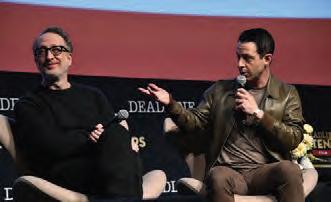
80 DEADLINE.COM/ AWARDSLINE
Above, Strong with Anne Hathaway, who plays his wife Esther; left, Gray and Strong.
FOCUS FEATURES/COURTESY EVERETT COLLECTION/ALBERTO RODRIGUEZ/DEADLINE VIA GETTY IMAGES

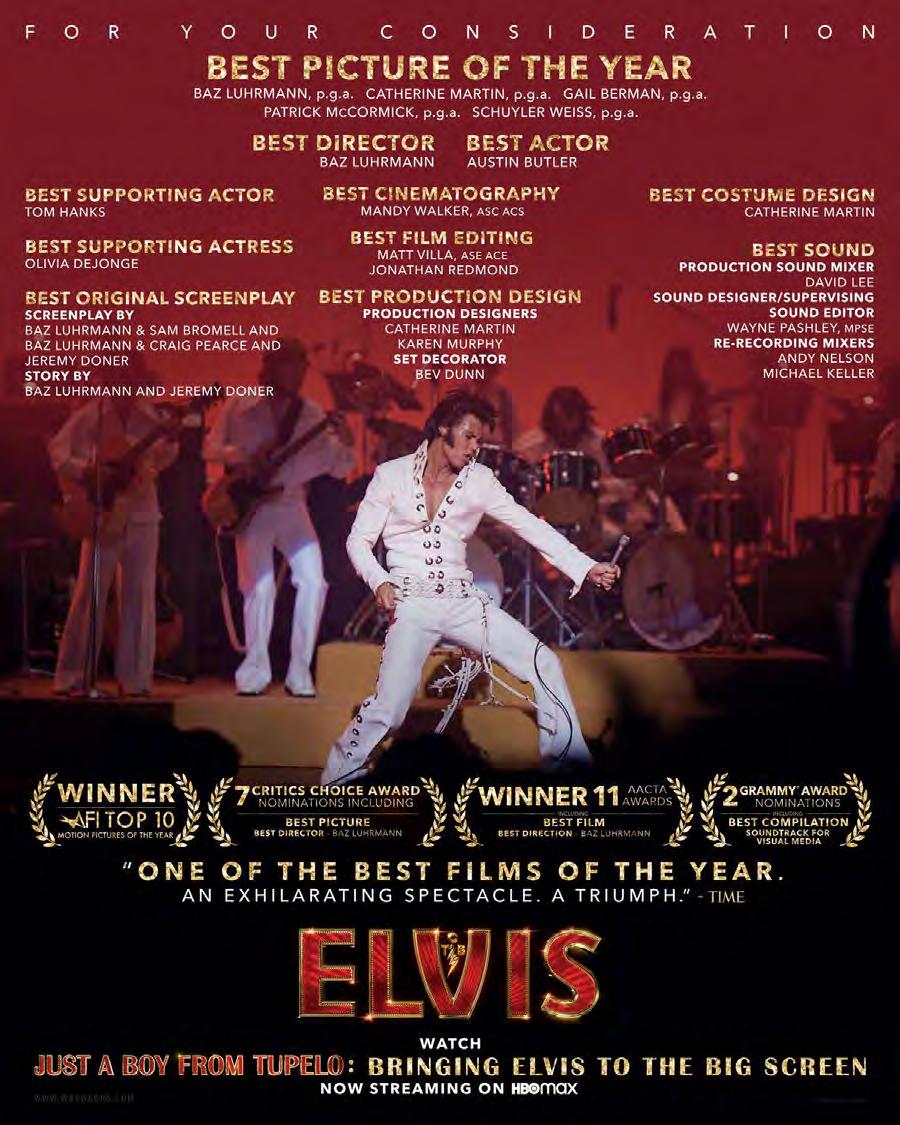





 By Baz Bamigboye
By Baz Bamigboye


















 By Damon Wise
By Damon Wise




































 BY JOE UTICHI
BY JOE UTICHI




























 BY DESTINY JACKSON
BY DESTINY JACKSON



 By Ryan Fleming
By Ryan Fleming






















